Design of additive manufactured lattices with graded porosities
VerifiedAdded on 2022/11/13
|37
|10361
|2
AI Summary
order id 991089
in continuation of this, i need an advanced report on the same topic which is used in this order
Topic name: Design of additive manufactured lattices with graded porosities for dental implants
format should be this and addition according to content and words.
ABSTRACT i
ACKNOWLEDGMENTS ii
TABLE OF CONTENTS iii
LIST OF TABLES iv
LIST OF FIGURES v
NOMENCLATURE vi
ABBREVIATIONS vii
CHAPTER I: INTRODUCTION 1
CHAPTER II: Literature Review 3
Section Header (heading 2) 4
Sub heading (heading 3) 4
Sub-sub heading (heading 4) 4
Equations 4
Tables 5
Figures 6
CHAPTER III: METHODOLOGY 8
CHAPTER IV: RESULTS 9
CHAPTER V: MORE HEADING 10
CHAPTER VI: CONCLUSION 11
REFERENCES 12
Appendix A: HEADING 13
Contribute Materials
Your contribution can guide someone’s learning journey. Share your
documents today.
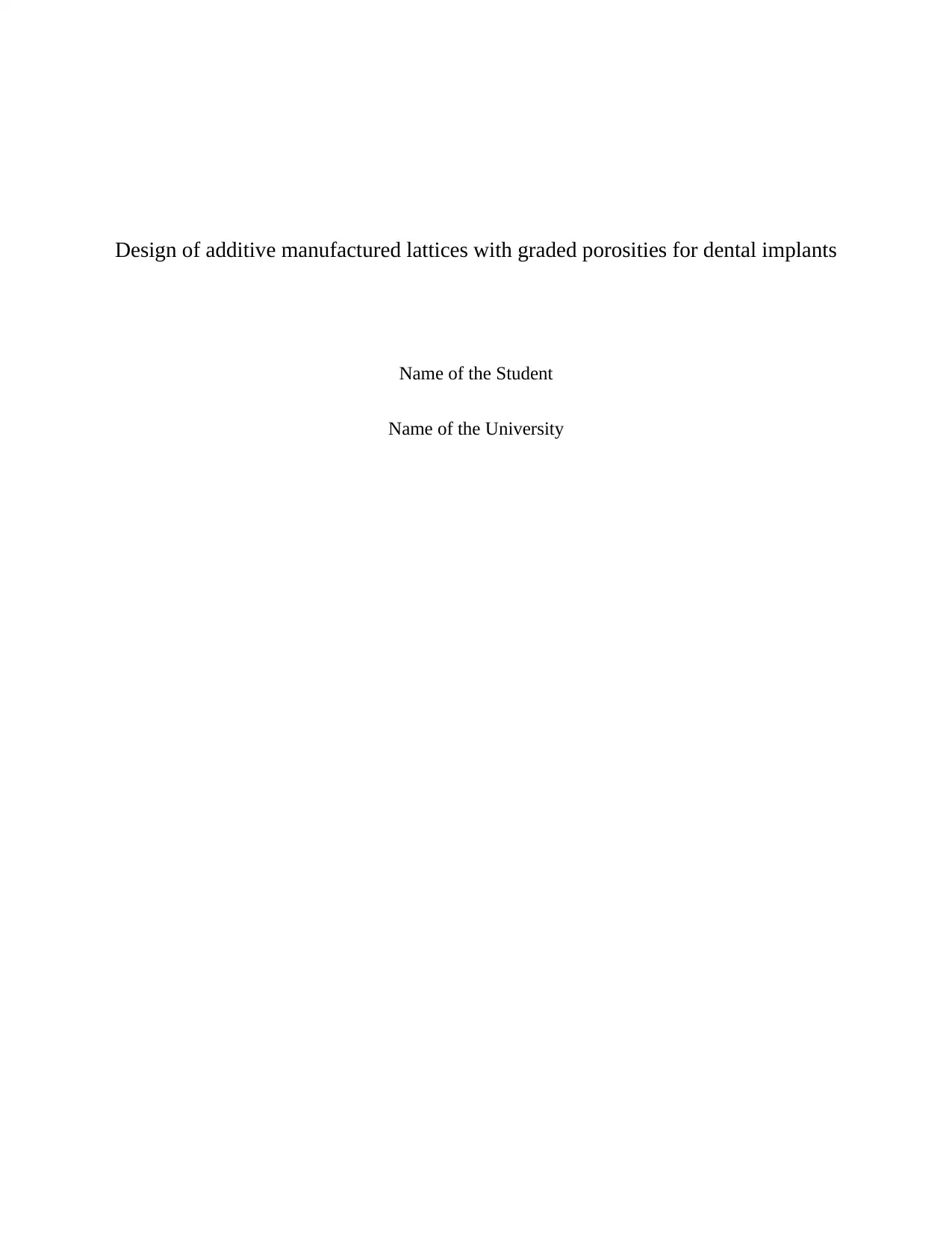
Design of additive manufactured lattices with graded porosities for dental implants
Name of the Student
Name of the University
Name of the Student
Name of the University
Secure Best Marks with AI Grader
Need help grading? Try our AI Grader for instant feedback on your assignments.

Table of Contents
Chapter 1: Introduction....................................................................................................................4
1.1 Background.......................................................................................................................4
1.2 Aim, Objectives and Research Questions.........................................................................7
1.3 Research Structure............................................................................................................7
Chapter 2: Literature Review...........................................................................................................9
2.1 Dental Implants......................................................................................................................9
2.2 Design Optimization of Dental Implants.............................................................................13
2.3. Lattice Structure ..............................................................................................................17
Chapter 3: Research Methodology................................................................................................22
Chapter 4: Data findings and analysis...........................................................................................26
4.1 Qualitative Data analysis.....................................................................................................26
Chapter 5: Conclusion...................................................................................................................31
5.1 Conclusion...........................................................................................................................31
5.2 Future Work.........................................................................................................................32
References......................................................................................................................................34
Chapter 1: Introduction....................................................................................................................4
1.1 Background.......................................................................................................................4
1.2 Aim, Objectives and Research Questions.........................................................................7
1.3 Research Structure............................................................................................................7
Chapter 2: Literature Review...........................................................................................................9
2.1 Dental Implants......................................................................................................................9
2.2 Design Optimization of Dental Implants.............................................................................13
2.3. Lattice Structure ..............................................................................................................17
Chapter 3: Research Methodology................................................................................................22
Chapter 4: Data findings and analysis...........................................................................................26
4.1 Qualitative Data analysis.....................................................................................................26
Chapter 5: Conclusion...................................................................................................................31
5.1 Conclusion...........................................................................................................................31
5.2 Future Work.........................................................................................................................32
References......................................................................................................................................34
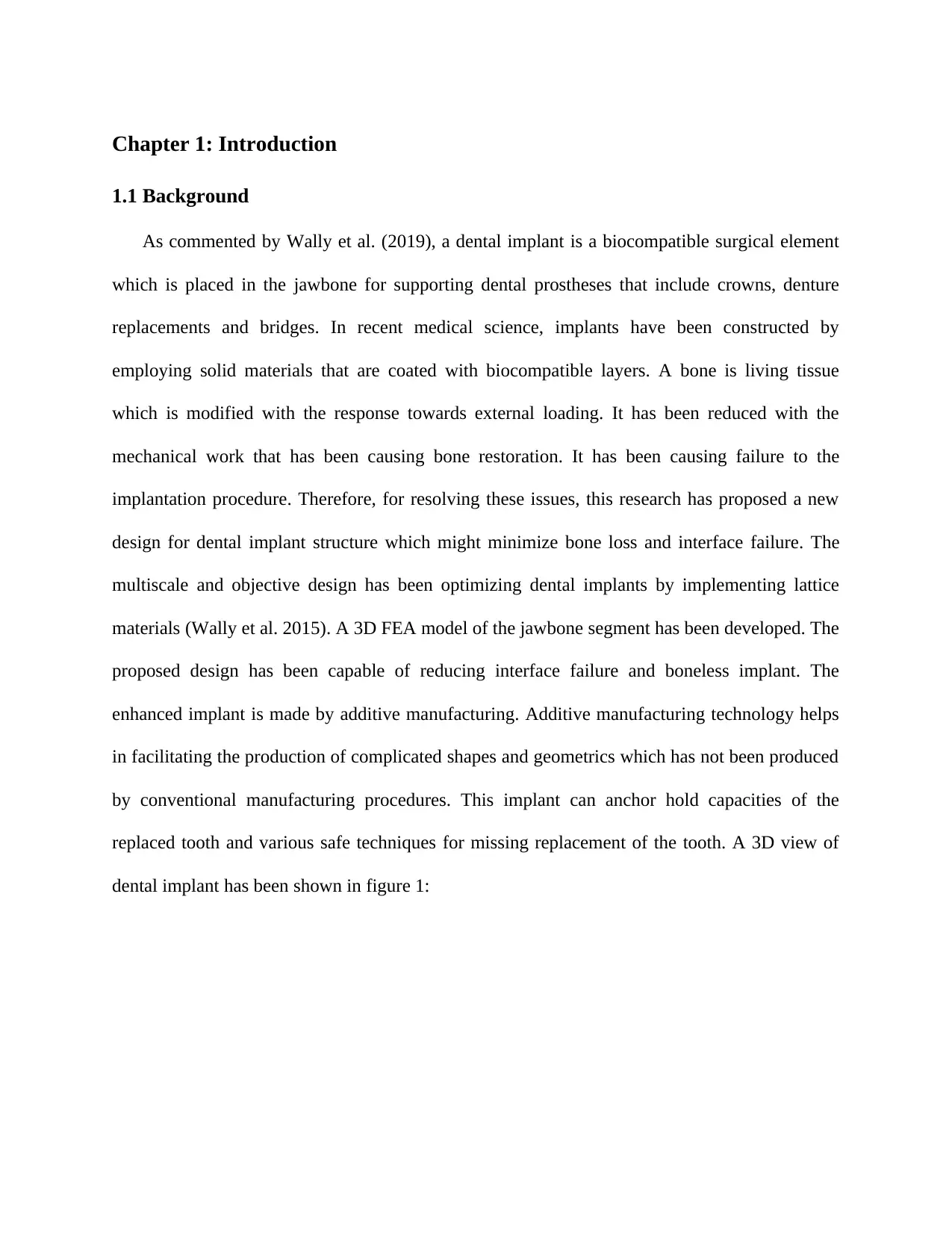
Chapter 1: Introduction
1.1 Background
As commented by Wally et al. (2019), a dental implant is a biocompatible surgical element
which is placed in the jawbone for supporting dental prostheses that include crowns, denture
replacements and bridges. In recent medical science, implants have been constructed by
employing solid materials that are coated with biocompatible layers. A bone is living tissue
which is modified with the response towards external loading. It has been reduced with the
mechanical work that has been causing bone restoration. It has been causing failure to the
implantation procedure. Therefore, for resolving these issues, this research has proposed a new
design for dental implant structure which might minimize bone loss and interface failure. The
multiscale and objective design has been optimizing dental implants by implementing lattice
materials (Wally et al. 2015). A 3D FEA model of the jawbone segment has been developed. The
proposed design has been capable of reducing interface failure and boneless implant. The
enhanced implant is made by additive manufacturing. Additive manufacturing technology helps
in facilitating the production of complicated shapes and geometrics which has not been produced
by conventional manufacturing procedures. This implant can anchor hold capacities of the
replaced tooth and various safe techniques for missing replacement of the tooth. A 3D view of
dental implant has been shown in figure 1:
1.1 Background
As commented by Wally et al. (2019), a dental implant is a biocompatible surgical element
which is placed in the jawbone for supporting dental prostheses that include crowns, denture
replacements and bridges. In recent medical science, implants have been constructed by
employing solid materials that are coated with biocompatible layers. A bone is living tissue
which is modified with the response towards external loading. It has been reduced with the
mechanical work that has been causing bone restoration. It has been causing failure to the
implantation procedure. Therefore, for resolving these issues, this research has proposed a new
design for dental implant structure which might minimize bone loss and interface failure. The
multiscale and objective design has been optimizing dental implants by implementing lattice
materials (Wally et al. 2015). A 3D FEA model of the jawbone segment has been developed. The
proposed design has been capable of reducing interface failure and boneless implant. The
enhanced implant is made by additive manufacturing. Additive manufacturing technology helps
in facilitating the production of complicated shapes and geometrics which has not been produced
by conventional manufacturing procedures. This implant can anchor hold capacities of the
replaced tooth and various safe techniques for missing replacement of the tooth. A 3D view of
dental implant has been shown in figure 1:
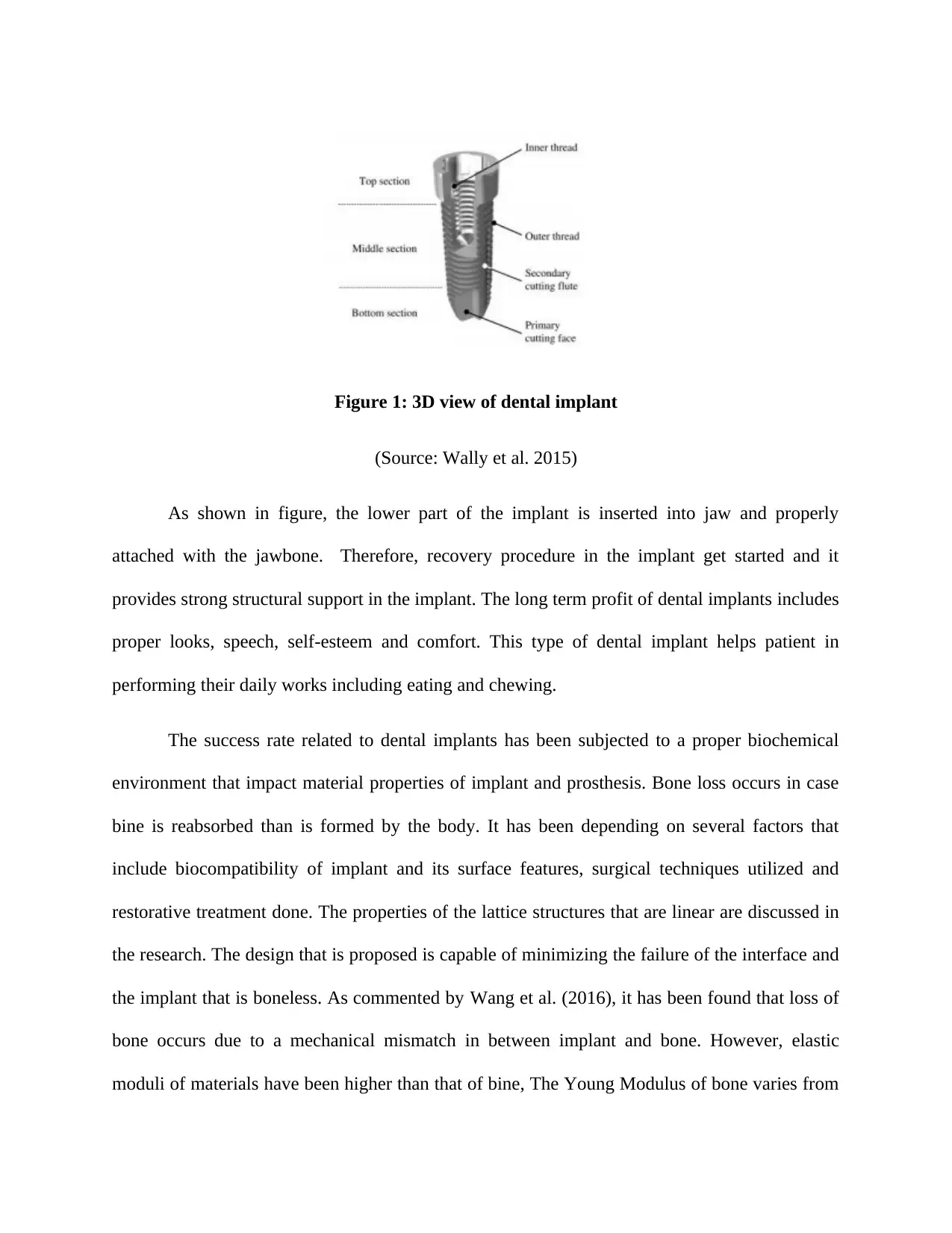
Figure 1: 3D view of dental implant
(Source: Wally et al. 2015)
As shown in figure, the lower part of the implant is inserted into jaw and properly
attached with the jawbone. Therefore, recovery procedure in the implant get started and it
provides strong structural support in the implant. The long term profit of dental implants includes
proper looks, speech, self-esteem and comfort. This type of dental implant helps patient in
performing their daily works including eating and chewing.
The success rate related to dental implants has been subjected to a proper biochemical
environment that impact material properties of implant and prosthesis. Bone loss occurs in case
bine is reabsorbed than is formed by the body. It has been depending on several factors that
include biocompatibility of implant and its surface features, surgical techniques utilized and
restorative treatment done. The properties of the lattice structures that are linear are discussed in
the research. The design that is proposed is capable of minimizing the failure of the interface and
the implant that is boneless. As commented by Wang et al. (2016), it has been found that loss of
bone occurs due to a mechanical mismatch in between implant and bone. However, elastic
moduli of materials have been higher than that of bine, The Young Modulus of bone varies from
(Source: Wally et al. 2015)
As shown in figure, the lower part of the implant is inserted into jaw and properly
attached with the jawbone. Therefore, recovery procedure in the implant get started and it
provides strong structural support in the implant. The long term profit of dental implants includes
proper looks, speech, self-esteem and comfort. This type of dental implant helps patient in
performing their daily works including eating and chewing.
The success rate related to dental implants has been subjected to a proper biochemical
environment that impact material properties of implant and prosthesis. Bone loss occurs in case
bine is reabsorbed than is formed by the body. It has been depending on several factors that
include biocompatibility of implant and its surface features, surgical techniques utilized and
restorative treatment done. The properties of the lattice structures that are linear are discussed in
the research. The design that is proposed is capable of minimizing the failure of the interface and
the implant that is boneless. As commented by Wang et al. (2016), it has been found that loss of
bone occurs due to a mechanical mismatch in between implant and bone. However, elastic
moduli of materials have been higher than that of bine, The Young Modulus of bone varies from
Secure Best Marks with AI Grader
Need help grading? Try our AI Grader for instant feedback on your assignments.
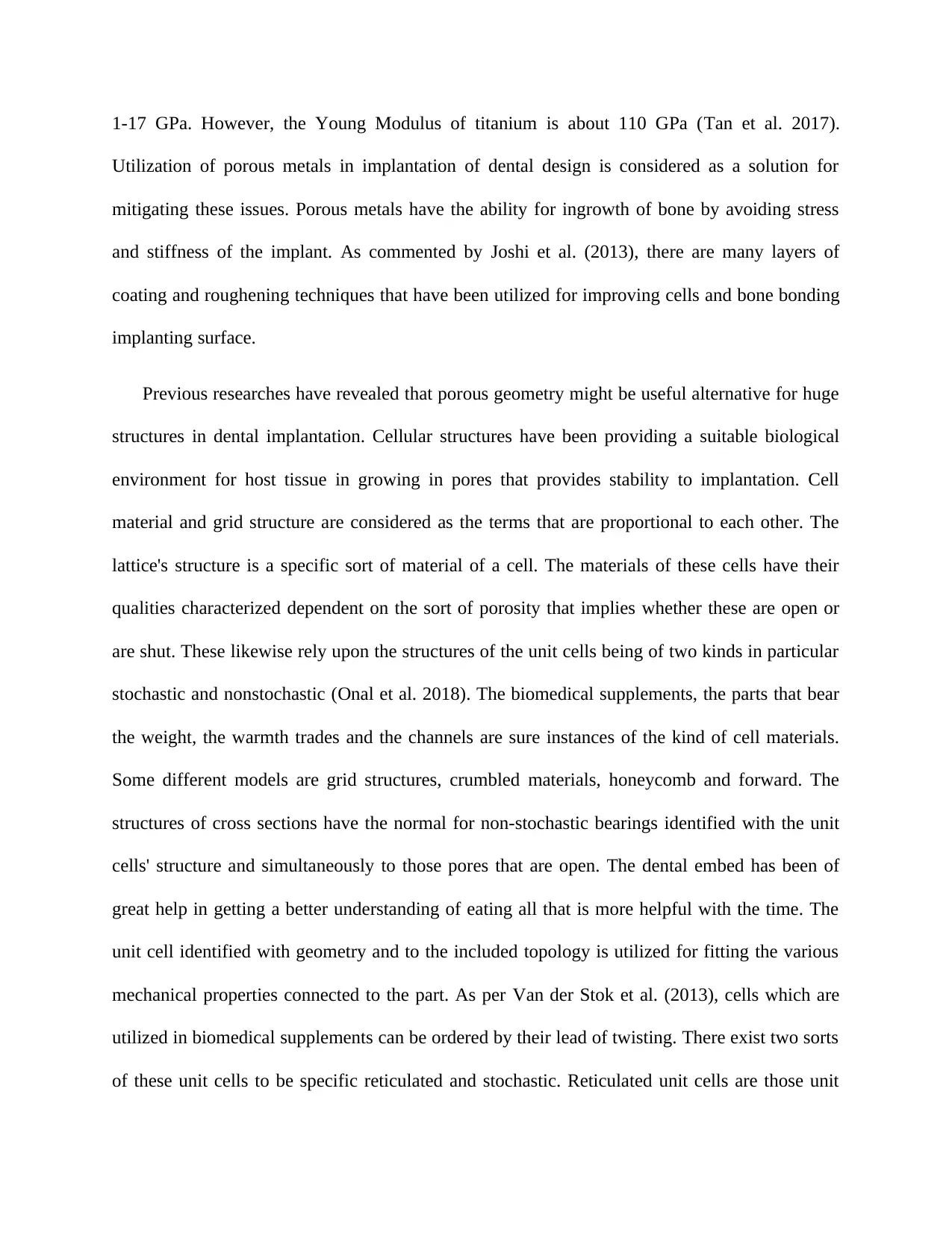
1-17 GPa. However, the Young Modulus of titanium is about 110 GPa (Tan et al. 2017).
Utilization of porous metals in implantation of dental design is considered as a solution for
mitigating these issues. Porous metals have the ability for ingrowth of bone by avoiding stress
and stiffness of the implant. As commented by Joshi et al. (2013), there are many layers of
coating and roughening techniques that have been utilized for improving cells and bone bonding
implanting surface.
Previous researches have revealed that porous geometry might be useful alternative for huge
structures in dental implantation. Cellular structures have been providing a suitable biological
environment for host tissue in growing in pores that provides stability to implantation. Cell
material and grid structure are considered as the terms that are proportional to each other. The
lattice's structure is a specific sort of material of a cell. The materials of these cells have their
qualities characterized dependent on the sort of porosity that implies whether these are open or
are shut. These likewise rely upon the structures of the unit cells being of two kinds in particular
stochastic and nonstochastic (Onal et al. 2018). The biomedical supplements, the parts that bear
the weight, the warmth trades and the channels are sure instances of the kind of cell materials.
Some different models are grid structures, crumbled materials, honeycomb and forward. The
structures of cross sections have the normal for non-stochastic bearings identified with the unit
cells' structure and simultaneously to those pores that are open. The dental embed has been of
great help in getting a better understanding of eating all that is more helpful with the time. The
unit cell identified with geometry and to the included topology is utilized for fitting the various
mechanical properties connected to the part. As per Van der Stok et al. (2013), cells which are
utilized in biomedical supplements can be ordered by their lead of twisting. There exist two sorts
of these unit cells to be specific reticulated and stochastic. Reticulated unit cells are those unit
Utilization of porous metals in implantation of dental design is considered as a solution for
mitigating these issues. Porous metals have the ability for ingrowth of bone by avoiding stress
and stiffness of the implant. As commented by Joshi et al. (2013), there are many layers of
coating and roughening techniques that have been utilized for improving cells and bone bonding
implanting surface.
Previous researches have revealed that porous geometry might be useful alternative for huge
structures in dental implantation. Cellular structures have been providing a suitable biological
environment for host tissue in growing in pores that provides stability to implantation. Cell
material and grid structure are considered as the terms that are proportional to each other. The
lattice's structure is a specific sort of material of a cell. The materials of these cells have their
qualities characterized dependent on the sort of porosity that implies whether these are open or
are shut. These likewise rely upon the structures of the unit cells being of two kinds in particular
stochastic and nonstochastic (Onal et al. 2018). The biomedical supplements, the parts that bear
the weight, the warmth trades and the channels are sure instances of the kind of cell materials.
Some different models are grid structures, crumbled materials, honeycomb and forward. The
structures of cross sections have the normal for non-stochastic bearings identified with the unit
cells' structure and simultaneously to those pores that are open. The dental embed has been of
great help in getting a better understanding of eating all that is more helpful with the time. The
unit cell identified with geometry and to the included topology is utilized for fitting the various
mechanical properties connected to the part. As per Van der Stok et al. (2013), cells which are
utilized in biomedical supplements can be ordered by their lead of twisting. There exist two sorts
of these unit cells to be specific reticulated and stochastic. Reticulated unit cells are those unit
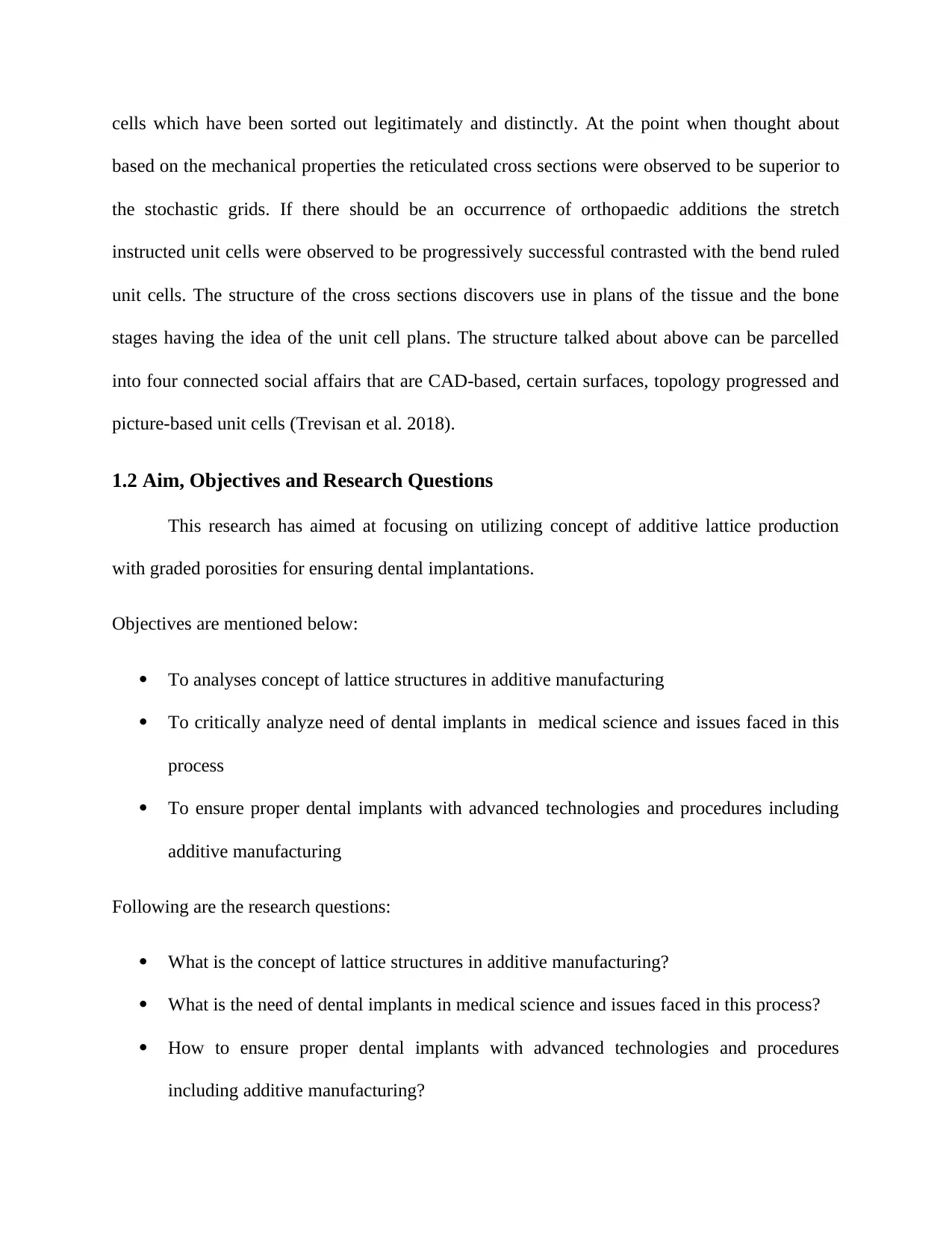
cells which have been sorted out legitimately and distinctly. At the point when thought about
based on the mechanical properties the reticulated cross sections were observed to be superior to
the stochastic grids. If there should be an occurrence of orthopaedic additions the stretch
instructed unit cells were observed to be progressively successful contrasted with the bend ruled
unit cells. The structure of the cross sections discovers use in plans of the tissue and the bone
stages having the idea of the unit cell plans. The structure talked about above can be parcelled
into four connected social affairs that are CAD-based, certain surfaces, topology progressed and
picture-based unit cells (Trevisan et al. 2018).
1.2 Aim, Objectives and Research Questions
This research has aimed at focusing on utilizing concept of additive lattice production
with graded porosities for ensuring dental implantations.
Objectives are mentioned below:
To analyses concept of lattice structures in additive manufacturing
To critically analyze need of dental implants in medical science and issues faced in this
process
To ensure proper dental implants with advanced technologies and procedures including
additive manufacturing
Following are the research questions:
What is the concept of lattice structures in additive manufacturing?
What is the need of dental implants in medical science and issues faced in this process?
How to ensure proper dental implants with advanced technologies and procedures
including additive manufacturing?
based on the mechanical properties the reticulated cross sections were observed to be superior to
the stochastic grids. If there should be an occurrence of orthopaedic additions the stretch
instructed unit cells were observed to be progressively successful contrasted with the bend ruled
unit cells. The structure of the cross sections discovers use in plans of the tissue and the bone
stages having the idea of the unit cell plans. The structure talked about above can be parcelled
into four connected social affairs that are CAD-based, certain surfaces, topology progressed and
picture-based unit cells (Trevisan et al. 2018).
1.2 Aim, Objectives and Research Questions
This research has aimed at focusing on utilizing concept of additive lattice production
with graded porosities for ensuring dental implantations.
Objectives are mentioned below:
To analyses concept of lattice structures in additive manufacturing
To critically analyze need of dental implants in medical science and issues faced in this
process
To ensure proper dental implants with advanced technologies and procedures including
additive manufacturing
Following are the research questions:
What is the concept of lattice structures in additive manufacturing?
What is the need of dental implants in medical science and issues faced in this process?
How to ensure proper dental implants with advanced technologies and procedures
including additive manufacturing?

1.3 Research Structure
Chapter 1: Introduction
Chapter 2: Literature Review
Chapter 3: Research Methodology
Chapter 4: Data Findings and Analysis
Chapter 5: Conclusion and Recommendations
Chapter 1: Introduction
Chapter 2: Literature Review
Chapter 3: Research Methodology
Chapter 4: Data Findings and Analysis
Chapter 5: Conclusion and Recommendations
Paraphrase This Document
Need a fresh take? Get an instant paraphrase of this document with our AI Paraphraser
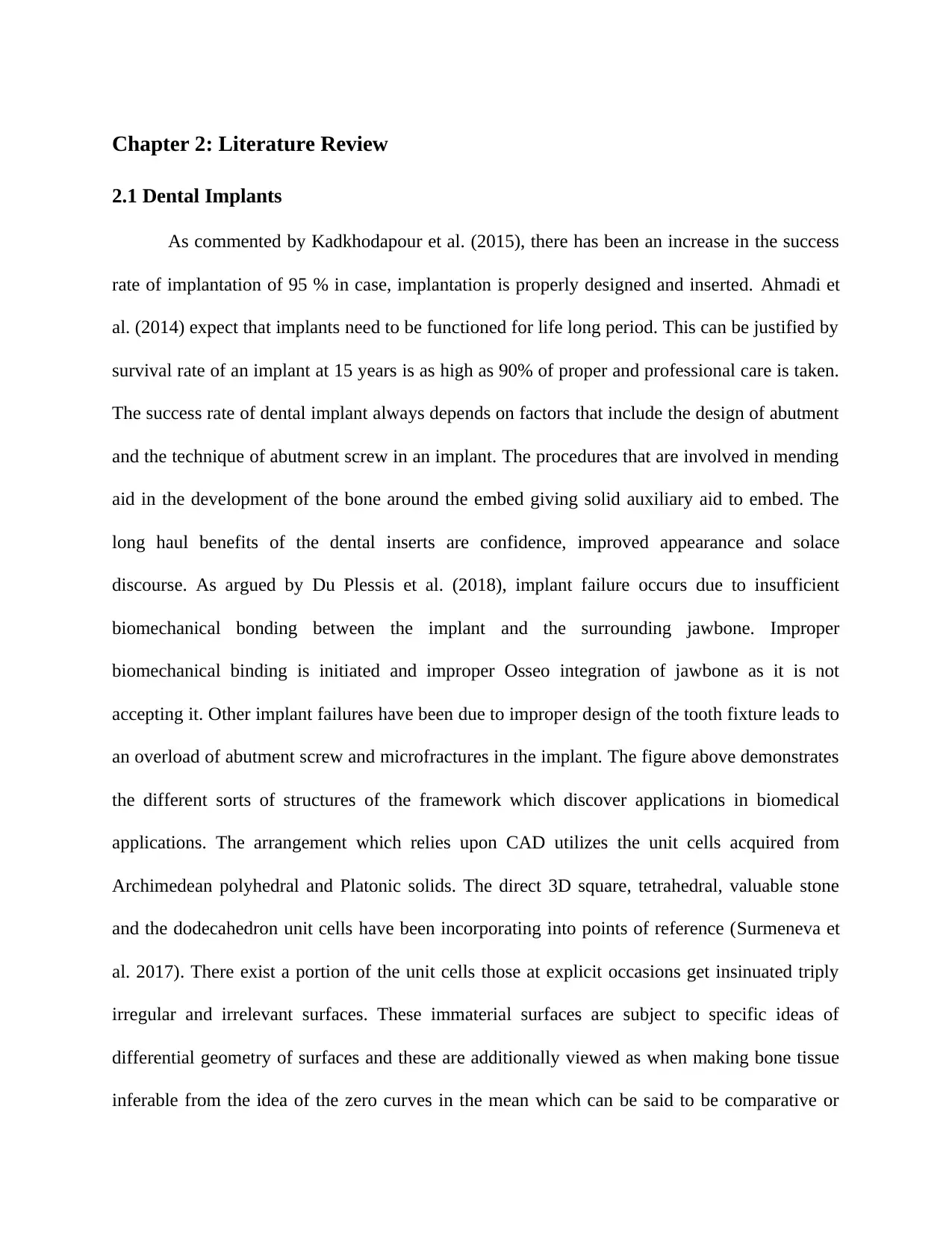
Chapter 2: Literature Review
2.1 Dental Implants
As commented by Kadkhodapour et al. (2015), there has been an increase in the success
rate of implantation of 95 % in case, implantation is properly designed and inserted. Ahmadi et
al. (2014) expect that implants need to be functioned for life long period. This can be justified by
survival rate of an implant at 15 years is as high as 90% of proper and professional care is taken.
The success rate of dental implant always depends on factors that include the design of abutment
and the technique of abutment screw in an implant. The procedures that are involved in mending
aid in the development of the bone around the embed giving solid auxiliary aid to embed. The
long haul benefits of the dental inserts are confidence, improved appearance and solace
discourse. As argued by Du Plessis et al. (2018), implant failure occurs due to insufficient
biomechanical bonding between the implant and the surrounding jawbone. Improper
biomechanical binding is initiated and improper Osseo integration of jawbone as it is not
accepting it. Other implant failures have been due to improper design of the tooth fixture leads to
an overload of abutment screw and microfractures in the implant. The figure above demonstrates
the different sorts of structures of the framework which discover applications in biomedical
applications. The arrangement which relies upon CAD utilizes the unit cells acquired from
Archimedean polyhedral and Platonic solids. The direct 3D square, tetrahedral, valuable stone
and the dodecahedron unit cells have been incorporating into points of reference (Surmeneva et
al. 2017). There exist a portion of the unit cells those at explicit occasions get insinuated triply
irregular and irrelevant surfaces. These immaterial surfaces are subject to specific ideas of
differential geometry of surfaces and these are additionally viewed as when making bone tissue
inferable from the idea of the zero curves in the mean which can be said to be comparative or
2.1 Dental Implants
As commented by Kadkhodapour et al. (2015), there has been an increase in the success
rate of implantation of 95 % in case, implantation is properly designed and inserted. Ahmadi et
al. (2014) expect that implants need to be functioned for life long period. This can be justified by
survival rate of an implant at 15 years is as high as 90% of proper and professional care is taken.
The success rate of dental implant always depends on factors that include the design of abutment
and the technique of abutment screw in an implant. The procedures that are involved in mending
aid in the development of the bone around the embed giving solid auxiliary aid to embed. The
long haul benefits of the dental inserts are confidence, improved appearance and solace
discourse. As argued by Du Plessis et al. (2018), implant failure occurs due to insufficient
biomechanical bonding between the implant and the surrounding jawbone. Improper
biomechanical binding is initiated and improper Osseo integration of jawbone as it is not
accepting it. Other implant failures have been due to improper design of the tooth fixture leads to
an overload of abutment screw and microfractures in the implant. The figure above demonstrates
the different sorts of structures of the framework which discover applications in biomedical
applications. The arrangement which relies upon CAD utilizes the unit cells acquired from
Archimedean polyhedral and Platonic solids. The direct 3D square, tetrahedral, valuable stone
and the dodecahedron unit cells have been incorporating into points of reference (Surmeneva et
al. 2017). There exist a portion of the unit cells those at explicit occasions get insinuated triply
irregular and irrelevant surfaces. These immaterial surfaces are subject to specific ideas of
differential geometry of surfaces and these are additionally viewed as when making bone tissue
inferable from the idea of the zero curves in the mean which can be said to be comparative or
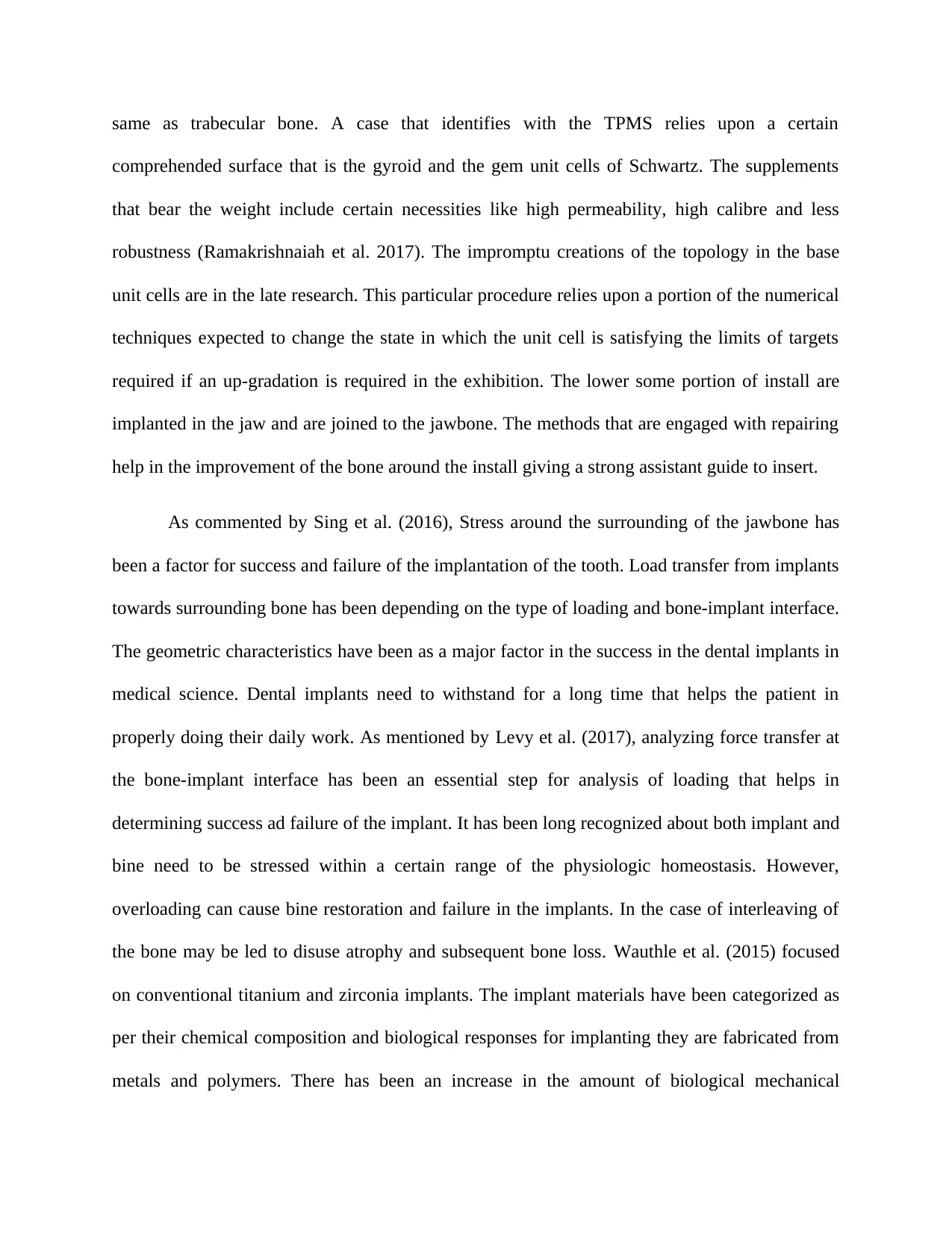
same as trabecular bone. A case that identifies with the TPMS relies upon a certain
comprehended surface that is the gyroid and the gem unit cells of Schwartz. The supplements
that bear the weight include certain necessities like high permeability, high calibre and less
robustness (Ramakrishnaiah et al. 2017). The impromptu creations of the topology in the base
unit cells are in the late research. This particular procedure relies upon a portion of the numerical
techniques expected to change the state in which the unit cell is satisfying the limits of targets
required if an up-gradation is required in the exhibition. The lower some portion of install are
implanted in the jaw and are joined to the jawbone. The methods that are engaged with repairing
help in the improvement of the bone around the install giving a strong assistant guide to insert.
As commented by Sing et al. (2016), Stress around the surrounding of the jawbone has
been a factor for success and failure of the implantation of the tooth. Load transfer from implants
towards surrounding bone has been depending on the type of loading and bone-implant interface.
The geometric characteristics have been as a major factor in the success in the dental implants in
medical science. Dental implants need to withstand for a long time that helps the patient in
properly doing their daily work. As mentioned by Levy et al. (2017), analyzing force transfer at
the bone-implant interface has been an essential step for analysis of loading that helps in
determining success ad failure of the implant. It has been long recognized about both implant and
bine need to be stressed within a certain range of the physiologic homeostasis. However,
overloading can cause bine restoration and failure in the implants. In the case of interleaving of
the bone may be led to disuse atrophy and subsequent bone loss. Wauthle et al. (2015) focused
on conventional titanium and zirconia implants. The implant materials have been categorized as
per their chemical composition and biological responses for implanting they are fabricated from
metals and polymers. There has been an increase in the amount of biological mechanical
comprehended surface that is the gyroid and the gem unit cells of Schwartz. The supplements
that bear the weight include certain necessities like high permeability, high calibre and less
robustness (Ramakrishnaiah et al. 2017). The impromptu creations of the topology in the base
unit cells are in the late research. This particular procedure relies upon a portion of the numerical
techniques expected to change the state in which the unit cell is satisfying the limits of targets
required if an up-gradation is required in the exhibition. The lower some portion of install are
implanted in the jaw and are joined to the jawbone. The methods that are engaged with repairing
help in the improvement of the bone around the install giving a strong assistant guide to insert.
As commented by Sing et al. (2016), Stress around the surrounding of the jawbone has
been a factor for success and failure of the implantation of the tooth. Load transfer from implants
towards surrounding bone has been depending on the type of loading and bone-implant interface.
The geometric characteristics have been as a major factor in the success in the dental implants in
medical science. Dental implants need to withstand for a long time that helps the patient in
properly doing their daily work. As mentioned by Levy et al. (2017), analyzing force transfer at
the bone-implant interface has been an essential step for analysis of loading that helps in
determining success ad failure of the implant. It has been long recognized about both implant and
bine need to be stressed within a certain range of the physiologic homeostasis. However,
overloading can cause bine restoration and failure in the implants. In the case of interleaving of
the bone may be led to disuse atrophy and subsequent bone loss. Wauthle et al. (2015) focused
on conventional titanium and zirconia implants. The implant materials have been categorized as
per their chemical composition and biological responses for implanting they are fabricated from
metals and polymers. There has been an increase in the amount of biological mechanical
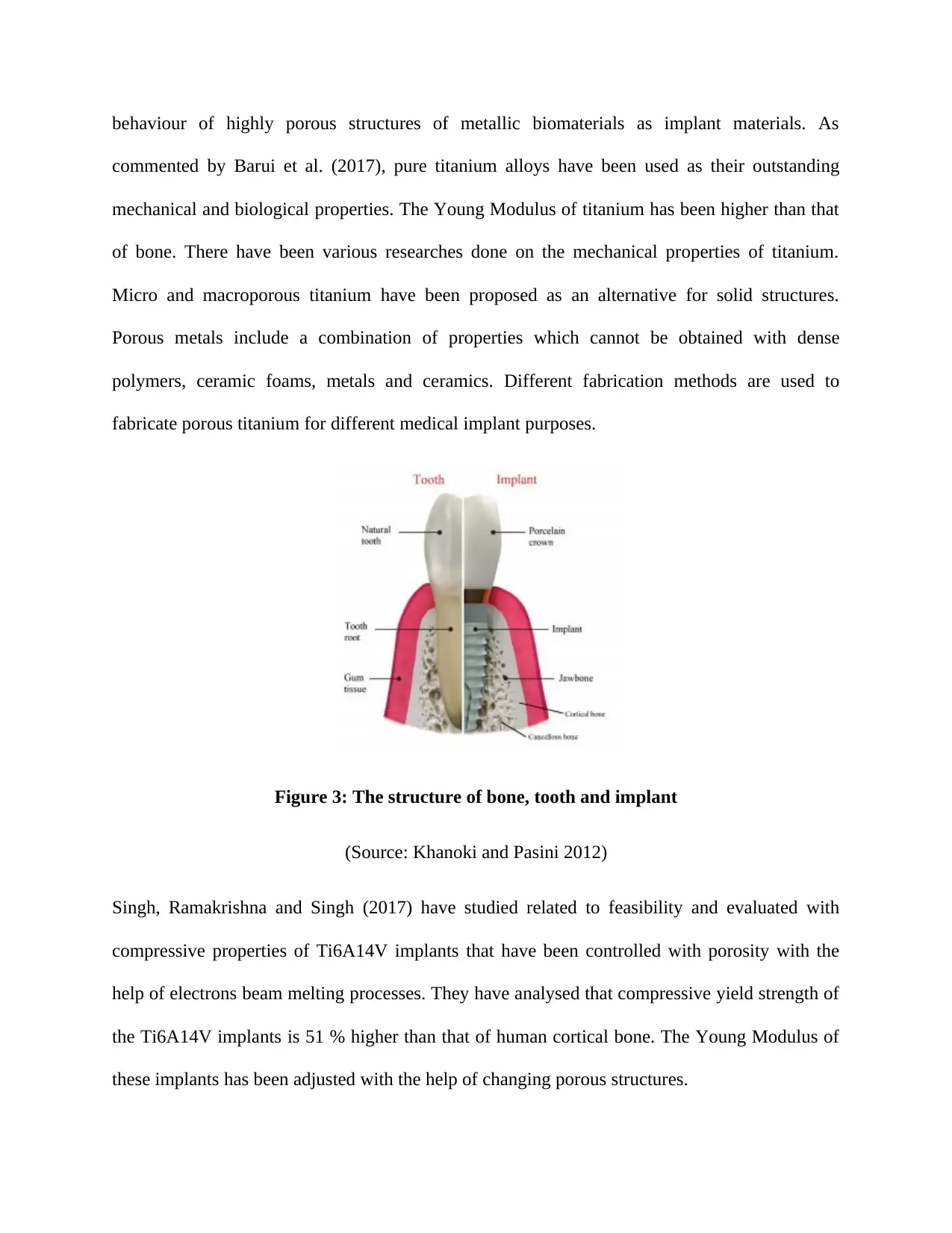
behaviour of highly porous structures of metallic biomaterials as implant materials. As
commented by Barui et al. (2017), pure titanium alloys have been used as their outstanding
mechanical and biological properties. The Young Modulus of titanium has been higher than that
of bone. There have been various researches done on the mechanical properties of titanium.
Micro and macroporous titanium have been proposed as an alternative for solid structures.
Porous metals include a combination of properties which cannot be obtained with dense
polymers, ceramic foams, metals and ceramics. Different fabrication methods are used to
fabricate porous titanium for different medical implant purposes.
Figure 3: The structure of bone, tooth and implant
(Source: Khanoki and Pasini 2012)
Singh, Ramakrishna and Singh (2017) have studied related to feasibility and evaluated with
compressive properties of Ti6A14V implants that have been controlled with porosity with the
help of electrons beam melting processes. They have analysed that compressive yield strength of
the Ti6A14V implants is 51 % higher than that of human cortical bone. The Young Modulus of
these implants has been adjusted with the help of changing porous structures.
commented by Barui et al. (2017), pure titanium alloys have been used as their outstanding
mechanical and biological properties. The Young Modulus of titanium has been higher than that
of bone. There have been various researches done on the mechanical properties of titanium.
Micro and macroporous titanium have been proposed as an alternative for solid structures.
Porous metals include a combination of properties which cannot be obtained with dense
polymers, ceramic foams, metals and ceramics. Different fabrication methods are used to
fabricate porous titanium for different medical implant purposes.
Figure 3: The structure of bone, tooth and implant
(Source: Khanoki and Pasini 2012)
Singh, Ramakrishna and Singh (2017) have studied related to feasibility and evaluated with
compressive properties of Ti6A14V implants that have been controlled with porosity with the
help of electrons beam melting processes. They have analysed that compressive yield strength of
the Ti6A14V implants is 51 % higher than that of human cortical bone. The Young Modulus of
these implants has been adjusted with the help of changing porous structures.
Secure Best Marks with AI Grader
Need help grading? Try our AI Grader for instant feedback on your assignments.
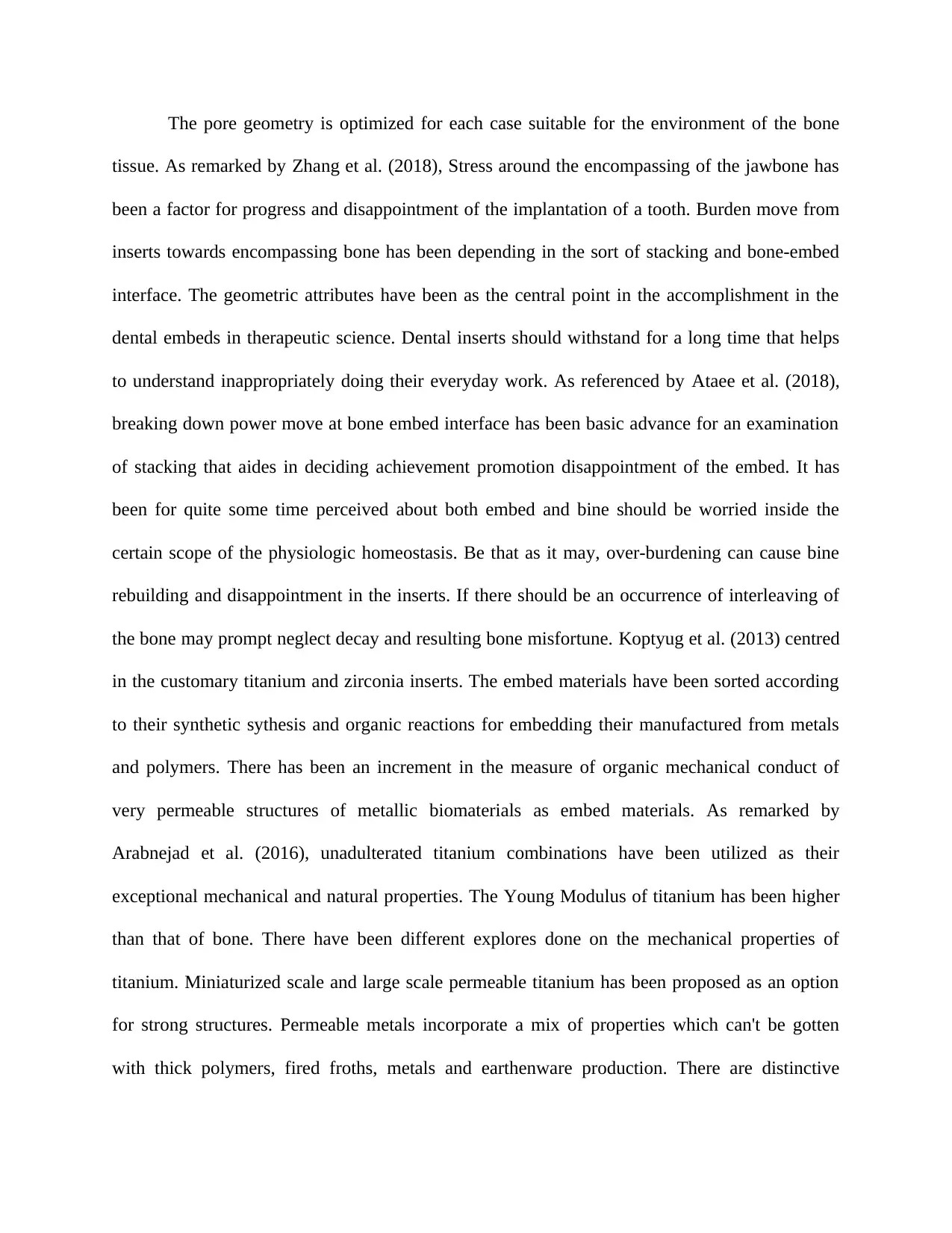
The pore geometry is optimized for each case suitable for the environment of the bone
tissue. As remarked by Zhang et al. (2018), Stress around the encompassing of the jawbone has
been a factor for progress and disappointment of the implantation of a tooth. Burden move from
inserts towards encompassing bone has been depending in the sort of stacking and bone-embed
interface. The geometric attributes have been as the central point in the accomplishment in the
dental embeds in therapeutic science. Dental inserts should withstand for a long time that helps
to understand inappropriately doing their everyday work. As referenced by Ataee et al. (2018),
breaking down power move at bone embed interface has been basic advance for an examination
of stacking that aides in deciding achievement promotion disappointment of the embed. It has
been for quite some time perceived about both embed and bine should be worried inside the
certain scope of the physiologic homeostasis. Be that as it may, over-burdening can cause bine
rebuilding and disappointment in the inserts. If there should be an occurrence of interleaving of
the bone may prompt neglect decay and resulting bone misfortune. Koptyug et al. (2013) centred
in the customary titanium and zirconia inserts. The embed materials have been sorted according
to their synthetic sythesis and organic reactions for embedding their manufactured from metals
and polymers. There has been an increment in the measure of organic mechanical conduct of
very permeable structures of metallic biomaterials as embed materials. As remarked by
Arabnejad et al. (2016), unadulterated titanium combinations have been utilized as their
exceptional mechanical and natural properties. The Young Modulus of titanium has been higher
than that of bone. There have been different explores done on the mechanical properties of
titanium. Miniaturized scale and large scale permeable titanium has been proposed as an option
for strong structures. Permeable metals incorporate a mix of properties which can't be gotten
with thick polymers, fired froths, metals and earthenware production. There are distinctive
tissue. As remarked by Zhang et al. (2018), Stress around the encompassing of the jawbone has
been a factor for progress and disappointment of the implantation of a tooth. Burden move from
inserts towards encompassing bone has been depending in the sort of stacking and bone-embed
interface. The geometric attributes have been as the central point in the accomplishment in the
dental embeds in therapeutic science. Dental inserts should withstand for a long time that helps
to understand inappropriately doing their everyday work. As referenced by Ataee et al. (2018),
breaking down power move at bone embed interface has been basic advance for an examination
of stacking that aides in deciding achievement promotion disappointment of the embed. It has
been for quite some time perceived about both embed and bine should be worried inside the
certain scope of the physiologic homeostasis. Be that as it may, over-burdening can cause bine
rebuilding and disappointment in the inserts. If there should be an occurrence of interleaving of
the bone may prompt neglect decay and resulting bone misfortune. Koptyug et al. (2013) centred
in the customary titanium and zirconia inserts. The embed materials have been sorted according
to their synthetic sythesis and organic reactions for embedding their manufactured from metals
and polymers. There has been an increment in the measure of organic mechanical conduct of
very permeable structures of metallic biomaterials as embed materials. As remarked by
Arabnejad et al. (2016), unadulterated titanium combinations have been utilized as their
exceptional mechanical and natural properties. The Young Modulus of titanium has been higher
than that of bone. There have been different explores done on the mechanical properties of
titanium. Miniaturized scale and large scale permeable titanium has been proposed as an option
for strong structures. Permeable metals incorporate a mix of properties which can't be gotten
with thick polymers, fired froths, metals and earthenware production. There are distinctive
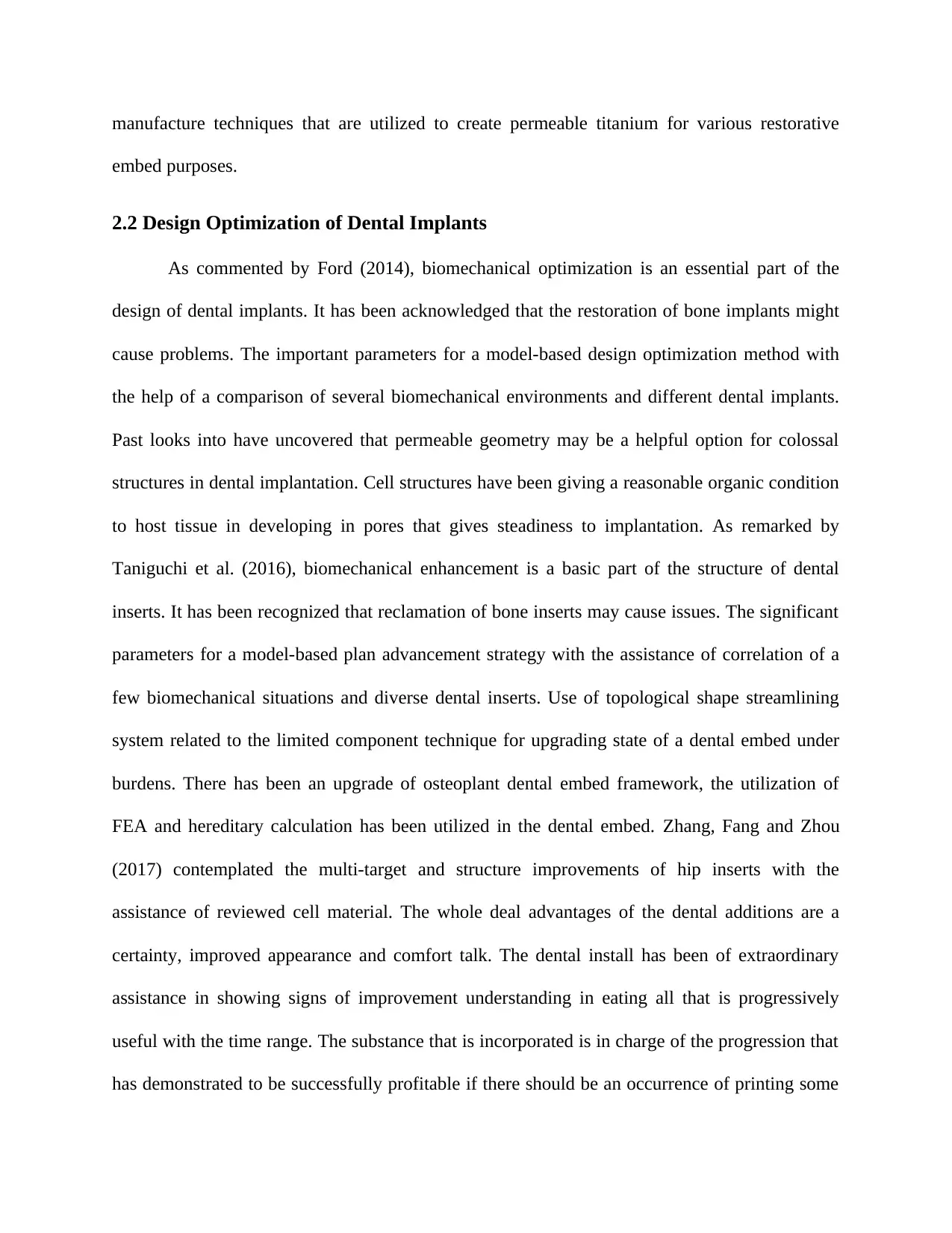
manufacture techniques that are utilized to create permeable titanium for various restorative
embed purposes.
2.2 Design Optimization of Dental Implants
As commented by Ford (2014), biomechanical optimization is an essential part of the
design of dental implants. It has been acknowledged that the restoration of bone implants might
cause problems. The important parameters for a model-based design optimization method with
the help of a comparison of several biomechanical environments and different dental implants.
Past looks into have uncovered that permeable geometry may be a helpful option for colossal
structures in dental implantation. Cell structures have been giving a reasonable organic condition
to host tissue in developing in pores that gives steadiness to implantation. As remarked by
Taniguchi et al. (2016), biomechanical enhancement is a basic part of the structure of dental
inserts. It has been recognized that reclamation of bone inserts may cause issues. The significant
parameters for a model-based plan advancement strategy with the assistance of correlation of a
few biomechanical situations and diverse dental inserts. Use of topological shape streamlining
system related to the limited component technique for upgrading state of a dental embed under
burdens. There has been an upgrade of osteoplant dental embed framework, the utilization of
FEA and hereditary calculation has been utilized in the dental embed. Zhang, Fang and Zhou
(2017) contemplated the multi-target and structure improvements of hip inserts with the
assistance of reviewed cell material. The whole deal advantages of the dental additions are a
certainty, improved appearance and comfort talk. The dental install has been of extraordinary
assistance in showing signs of improvement understanding in eating all that is progressively
useful with the time range. The substance that is incorporated is in charge of the progression that
has demonstrated to be successfully profitable if there should be an occurrence of printing some
embed purposes.
2.2 Design Optimization of Dental Implants
As commented by Ford (2014), biomechanical optimization is an essential part of the
design of dental implants. It has been acknowledged that the restoration of bone implants might
cause problems. The important parameters for a model-based design optimization method with
the help of a comparison of several biomechanical environments and different dental implants.
Past looks into have uncovered that permeable geometry may be a helpful option for colossal
structures in dental implantation. Cell structures have been giving a reasonable organic condition
to host tissue in developing in pores that gives steadiness to implantation. As remarked by
Taniguchi et al. (2016), biomechanical enhancement is a basic part of the structure of dental
inserts. It has been recognized that reclamation of bone inserts may cause issues. The significant
parameters for a model-based plan advancement strategy with the assistance of correlation of a
few biomechanical situations and diverse dental inserts. Use of topological shape streamlining
system related to the limited component technique for upgrading state of a dental embed under
burdens. There has been an upgrade of osteoplant dental embed framework, the utilization of
FEA and hereditary calculation has been utilized in the dental embed. Zhang, Fang and Zhou
(2017) contemplated the multi-target and structure improvements of hip inserts with the
assistance of reviewed cell material. The whole deal advantages of the dental additions are a
certainty, improved appearance and comfort talk. The dental install has been of extraordinary
assistance in showing signs of improvement understanding in eating all that is progressively
useful with the time range. The substance that is incorporated is in charge of the progression that
has demonstrated to be successfully profitable if there should be an occurrence of printing some
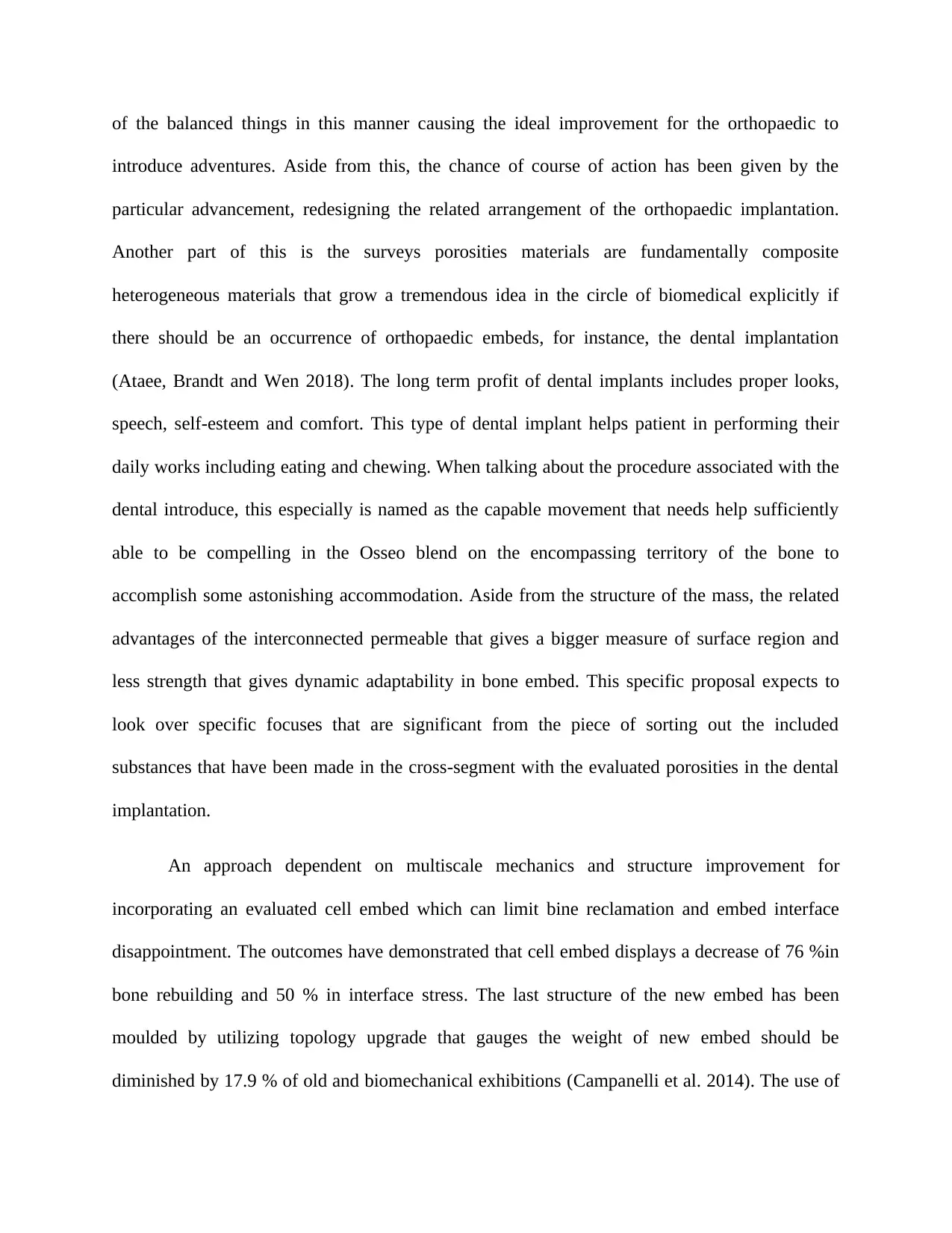
of the balanced things in this manner causing the ideal improvement for the orthopaedic to
introduce adventures. Aside from this, the chance of course of action has been given by the
particular advancement, redesigning the related arrangement of the orthopaedic implantation.
Another part of this is the surveys porosities materials are fundamentally composite
heterogeneous materials that grow a tremendous idea in the circle of biomedical explicitly if
there should be an occurrence of orthopaedic embeds, for instance, the dental implantation
(Ataee, Brandt and Wen 2018). The long term profit of dental implants includes proper looks,
speech, self-esteem and comfort. This type of dental implant helps patient in performing their
daily works including eating and chewing. When talking about the procedure associated with the
dental introduce, this especially is named as the capable movement that needs help sufficiently
able to be compelling in the Osseo blend on the encompassing territory of the bone to
accomplish some astonishing accommodation. Aside from the structure of the mass, the related
advantages of the interconnected permeable that gives a bigger measure of surface region and
less strength that gives dynamic adaptability in bone embed. This specific proposal expects to
look over specific focuses that are significant from the piece of sorting out the included
substances that have been made in the cross-segment with the evaluated porosities in the dental
implantation.
An approach dependent on multiscale mechanics and structure improvement for
incorporating an evaluated cell embed which can limit bine reclamation and embed interface
disappointment. The outcomes have demonstrated that cell embed displays a decrease of 76 %in
bone rebuilding and 50 % in interface stress. The last structure of the new embed has been
moulded by utilizing topology upgrade that gauges the weight of new embed should be
diminished by 17.9 % of old and biomechanical exhibitions (Campanelli et al. 2014). The use of
introduce adventures. Aside from this, the chance of course of action has been given by the
particular advancement, redesigning the related arrangement of the orthopaedic implantation.
Another part of this is the surveys porosities materials are fundamentally composite
heterogeneous materials that grow a tremendous idea in the circle of biomedical explicitly if
there should be an occurrence of orthopaedic embeds, for instance, the dental implantation
(Ataee, Brandt and Wen 2018). The long term profit of dental implants includes proper looks,
speech, self-esteem and comfort. This type of dental implant helps patient in performing their
daily works including eating and chewing. When talking about the procedure associated with the
dental introduce, this especially is named as the capable movement that needs help sufficiently
able to be compelling in the Osseo blend on the encompassing territory of the bone to
accomplish some astonishing accommodation. Aside from the structure of the mass, the related
advantages of the interconnected permeable that gives a bigger measure of surface region and
less strength that gives dynamic adaptability in bone embed. This specific proposal expects to
look over specific focuses that are significant from the piece of sorting out the included
substances that have been made in the cross-segment with the evaluated porosities in the dental
implantation.
An approach dependent on multiscale mechanics and structure improvement for
incorporating an evaluated cell embed which can limit bine reclamation and embed interface
disappointment. The outcomes have demonstrated that cell embed displays a decrease of 76 %in
bone rebuilding and 50 % in interface stress. The last structure of the new embed has been
moulded by utilizing topology upgrade that gauges the weight of new embed should be
diminished by 17.9 % of old and biomechanical exhibitions (Campanelli et al. 2014). The use of
Paraphrase This Document
Need a fresh take? Get an instant paraphrase of this document with our AI Paraphraser

hereditary and animated calculations have had the option to enhance the FGM angle design for
an attractive bone turnover result.
As remarked by Andani et al. (2014), there has been an increment in progress pace of
implantation of 95 % on the off chance that implantation is appropriately structured and
embedded. Singh and Ramakrishna (2017) expect that inserts should be worked for a long-
lasting period. This can be defended by the survival pace of embed at 15 years is as high as 90%
of legitimate and expert consideration is taken. The achievement pace of dental embed
consistently relies upon variables that incorporate the structure of projection and method of
projection screw-in embed. As contended by Ataee, Brandt and Wen (2018), embed
disappointment happens because of inadequate biomechanical holding among embed and the
encompassing jawbone. Ill-advised biomechanical restricting is started and inappropriate Osseo
combination of the jawbone as it isn't tolerating it. Other embed disappointments have been
because of the ill-advised plan of tooth installation prompts over-burden of projection screw and
miniaturized scale breaks in the embed (Wally et al. 2019).
Utilization of topological shape optimization technique in conjunction with the finite
element method for optimizing the shape of a dental implant under loads. The achievement rate
related to dental inserts has been exposed to a legitimate biochemical condition that affects the
material properties of embed and prosthesis. Bone misfortune happens if bine is reabsorbed than
is framed by the body. IT has been depending on a few factors that incorporate biocompatibility
of embed and its surface highlights, careful systems used and helpful treatment done. As
remarked by Sing et al. (2016), it has been discovered that loss of bone happens because of
mechanical befuddle in the middle of embed and bine. In any case, flexible moduli of materials
have been higher than that of bine, The Young Modulus of bone shifts from 1-17 GPa.
an attractive bone turnover result.
As remarked by Andani et al. (2014), there has been an increment in progress pace of
implantation of 95 % on the off chance that implantation is appropriately structured and
embedded. Singh and Ramakrishna (2017) expect that inserts should be worked for a long-
lasting period. This can be defended by the survival pace of embed at 15 years is as high as 90%
of legitimate and expert consideration is taken. The achievement pace of dental embed
consistently relies upon variables that incorporate the structure of projection and method of
projection screw-in embed. As contended by Ataee, Brandt and Wen (2018), embed
disappointment happens because of inadequate biomechanical holding among embed and the
encompassing jawbone. Ill-advised biomechanical restricting is started and inappropriate Osseo
combination of the jawbone as it isn't tolerating it. Other embed disappointments have been
because of the ill-advised plan of tooth installation prompts over-burden of projection screw and
miniaturized scale breaks in the embed (Wally et al. 2019).
Utilization of topological shape optimization technique in conjunction with the finite
element method for optimizing the shape of a dental implant under loads. The achievement rate
related to dental inserts has been exposed to a legitimate biochemical condition that affects the
material properties of embed and prosthesis. Bone misfortune happens if bine is reabsorbed than
is framed by the body. IT has been depending on a few factors that incorporate biocompatibility
of embed and its surface highlights, careful systems used and helpful treatment done. As
remarked by Sing et al. (2016), it has been discovered that loss of bone happens because of
mechanical befuddle in the middle of embed and bine. In any case, flexible moduli of materials
have been higher than that of bine, The Young Modulus of bone shifts from 1-17 GPa.
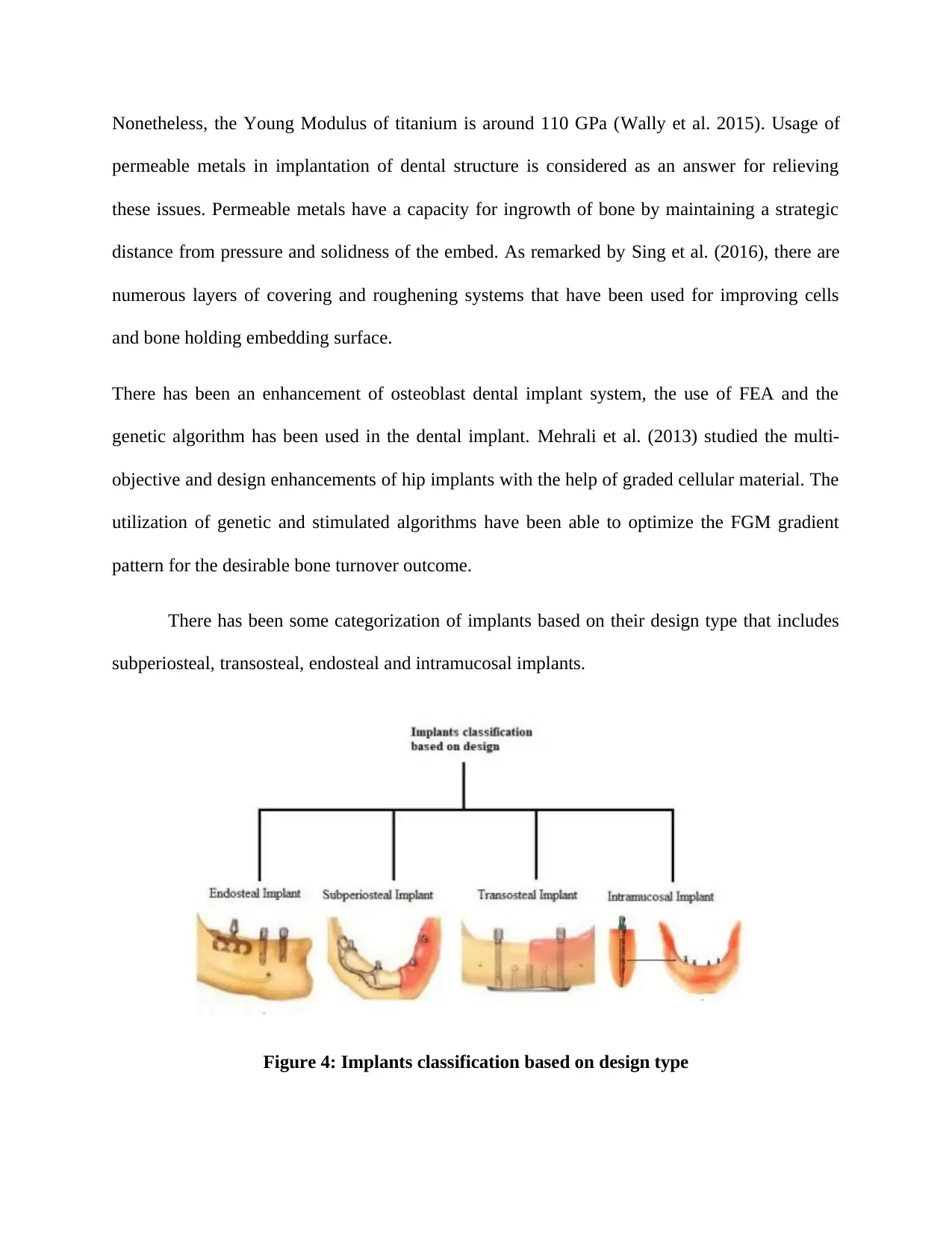
Nonetheless, the Young Modulus of titanium is around 110 GPa (Wally et al. 2015). Usage of
permeable metals in implantation of dental structure is considered as an answer for relieving
these issues. Permeable metals have a capacity for ingrowth of bone by maintaining a strategic
distance from pressure and solidness of the embed. As remarked by Sing et al. (2016), there are
numerous layers of covering and roughening systems that have been used for improving cells
and bone holding embedding surface.
There has been an enhancement of osteoblast dental implant system, the use of FEA and the
genetic algorithm has been used in the dental implant. Mehrali et al. (2013) studied the multi-
objective and design enhancements of hip implants with the help of graded cellular material. The
utilization of genetic and stimulated algorithms have been able to optimize the FGM gradient
pattern for the desirable bone turnover outcome.
There has been some categorization of implants based on their design type that includes
subperiosteal, transosteal, endosteal and intramucosal implants.
Figure 4: Implants classification based on design type
permeable metals in implantation of dental structure is considered as an answer for relieving
these issues. Permeable metals have a capacity for ingrowth of bone by maintaining a strategic
distance from pressure and solidness of the embed. As remarked by Sing et al. (2016), there are
numerous layers of covering and roughening systems that have been used for improving cells
and bone holding embedding surface.
There has been an enhancement of osteoblast dental implant system, the use of FEA and the
genetic algorithm has been used in the dental implant. Mehrali et al. (2013) studied the multi-
objective and design enhancements of hip implants with the help of graded cellular material. The
utilization of genetic and stimulated algorithms have been able to optimize the FGM gradient
pattern for the desirable bone turnover outcome.
There has been some categorization of implants based on their design type that includes
subperiosteal, transosteal, endosteal and intramucosal implants.
Figure 4: Implants classification based on design type
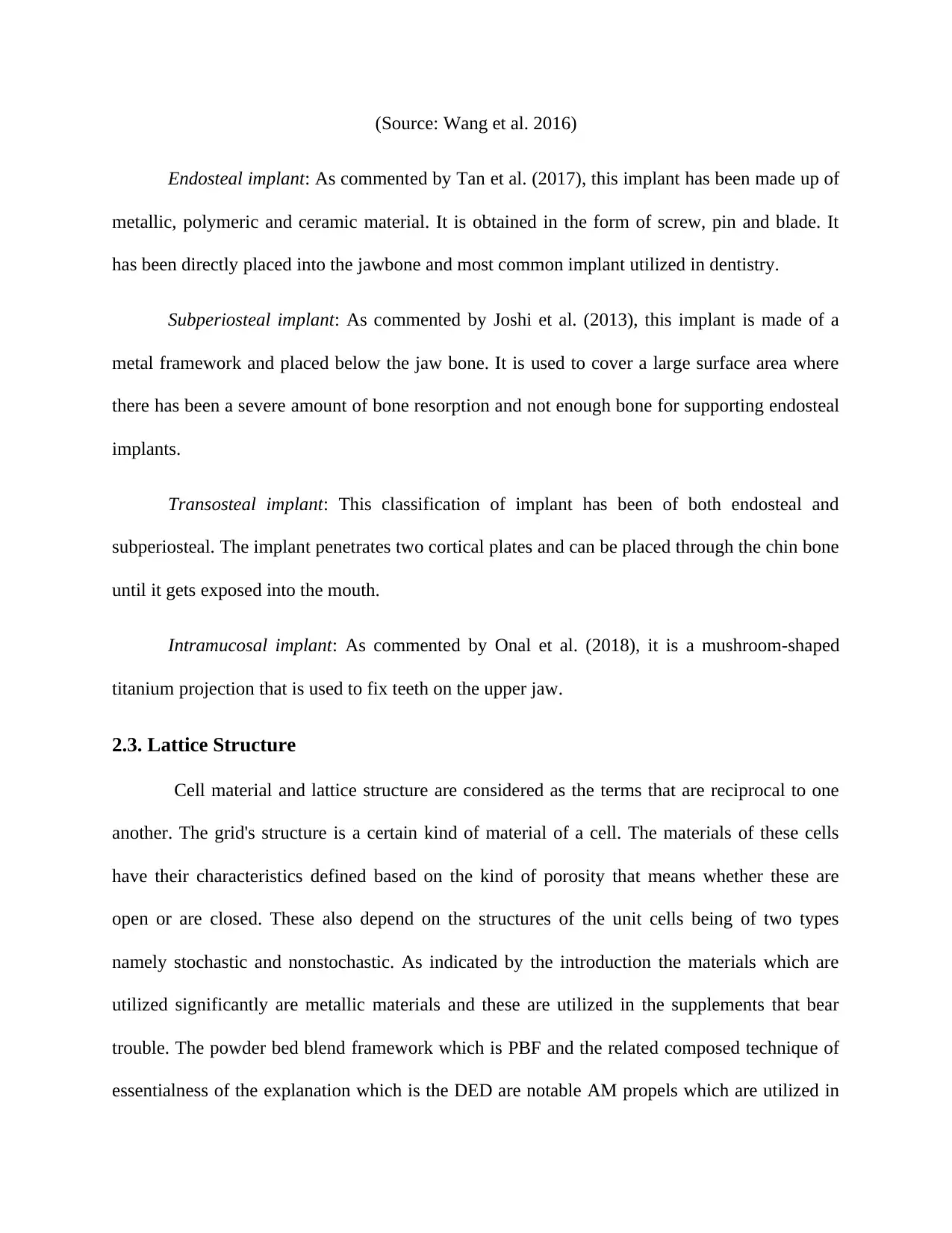
(Source: Wang et al. 2016)
Endosteal implant: As commented by Tan et al. (2017), this implant has been made up of
metallic, polymeric and ceramic material. It is obtained in the form of screw, pin and blade. It
has been directly placed into the jawbone and most common implant utilized in dentistry.
Subperiosteal implant: As commented by Joshi et al. (2013), this implant is made of a
metal framework and placed below the jaw bone. It is used to cover a large surface area where
there has been a severe amount of bone resorption and not enough bone for supporting endosteal
implants.
Transosteal implant: This classification of implant has been of both endosteal and
subperiosteal. The implant penetrates two cortical plates and can be placed through the chin bone
until it gets exposed into the mouth.
Intramucosal implant: As commented by Onal et al. (2018), it is a mushroom-shaped
titanium projection that is used to fix teeth on the upper jaw.
2.3. Lattice Structure
Cell material and lattice structure are considered as the terms that are reciprocal to one
another. The grid's structure is a certain kind of material of a cell. The materials of these cells
have their characteristics defined based on the kind of porosity that means whether these are
open or are closed. These also depend on the structures of the unit cells being of two types
namely stochastic and nonstochastic. As indicated by the introduction the materials which are
utilized significantly are metallic materials and these are utilized in the supplements that bear
trouble. The powder bed blend framework which is PBF and the related composed technique of
essentialness of the explanation which is the DED are notable AM propels which are utilized in
Endosteal implant: As commented by Tan et al. (2017), this implant has been made up of
metallic, polymeric and ceramic material. It is obtained in the form of screw, pin and blade. It
has been directly placed into the jawbone and most common implant utilized in dentistry.
Subperiosteal implant: As commented by Joshi et al. (2013), this implant is made of a
metal framework and placed below the jaw bone. It is used to cover a large surface area where
there has been a severe amount of bone resorption and not enough bone for supporting endosteal
implants.
Transosteal implant: This classification of implant has been of both endosteal and
subperiosteal. The implant penetrates two cortical plates and can be placed through the chin bone
until it gets exposed into the mouth.
Intramucosal implant: As commented by Onal et al. (2018), it is a mushroom-shaped
titanium projection that is used to fix teeth on the upper jaw.
2.3. Lattice Structure
Cell material and lattice structure are considered as the terms that are reciprocal to one
another. The grid's structure is a certain kind of material of a cell. The materials of these cells
have their characteristics defined based on the kind of porosity that means whether these are
open or are closed. These also depend on the structures of the unit cells being of two types
namely stochastic and nonstochastic. As indicated by the introduction the materials which are
utilized significantly are metallic materials and these are utilized in the supplements that bear
trouble. The powder bed blend framework which is PBF and the related composed technique of
essentialness of the explanation which is the DED are notable AM propels which are utilized in
Secure Best Marks with AI Grader
Need help grading? Try our AI Grader for instant feedback on your assignments.
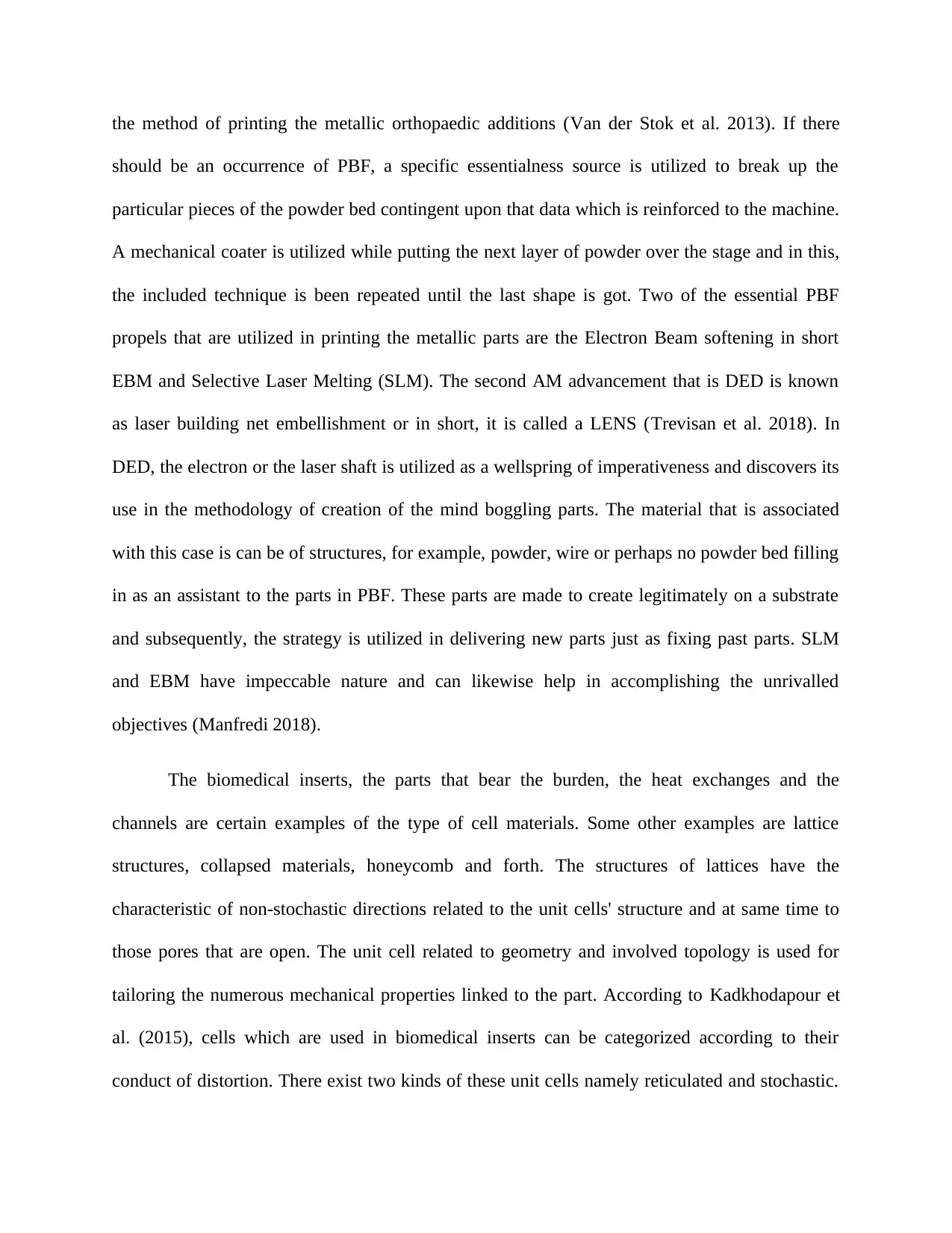
the method of printing the metallic orthopaedic additions (Van der Stok et al. 2013). If there
should be an occurrence of PBF, a specific essentialness source is utilized to break up the
particular pieces of the powder bed contingent upon that data which is reinforced to the machine.
A mechanical coater is utilized while putting the next layer of powder over the stage and in this,
the included technique is been repeated until the last shape is got. Two of the essential PBF
propels that are utilized in printing the metallic parts are the Electron Beam softening in short
EBM and Selective Laser Melting (SLM). The second AM advancement that is DED is known
as laser building net embellishment or in short, it is called a LENS (Trevisan et al. 2018). In
DED, the electron or the laser shaft is utilized as a wellspring of imperativeness and discovers its
use in the methodology of creation of the mind boggling parts. The material that is associated
with this case is can be of structures, for example, powder, wire or perhaps no powder bed filling
in as an assistant to the parts in PBF. These parts are made to create legitimately on a substrate
and subsequently, the strategy is utilized in delivering new parts just as fixing past parts. SLM
and EBM have impeccable nature and can likewise help in accomplishing the unrivalled
objectives (Manfredi 2018).
The biomedical inserts, the parts that bear the burden, the heat exchanges and the
channels are certain examples of the type of cell materials. Some other examples are lattice
structures, collapsed materials, honeycomb and forth. The structures of lattices have the
characteristic of non-stochastic directions related to the unit cells' structure and at same time to
those pores that are open. The unit cell related to geometry and involved topology is used for
tailoring the numerous mechanical properties linked to the part. According to Kadkhodapour et
al. (2015), cells which are used in biomedical inserts can be categorized according to their
conduct of distortion. There exist two kinds of these unit cells namely reticulated and stochastic.
should be an occurrence of PBF, a specific essentialness source is utilized to break up the
particular pieces of the powder bed contingent upon that data which is reinforced to the machine.
A mechanical coater is utilized while putting the next layer of powder over the stage and in this,
the included technique is been repeated until the last shape is got. Two of the essential PBF
propels that are utilized in printing the metallic parts are the Electron Beam softening in short
EBM and Selective Laser Melting (SLM). The second AM advancement that is DED is known
as laser building net embellishment or in short, it is called a LENS (Trevisan et al. 2018). In
DED, the electron or the laser shaft is utilized as a wellspring of imperativeness and discovers its
use in the methodology of creation of the mind boggling parts. The material that is associated
with this case is can be of structures, for example, powder, wire or perhaps no powder bed filling
in as an assistant to the parts in PBF. These parts are made to create legitimately on a substrate
and subsequently, the strategy is utilized in delivering new parts just as fixing past parts. SLM
and EBM have impeccable nature and can likewise help in accomplishing the unrivalled
objectives (Manfredi 2018).
The biomedical inserts, the parts that bear the burden, the heat exchanges and the
channels are certain examples of the type of cell materials. Some other examples are lattice
structures, collapsed materials, honeycomb and forth. The structures of lattices have the
characteristic of non-stochastic directions related to the unit cells' structure and at same time to
those pores that are open. The unit cell related to geometry and involved topology is used for
tailoring the numerous mechanical properties linked to the part. According to Kadkhodapour et
al. (2015), cells which are used in biomedical inserts can be categorized according to their
conduct of distortion. There exist two kinds of these unit cells namely reticulated and stochastic.
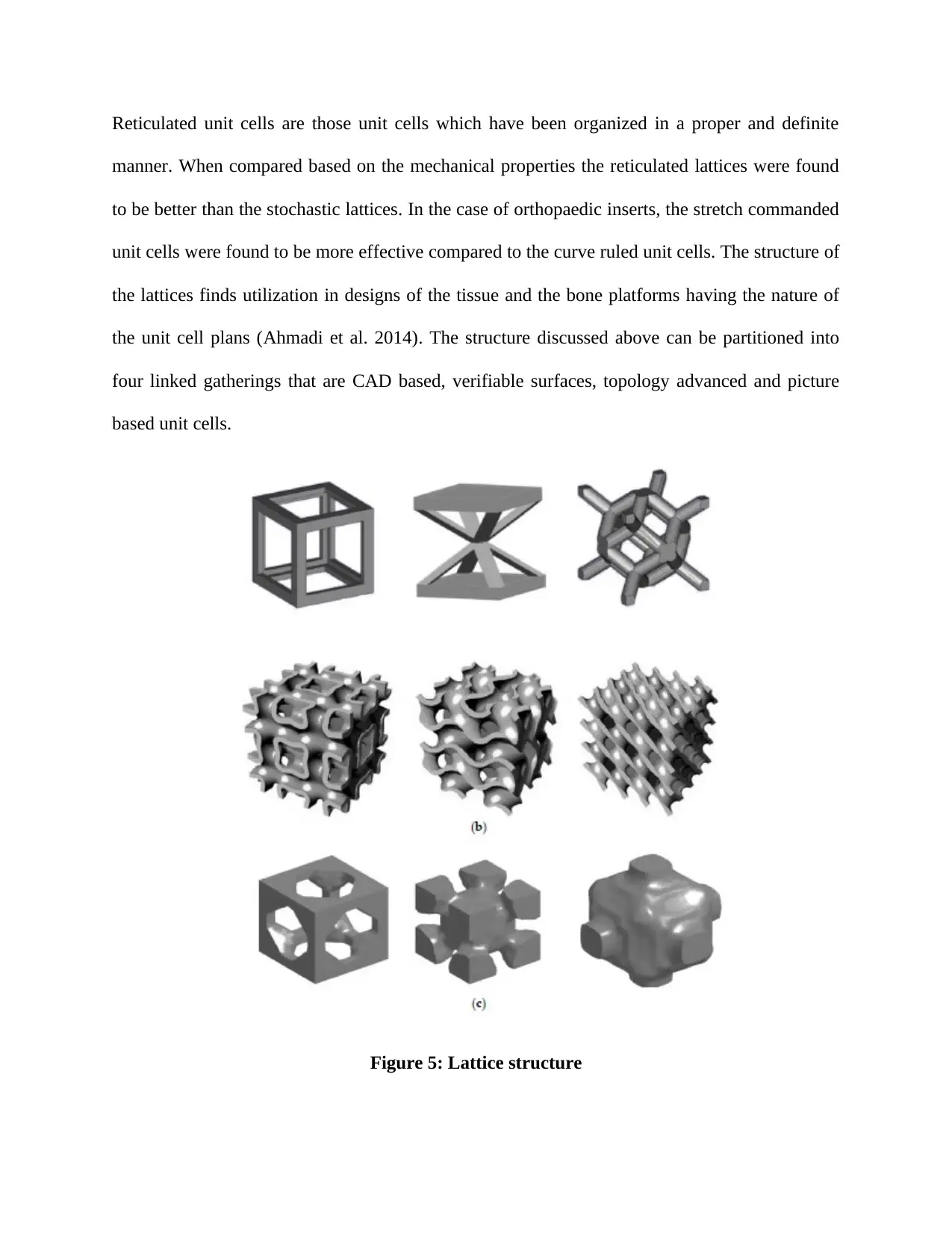
Reticulated unit cells are those unit cells which have been organized in a proper and definite
manner. When compared based on the mechanical properties the reticulated lattices were found
to be better than the stochastic lattices. In the case of orthopaedic inserts, the stretch commanded
unit cells were found to be more effective compared to the curve ruled unit cells. The structure of
the lattices finds utilization in designs of the tissue and the bone platforms having the nature of
the unit cell plans (Ahmadi et al. 2014). The structure discussed above can be partitioned into
four linked gatherings that are CAD based, verifiable surfaces, topology advanced and picture
based unit cells.
Figure 5: Lattice structure
manner. When compared based on the mechanical properties the reticulated lattices were found
to be better than the stochastic lattices. In the case of orthopaedic inserts, the stretch commanded
unit cells were found to be more effective compared to the curve ruled unit cells. The structure of
the lattices finds utilization in designs of the tissue and the bone platforms having the nature of
the unit cell plans (Ahmadi et al. 2014). The structure discussed above can be partitioned into
four linked gatherings that are CAD based, verifiable surfaces, topology advanced and picture
based unit cells.
Figure 5: Lattice structure
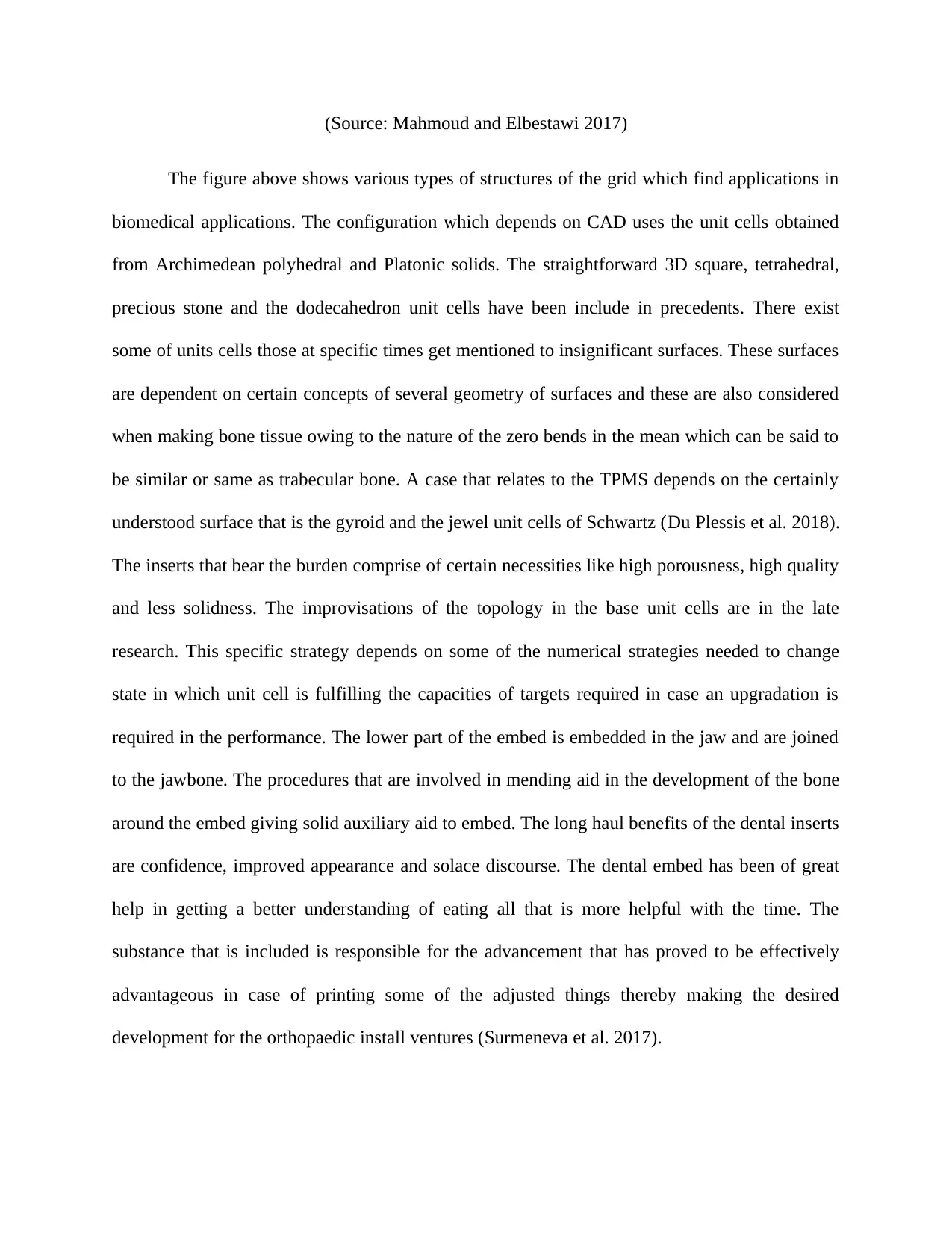
(Source: Mahmoud and Elbestawi 2017)
The figure above shows various types of structures of the grid which find applications in
biomedical applications. The configuration which depends on CAD uses the unit cells obtained
from Archimedean polyhedral and Platonic solids. The straightforward 3D square, tetrahedral,
precious stone and the dodecahedron unit cells have been include in precedents. There exist
some of units cells those at specific times get mentioned to insignificant surfaces. These surfaces
are dependent on certain concepts of several geometry of surfaces and these are also considered
when making bone tissue owing to the nature of the zero bends in the mean which can be said to
be similar or same as trabecular bone. A case that relates to the TPMS depends on the certainly
understood surface that is the gyroid and the jewel unit cells of Schwartz (Du Plessis et al. 2018).
The inserts that bear the burden comprise of certain necessities like high porousness, high quality
and less solidness. The improvisations of the topology in the base unit cells are in the late
research. This specific strategy depends on some of the numerical strategies needed to change
state in which unit cell is fulfilling the capacities of targets required in case an upgradation is
required in the performance. The lower part of the embed is embedded in the jaw and are joined
to the jawbone. The procedures that are involved in mending aid in the development of the bone
around the embed giving solid auxiliary aid to embed. The long haul benefits of the dental inserts
are confidence, improved appearance and solace discourse. The dental embed has been of great
help in getting a better understanding of eating all that is more helpful with the time. The
substance that is included is responsible for the advancement that has proved to be effectively
advantageous in case of printing some of the adjusted things thereby making the desired
development for the orthopaedic install ventures (Surmeneva et al. 2017).
The figure above shows various types of structures of the grid which find applications in
biomedical applications. The configuration which depends on CAD uses the unit cells obtained
from Archimedean polyhedral and Platonic solids. The straightforward 3D square, tetrahedral,
precious stone and the dodecahedron unit cells have been include in precedents. There exist
some of units cells those at specific times get mentioned to insignificant surfaces. These surfaces
are dependent on certain concepts of several geometry of surfaces and these are also considered
when making bone tissue owing to the nature of the zero bends in the mean which can be said to
be similar or same as trabecular bone. A case that relates to the TPMS depends on the certainly
understood surface that is the gyroid and the jewel unit cells of Schwartz (Du Plessis et al. 2018).
The inserts that bear the burden comprise of certain necessities like high porousness, high quality
and less solidness. The improvisations of the topology in the base unit cells are in the late
research. This specific strategy depends on some of the numerical strategies needed to change
state in which unit cell is fulfilling the capacities of targets required in case an upgradation is
required in the performance. The lower part of the embed is embedded in the jaw and are joined
to the jawbone. The procedures that are involved in mending aid in the development of the bone
around the embed giving solid auxiliary aid to embed. The long haul benefits of the dental inserts
are confidence, improved appearance and solace discourse. The dental embed has been of great
help in getting a better understanding of eating all that is more helpful with the time. The
substance that is included is responsible for the advancement that has proved to be effectively
advantageous in case of printing some of the adjusted things thereby making the desired
development for the orthopaedic install ventures (Surmeneva et al. 2017).
Paraphrase This Document
Need a fresh take? Get an instant paraphrase of this document with our AI Paraphraser
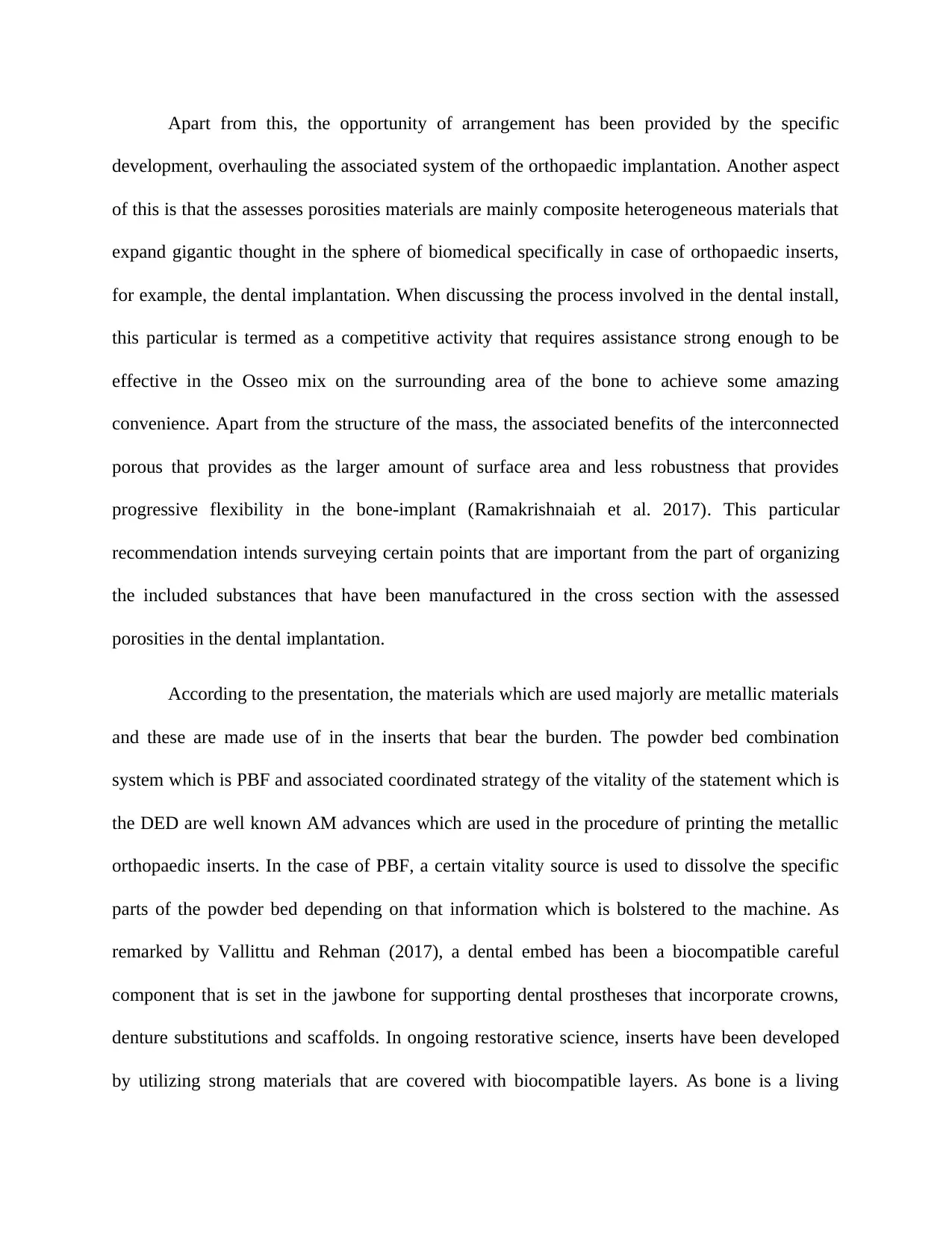
Apart from this, the opportunity of arrangement has been provided by the specific
development, overhauling the associated system of the orthopaedic implantation. Another aspect
of this is that the assesses porosities materials are mainly composite heterogeneous materials that
expand gigantic thought in the sphere of biomedical specifically in case of orthopaedic inserts,
for example, the dental implantation. When discussing the process involved in the dental install,
this particular is termed as a competitive activity that requires assistance strong enough to be
effective in the Osseo mix on the surrounding area of the bone to achieve some amazing
convenience. Apart from the structure of the mass, the associated benefits of the interconnected
porous that provides as the larger amount of surface area and less robustness that provides
progressive flexibility in the bone-implant (Ramakrishnaiah et al. 2017). This particular
recommendation intends surveying certain points that are important from the part of organizing
the included substances that have been manufactured in the cross section with the assessed
porosities in the dental implantation.
According to the presentation, the materials which are used majorly are metallic materials
and these are made use of in the inserts that bear the burden. The powder bed combination
system which is PBF and associated coordinated strategy of the vitality of the statement which is
the DED are well known AM advances which are used in the procedure of printing the metallic
orthopaedic inserts. In the case of PBF, a certain vitality source is used to dissolve the specific
parts of the powder bed depending on that information which is bolstered to the machine. As
remarked by Vallittu and Rehman (2017), a dental embed has been a biocompatible careful
component that is set in the jawbone for supporting dental prostheses that incorporate crowns,
denture substitutions and scaffolds. In ongoing restorative science, inserts have been developed
by utilizing strong materials that are covered with biocompatible layers. As bone is a living
development, overhauling the associated system of the orthopaedic implantation. Another aspect
of this is that the assesses porosities materials are mainly composite heterogeneous materials that
expand gigantic thought in the sphere of biomedical specifically in case of orthopaedic inserts,
for example, the dental implantation. When discussing the process involved in the dental install,
this particular is termed as a competitive activity that requires assistance strong enough to be
effective in the Osseo mix on the surrounding area of the bone to achieve some amazing
convenience. Apart from the structure of the mass, the associated benefits of the interconnected
porous that provides as the larger amount of surface area and less robustness that provides
progressive flexibility in the bone-implant (Ramakrishnaiah et al. 2017). This particular
recommendation intends surveying certain points that are important from the part of organizing
the included substances that have been manufactured in the cross section with the assessed
porosities in the dental implantation.
According to the presentation, the materials which are used majorly are metallic materials
and these are made use of in the inserts that bear the burden. The powder bed combination
system which is PBF and associated coordinated strategy of the vitality of the statement which is
the DED are well known AM advances which are used in the procedure of printing the metallic
orthopaedic inserts. In the case of PBF, a certain vitality source is used to dissolve the specific
parts of the powder bed depending on that information which is bolstered to the machine. As
remarked by Vallittu and Rehman (2017), a dental embed has been a biocompatible careful
component that is set in the jawbone for supporting dental prostheses that incorporate crowns,
denture substitutions and scaffolds. In ongoing restorative science, inserts have been developed
by utilizing strong materials that are covered with biocompatible layers. As bone is a living
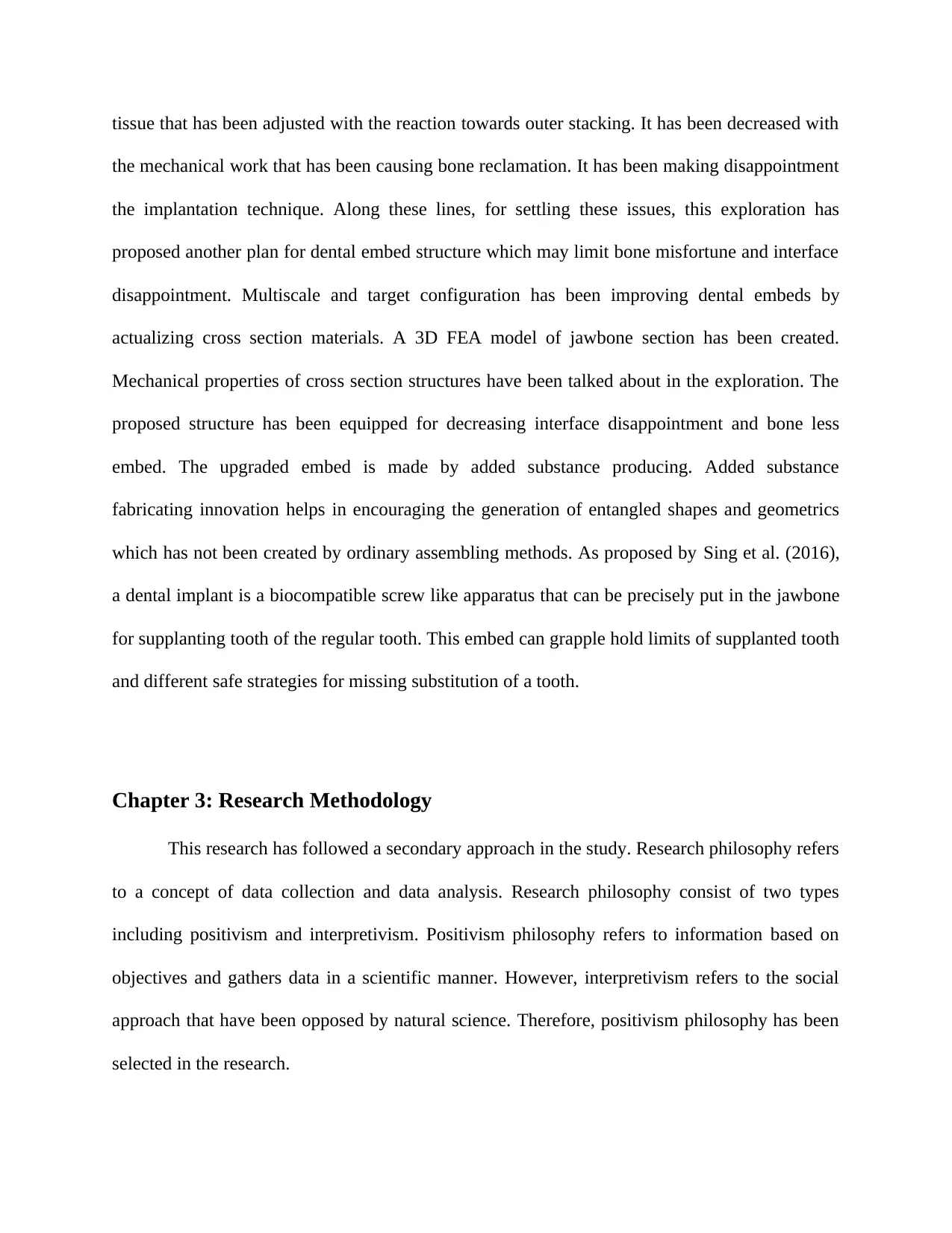
tissue that has been adjusted with the reaction towards outer stacking. It has been decreased with
the mechanical work that has been causing bone reclamation. It has been making disappointment
the implantation technique. Along these lines, for settling these issues, this exploration has
proposed another plan for dental embed structure which may limit bone misfortune and interface
disappointment. Multiscale and target configuration has been improving dental embeds by
actualizing cross section materials. A 3D FEA model of jawbone section has been created.
Mechanical properties of cross section structures have been talked about in the exploration. The
proposed structure has been equipped for decreasing interface disappointment and bone less
embed. The upgraded embed is made by added substance producing. Added substance
fabricating innovation helps in encouraging the generation of entangled shapes and geometrics
which has not been created by ordinary assembling methods. As proposed by Sing et al. (2016),
a dental implant is a biocompatible screw like apparatus that can be precisely put in the jawbone
for supplanting tooth of the regular tooth. This embed can grapple hold limits of supplanted tooth
and different safe strategies for missing substitution of a tooth.
Chapter 3: Research Methodology
This research has followed a secondary approach in the study. Research philosophy refers
to a concept of data collection and data analysis. Research philosophy consist of two types
including positivism and interpretivism. Positivism philosophy refers to information based on
objectives and gathers data in a scientific manner. However, interpretivism refers to the social
approach that have been opposed by natural science. Therefore, positivism philosophy has been
selected in the research.
the mechanical work that has been causing bone reclamation. It has been making disappointment
the implantation technique. Along these lines, for settling these issues, this exploration has
proposed another plan for dental embed structure which may limit bone misfortune and interface
disappointment. Multiscale and target configuration has been improving dental embeds by
actualizing cross section materials. A 3D FEA model of jawbone section has been created.
Mechanical properties of cross section structures have been talked about in the exploration. The
proposed structure has been equipped for decreasing interface disappointment and bone less
embed. The upgraded embed is made by added substance producing. Added substance
fabricating innovation helps in encouraging the generation of entangled shapes and geometrics
which has not been created by ordinary assembling methods. As proposed by Sing et al. (2016),
a dental implant is a biocompatible screw like apparatus that can be precisely put in the jawbone
for supplanting tooth of the regular tooth. This embed can grapple hold limits of supplanted tooth
and different safe strategies for missing substitution of a tooth.
Chapter 3: Research Methodology
This research has followed a secondary approach in the study. Research philosophy refers
to a concept of data collection and data analysis. Research philosophy consist of two types
including positivism and interpretivism. Positivism philosophy refers to information based on
objectives and gathers data in a scientific manner. However, interpretivism refers to the social
approach that have been opposed by natural science. Therefore, positivism philosophy has been
selected in the research.
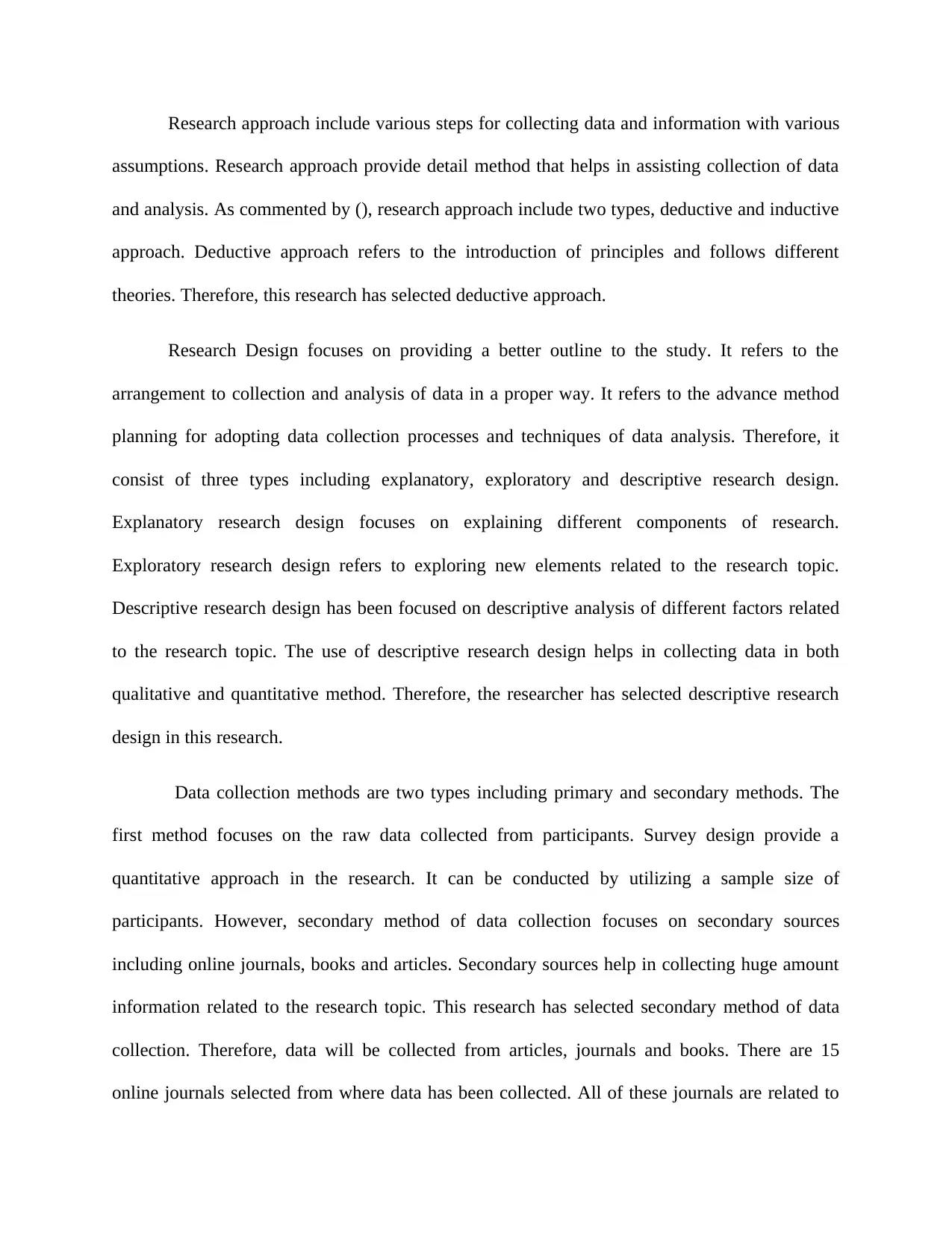
Research approach include various steps for collecting data and information with various
assumptions. Research approach provide detail method that helps in assisting collection of data
and analysis. As commented by (), research approach include two types, deductive and inductive
approach. Deductive approach refers to the introduction of principles and follows different
theories. Therefore, this research has selected deductive approach.
Research Design focuses on providing a better outline to the study. It refers to the
arrangement to collection and analysis of data in a proper way. It refers to the advance method
planning for adopting data collection processes and techniques of data analysis. Therefore, it
consist of three types including explanatory, exploratory and descriptive research design.
Explanatory research design focuses on explaining different components of research.
Exploratory research design refers to exploring new elements related to the research topic.
Descriptive research design has been focused on descriptive analysis of different factors related
to the research topic. The use of descriptive research design helps in collecting data in both
qualitative and quantitative method. Therefore, the researcher has selected descriptive research
design in this research.
Data collection methods are two types including primary and secondary methods. The
first method focuses on the raw data collected from participants. Survey design provide a
quantitative approach in the research. It can be conducted by utilizing a sample size of
participants. However, secondary method of data collection focuses on secondary sources
including online journals, books and articles. Secondary sources help in collecting huge amount
information related to the research topic. This research has selected secondary method of data
collection. Therefore, data will be collected from articles, journals and books. There are 15
online journals selected from where data has been collected. All of these journals are related to
assumptions. Research approach provide detail method that helps in assisting collection of data
and analysis. As commented by (), research approach include two types, deductive and inductive
approach. Deductive approach refers to the introduction of principles and follows different
theories. Therefore, this research has selected deductive approach.
Research Design focuses on providing a better outline to the study. It refers to the
arrangement to collection and analysis of data in a proper way. It refers to the advance method
planning for adopting data collection processes and techniques of data analysis. Therefore, it
consist of three types including explanatory, exploratory and descriptive research design.
Explanatory research design focuses on explaining different components of research.
Exploratory research design refers to exploring new elements related to the research topic.
Descriptive research design has been focused on descriptive analysis of different factors related
to the research topic. The use of descriptive research design helps in collecting data in both
qualitative and quantitative method. Therefore, the researcher has selected descriptive research
design in this research.
Data collection methods are two types including primary and secondary methods. The
first method focuses on the raw data collected from participants. Survey design provide a
quantitative approach in the research. It can be conducted by utilizing a sample size of
participants. However, secondary method of data collection focuses on secondary sources
including online journals, books and articles. Secondary sources help in collecting huge amount
information related to the research topic. This research has selected secondary method of data
collection. Therefore, data will be collected from articles, journals and books. There are 15
online journals selected from where data has been collected. All of these journals are related to
Secure Best Marks with AI Grader
Need help grading? Try our AI Grader for instant feedback on your assignments.
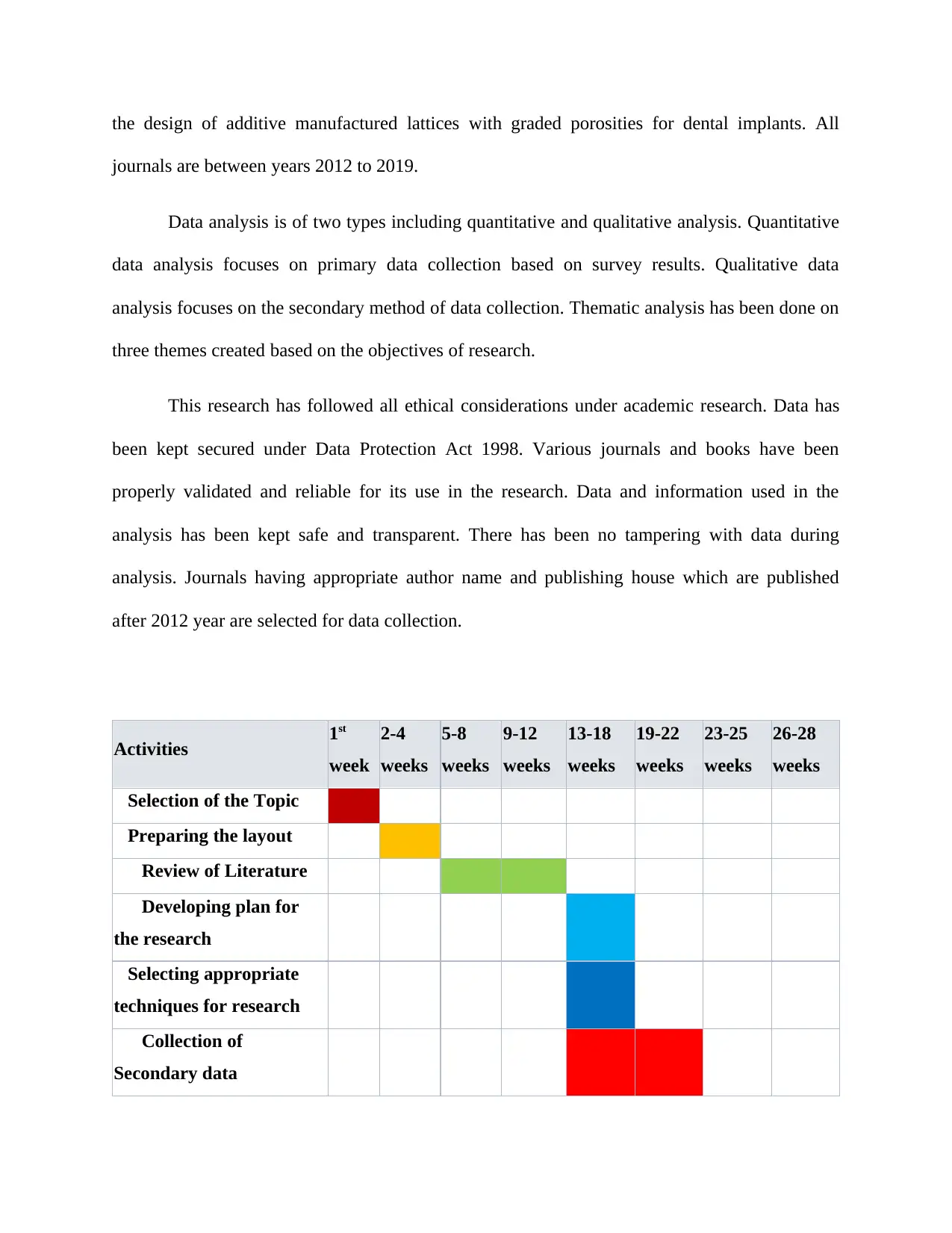
the design of additive manufactured lattices with graded porosities for dental implants. All
journals are between years 2012 to 2019.
Data analysis is of two types including quantitative and qualitative analysis. Quantitative
data analysis focuses on primary data collection based on survey results. Qualitative data
analysis focuses on the secondary method of data collection. Thematic analysis has been done on
three themes created based on the objectives of research.
This research has followed all ethical considerations under academic research. Data has
been kept secured under Data Protection Act 1998. Various journals and books have been
properly validated and reliable for its use in the research. Data and information used in the
analysis has been kept safe and transparent. There has been no tampering with data during
analysis. Journals having appropriate author name and publishing house which are published
after 2012 year are selected for data collection.
Activities 1st
week
2-4
weeks
5-8
weeks
9-12
weeks
13-18
weeks
19-22
weeks
23-25
weeks
26-28
weeks
Selection of the Topic
Preparing the layout
Review of Literature
Developing plan for
the research
Selecting appropriate
techniques for research
Collection of
Secondary data
journals are between years 2012 to 2019.
Data analysis is of two types including quantitative and qualitative analysis. Quantitative
data analysis focuses on primary data collection based on survey results. Qualitative data
analysis focuses on the secondary method of data collection. Thematic analysis has been done on
three themes created based on the objectives of research.
This research has followed all ethical considerations under academic research. Data has
been kept secured under Data Protection Act 1998. Various journals and books have been
properly validated and reliable for its use in the research. Data and information used in the
analysis has been kept safe and transparent. There has been no tampering with data during
analysis. Journals having appropriate author name and publishing house which are published
after 2012 year are selected for data collection.
Activities 1st
week
2-4
weeks
5-8
weeks
9-12
weeks
13-18
weeks
19-22
weeks
23-25
weeks
26-28
weeks
Selection of the Topic
Preparing the layout
Review of Literature
Developing plan for
the research
Selecting appropriate
techniques for research
Collection of
Secondary data
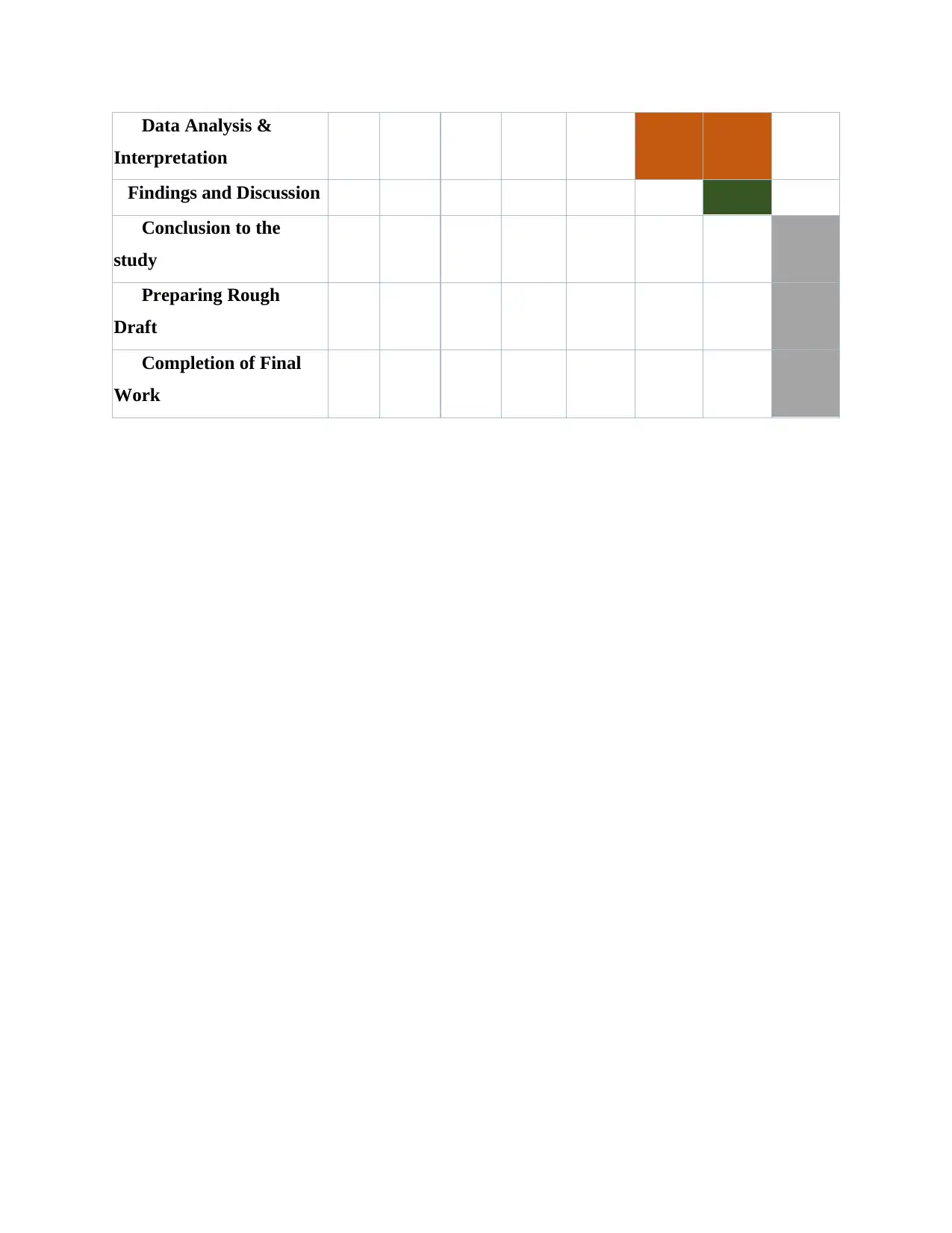
Data Analysis &
Interpretation
Findings and Discussion
Conclusion to the
study
Preparing Rough
Draft
Completion of Final
Work
Interpretation
Findings and Discussion
Conclusion to the
study
Preparing Rough
Draft
Completion of Final
Work
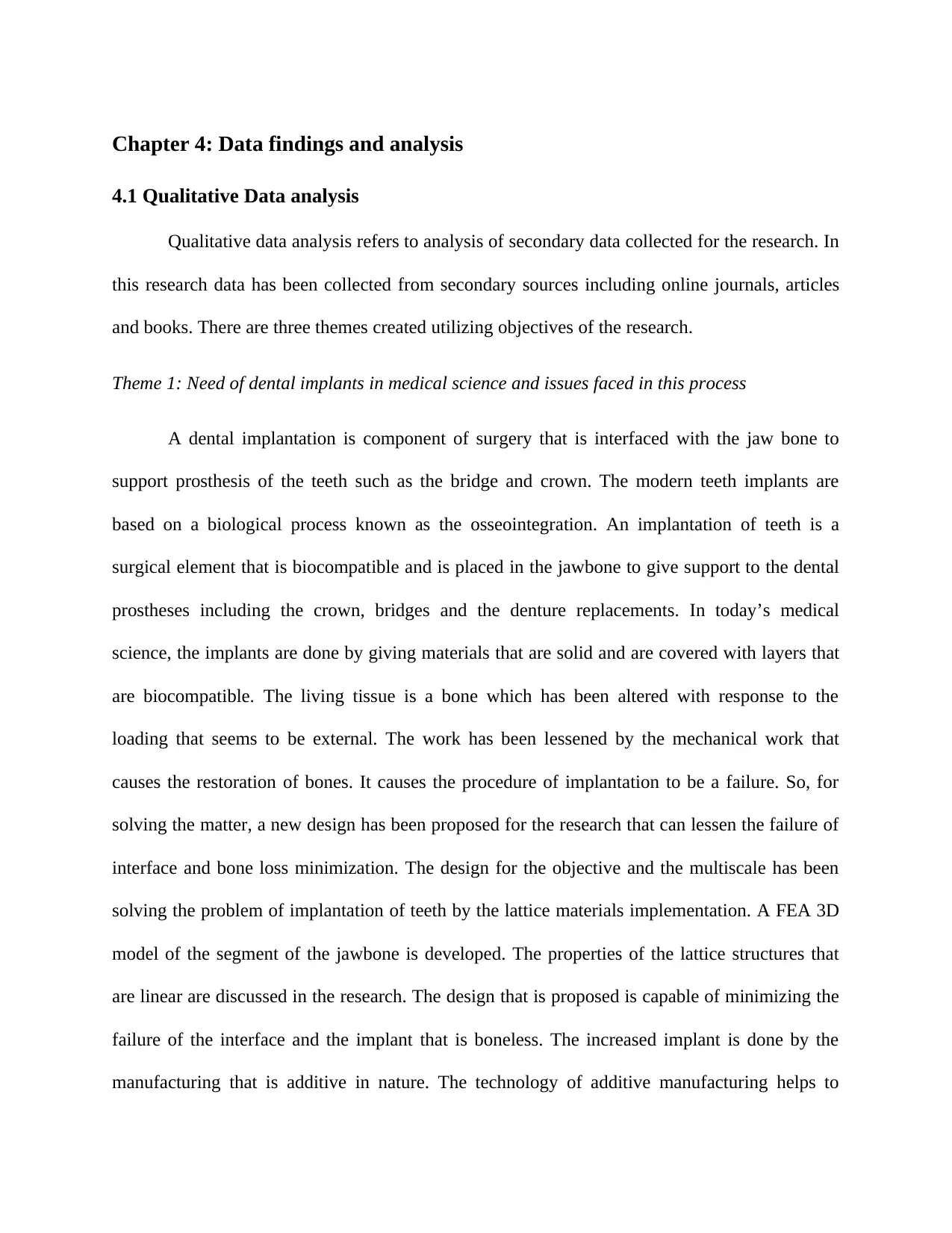
Chapter 4: Data findings and analysis
4.1 Qualitative Data analysis
Qualitative data analysis refers to analysis of secondary data collected for the research. In
this research data has been collected from secondary sources including online journals, articles
and books. There are three themes created utilizing objectives of the research.
Theme 1: Need of dental implants in medical science and issues faced in this process
A dental implantation is component of surgery that is interfaced with the jaw bone to
support prosthesis of the teeth such as the bridge and crown. The modern teeth implants are
based on a biological process known as the osseointegration. An implantation of teeth is a
surgical element that is biocompatible and is placed in the jawbone to give support to the dental
prostheses including the crown, bridges and the denture replacements. In today’s medical
science, the implants are done by giving materials that are solid and are covered with layers that
are biocompatible. The living tissue is a bone which has been altered with response to the
loading that seems to be external. The work has been lessened by the mechanical work that
causes the restoration of bones. It causes the procedure of implantation to be a failure. So, for
solving the matter, a new design has been proposed for the research that can lessen the failure of
interface and bone loss minimization. The design for the objective and the multiscale has been
solving the problem of implantation of teeth by the lattice materials implementation. A FEA 3D
model of the segment of the jawbone is developed. The properties of the lattice structures that
are linear are discussed in the research. The design that is proposed is capable of minimizing the
failure of the interface and the implant that is boneless. The increased implant is done by the
manufacturing that is additive in nature. The technology of additive manufacturing helps to
4.1 Qualitative Data analysis
Qualitative data analysis refers to analysis of secondary data collected for the research. In
this research data has been collected from secondary sources including online journals, articles
and books. There are three themes created utilizing objectives of the research.
Theme 1: Need of dental implants in medical science and issues faced in this process
A dental implantation is component of surgery that is interfaced with the jaw bone to
support prosthesis of the teeth such as the bridge and crown. The modern teeth implants are
based on a biological process known as the osseointegration. An implantation of teeth is a
surgical element that is biocompatible and is placed in the jawbone to give support to the dental
prostheses including the crown, bridges and the denture replacements. In today’s medical
science, the implants are done by giving materials that are solid and are covered with layers that
are biocompatible. The living tissue is a bone which has been altered with response to the
loading that seems to be external. The work has been lessened by the mechanical work that
causes the restoration of bones. It causes the procedure of implantation to be a failure. So, for
solving the matter, a new design has been proposed for the research that can lessen the failure of
interface and bone loss minimization. The design for the objective and the multiscale has been
solving the problem of implantation of teeth by the lattice materials implementation. A FEA 3D
model of the segment of the jawbone is developed. The properties of the lattice structures that
are linear are discussed in the research. The design that is proposed is capable of minimizing the
failure of the interface and the implant that is boneless. The increased implant is done by the
manufacturing that is additive in nature. The technology of additive manufacturing helps to
Paraphrase This Document
Need a fresh take? Get an instant paraphrase of this document with our AI Paraphraser
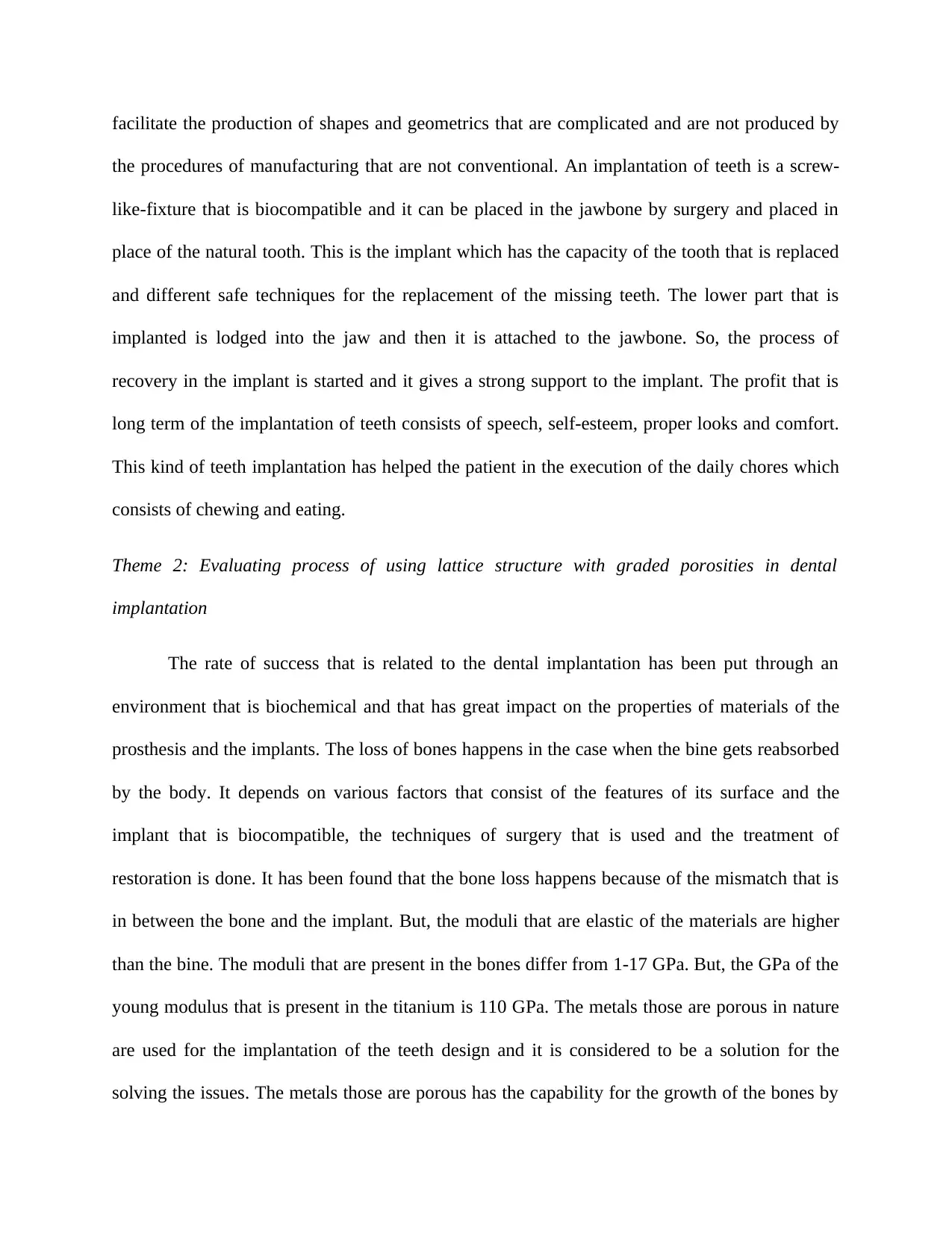
facilitate the production of shapes and geometrics that are complicated and are not produced by
the procedures of manufacturing that are not conventional. An implantation of teeth is a screw-
like-fixture that is biocompatible and it can be placed in the jawbone by surgery and placed in
place of the natural tooth. This is the implant which has the capacity of the tooth that is replaced
and different safe techniques for the replacement of the missing teeth. The lower part that is
implanted is lodged into the jaw and then it is attached to the jawbone. So, the process of
recovery in the implant is started and it gives a strong support to the implant. The profit that is
long term of the implantation of teeth consists of speech, self-esteem, proper looks and comfort.
This kind of teeth implantation has helped the patient in the execution of the daily chores which
consists of chewing and eating.
Theme 2: Evaluating process of using lattice structure with graded porosities in dental
implantation
The rate of success that is related to the dental implantation has been put through an
environment that is biochemical and that has great impact on the properties of materials of the
prosthesis and the implants. The loss of bones happens in the case when the bine gets reabsorbed
by the body. It depends on various factors that consist of the features of its surface and the
implant that is biocompatible, the techniques of surgery that is used and the treatment of
restoration is done. It has been found that the bone loss happens because of the mismatch that is
in between the bone and the implant. But, the moduli that are elastic of the materials are higher
than the bine. The moduli that are present in the bones differ from 1-17 GPa. But, the GPa of the
young modulus that is present in the titanium is 110 GPa. The metals those are porous in nature
are used for the implantation of the teeth design and it is considered to be a solution for the
solving the issues. The metals those are porous has the capability for the growth of the bones by
the procedures of manufacturing that are not conventional. An implantation of teeth is a screw-
like-fixture that is biocompatible and it can be placed in the jawbone by surgery and placed in
place of the natural tooth. This is the implant which has the capacity of the tooth that is replaced
and different safe techniques for the replacement of the missing teeth. The lower part that is
implanted is lodged into the jaw and then it is attached to the jawbone. So, the process of
recovery in the implant is started and it gives a strong support to the implant. The profit that is
long term of the implantation of teeth consists of speech, self-esteem, proper looks and comfort.
This kind of teeth implantation has helped the patient in the execution of the daily chores which
consists of chewing and eating.
Theme 2: Evaluating process of using lattice structure with graded porosities in dental
implantation
The rate of success that is related to the dental implantation has been put through an
environment that is biochemical and that has great impact on the properties of materials of the
prosthesis and the implants. The loss of bones happens in the case when the bine gets reabsorbed
by the body. It depends on various factors that consist of the features of its surface and the
implant that is biocompatible, the techniques of surgery that is used and the treatment of
restoration is done. It has been found that the bone loss happens because of the mismatch that is
in between the bone and the implant. But, the moduli that are elastic of the materials are higher
than the bine. The moduli that are present in the bones differ from 1-17 GPa. But, the GPa of the
young modulus that is present in the titanium is 110 GPa. The metals those are porous in nature
are used for the implantation of the teeth design and it is considered to be a solution for the
solving the issues. The metals those are porous has the capability for the growth of the bones by
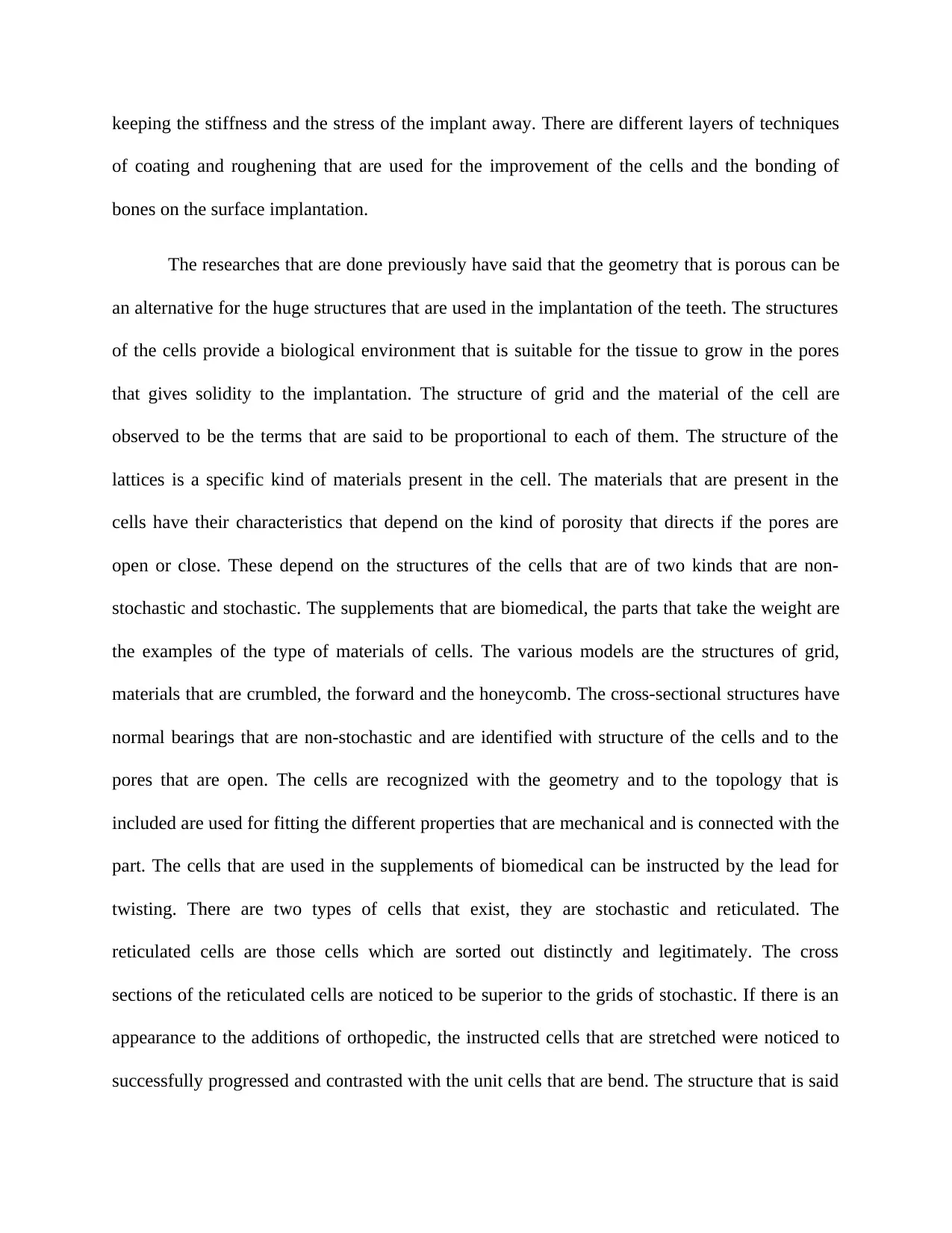
keeping the stiffness and the stress of the implant away. There are different layers of techniques
of coating and roughening that are used for the improvement of the cells and the bonding of
bones on the surface implantation.
The researches that are done previously have said that the geometry that is porous can be
an alternative for the huge structures that are used in the implantation of the teeth. The structures
of the cells provide a biological environment that is suitable for the tissue to grow in the pores
that gives solidity to the implantation. The structure of grid and the material of the cell are
observed to be the terms that are said to be proportional to each of them. The structure of the
lattices is a specific kind of materials present in the cell. The materials that are present in the
cells have their characteristics that depend on the kind of porosity that directs if the pores are
open or close. These depend on the structures of the cells that are of two kinds that are non-
stochastic and stochastic. The supplements that are biomedical, the parts that take the weight are
the examples of the type of materials of cells. The various models are the structures of grid,
materials that are crumbled, the forward and the honeycomb. The cross-sectional structures have
normal bearings that are non-stochastic and are identified with structure of the cells and to the
pores that are open. The cells are recognized with the geometry and to the topology that is
included are used for fitting the different properties that are mechanical and is connected with the
part. The cells that are used in the supplements of biomedical can be instructed by the lead for
twisting. There are two types of cells that exist, they are stochastic and reticulated. The
reticulated cells are those cells which are sorted out distinctly and legitimately. The cross
sections of the reticulated cells are noticed to be superior to the grids of stochastic. If there is an
appearance to the additions of orthopedic, the instructed cells that are stretched were noticed to
successfully progressed and contrasted with the unit cells that are bend. The structure that is said
of coating and roughening that are used for the improvement of the cells and the bonding of
bones on the surface implantation.
The researches that are done previously have said that the geometry that is porous can be
an alternative for the huge structures that are used in the implantation of the teeth. The structures
of the cells provide a biological environment that is suitable for the tissue to grow in the pores
that gives solidity to the implantation. The structure of grid and the material of the cell are
observed to be the terms that are said to be proportional to each of them. The structure of the
lattices is a specific kind of materials present in the cell. The materials that are present in the
cells have their characteristics that depend on the kind of porosity that directs if the pores are
open or close. These depend on the structures of the cells that are of two kinds that are non-
stochastic and stochastic. The supplements that are biomedical, the parts that take the weight are
the examples of the type of materials of cells. The various models are the structures of grid,
materials that are crumbled, the forward and the honeycomb. The cross-sectional structures have
normal bearings that are non-stochastic and are identified with structure of the cells and to the
pores that are open. The cells are recognized with the geometry and to the topology that is
included are used for fitting the different properties that are mechanical and is connected with the
part. The cells that are used in the supplements of biomedical can be instructed by the lead for
twisting. There are two types of cells that exist, they are stochastic and reticulated. The
reticulated cells are those cells which are sorted out distinctly and legitimately. The cross
sections of the reticulated cells are noticed to be superior to the grids of stochastic. If there is an
appearance to the additions of orthopedic, the instructed cells that are stretched were noticed to
successfully progressed and contrasted with the unit cells that are bend. The structure that is said
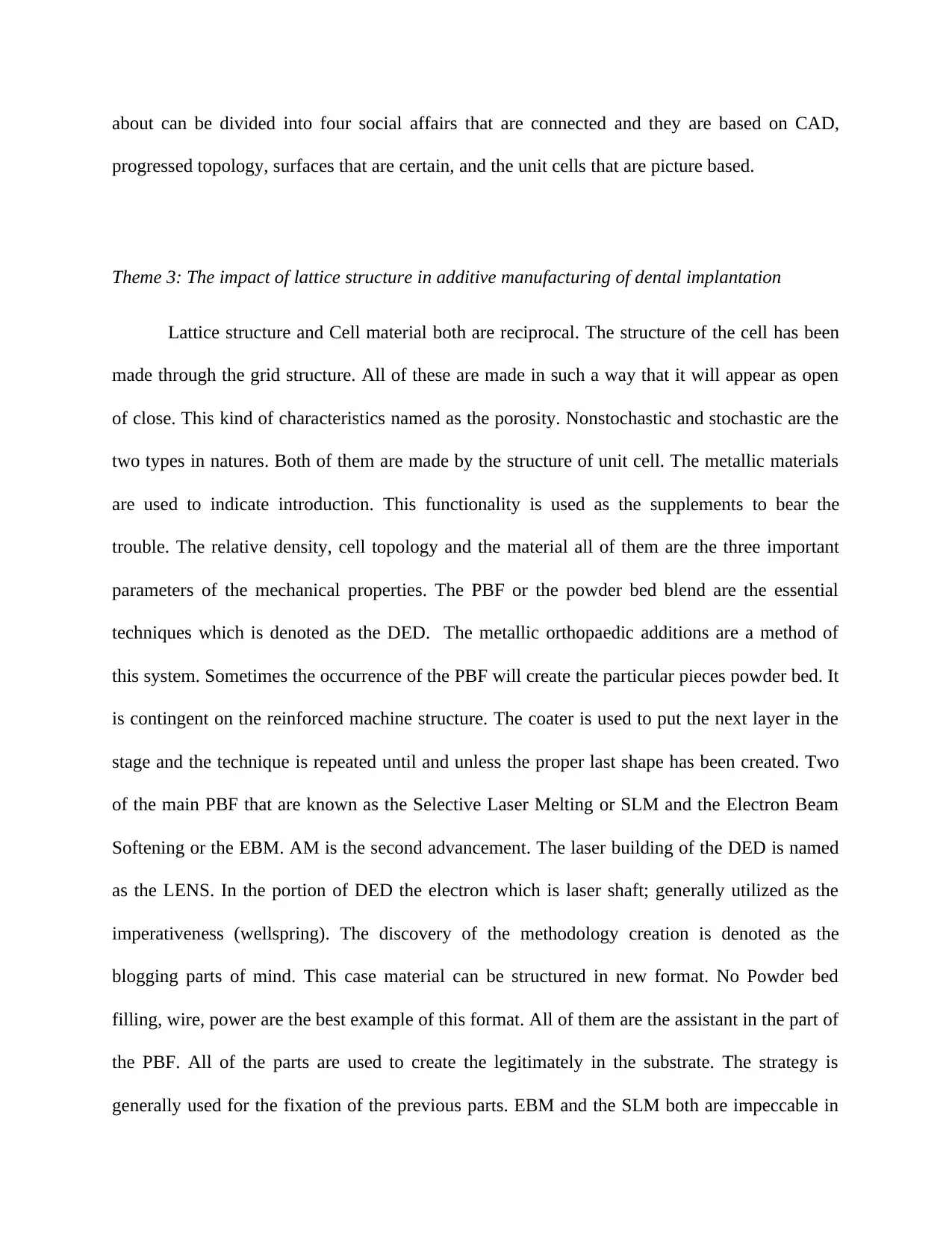
about can be divided into four social affairs that are connected and they are based on CAD,
progressed topology, surfaces that are certain, and the unit cells that are picture based.
Theme 3: The impact of lattice structure in additive manufacturing of dental implantation
Lattice structure and Cell material both are reciprocal. The structure of the cell has been
made through the grid structure. All of these are made in such a way that it will appear as open
of close. This kind of characteristics named as the porosity. Nonstochastic and stochastic are the
two types in natures. Both of them are made by the structure of unit cell. The metallic materials
are used to indicate introduction. This functionality is used as the supplements to bear the
trouble. The relative density, cell topology and the material all of them are the three important
parameters of the mechanical properties. The PBF or the powder bed blend are the essential
techniques which is denoted as the DED. The metallic orthopaedic additions are a method of
this system. Sometimes the occurrence of the PBF will create the particular pieces powder bed. It
is contingent on the reinforced machine structure. The coater is used to put the next layer in the
stage and the technique is repeated until and unless the proper last shape has been created. Two
of the main PBF that are known as the Selective Laser Melting or SLM and the Electron Beam
Softening or the EBM. AM is the second advancement. The laser building of the DED is named
as the LENS. In the portion of DED the electron which is laser shaft; generally utilized as the
imperativeness (wellspring). The discovery of the methodology creation is denoted as the
blogging parts of mind. This case material can be structured in new format. No Powder bed
filling, wire, power are the best example of this format. All of them are the assistant in the part of
the PBF. All of the parts are used to create the legitimately in the substrate. The strategy is
generally used for the fixation of the previous parts. EBM and the SLM both are impeccable in
progressed topology, surfaces that are certain, and the unit cells that are picture based.
Theme 3: The impact of lattice structure in additive manufacturing of dental implantation
Lattice structure and Cell material both are reciprocal. The structure of the cell has been
made through the grid structure. All of these are made in such a way that it will appear as open
of close. This kind of characteristics named as the porosity. Nonstochastic and stochastic are the
two types in natures. Both of them are made by the structure of unit cell. The metallic materials
are used to indicate introduction. This functionality is used as the supplements to bear the
trouble. The relative density, cell topology and the material all of them are the three important
parameters of the mechanical properties. The PBF or the powder bed blend are the essential
techniques which is denoted as the DED. The metallic orthopaedic additions are a method of
this system. Sometimes the occurrence of the PBF will create the particular pieces powder bed. It
is contingent on the reinforced machine structure. The coater is used to put the next layer in the
stage and the technique is repeated until and unless the proper last shape has been created. Two
of the main PBF that are known as the Selective Laser Melting or SLM and the Electron Beam
Softening or the EBM. AM is the second advancement. The laser building of the DED is named
as the LENS. In the portion of DED the electron which is laser shaft; generally utilized as the
imperativeness (wellspring). The discovery of the methodology creation is denoted as the
blogging parts of mind. This case material can be structured in new format. No Powder bed
filling, wire, power are the best example of this format. All of them are the assistant in the part of
the PBF. All of the parts are used to create the legitimately in the substrate. The strategy is
generally used for the fixation of the previous parts. EBM and the SLM both are impeccable in
Secure Best Marks with AI Grader
Need help grading? Try our AI Grader for instant feedback on your assignments.
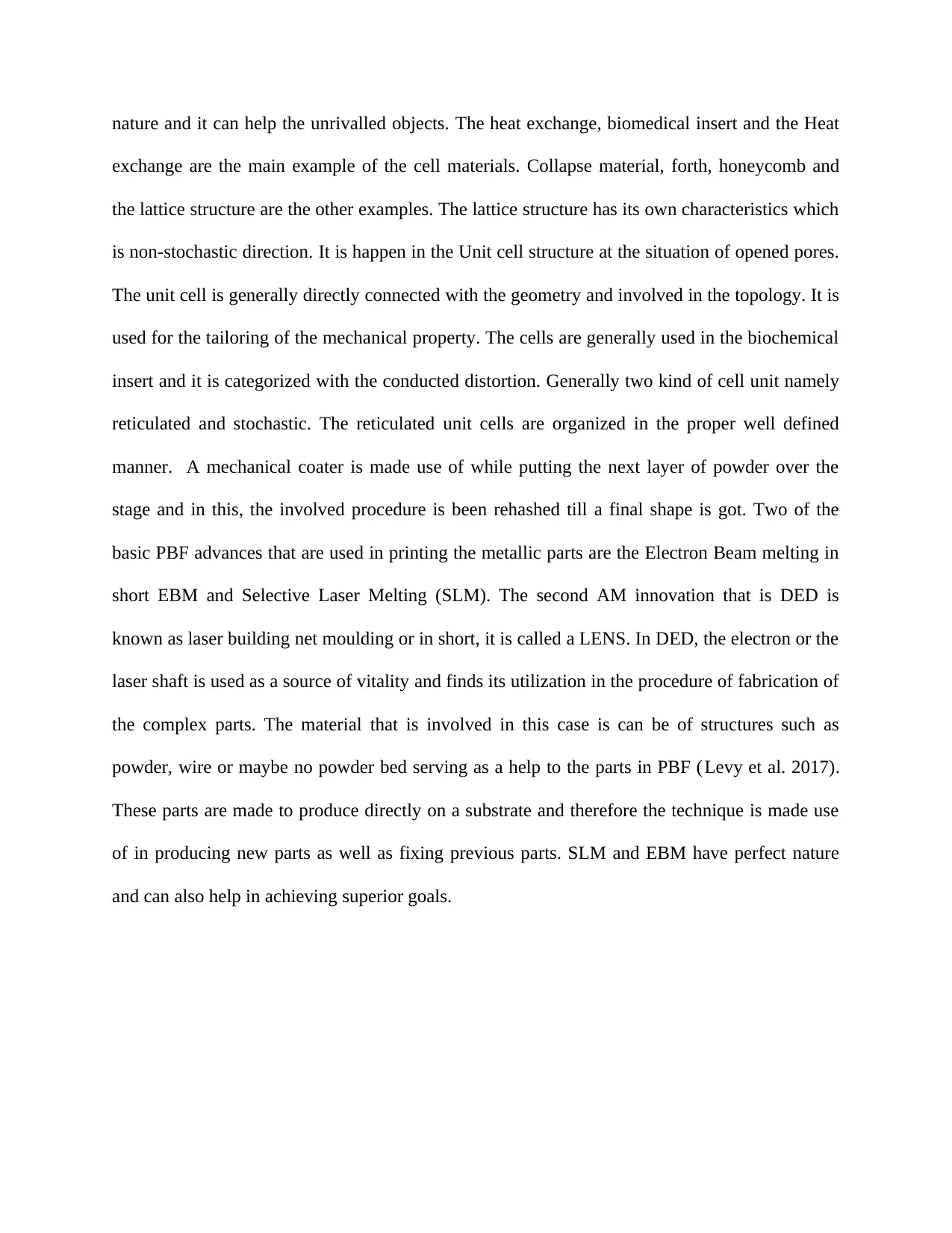
nature and it can help the unrivalled objects. The heat exchange, biomedical insert and the Heat
exchange are the main example of the cell materials. Collapse material, forth, honeycomb and
the lattice structure are the other examples. The lattice structure has its own characteristics which
is non-stochastic direction. It is happen in the Unit cell structure at the situation of opened pores.
The unit cell is generally directly connected with the geometry and involved in the topology. It is
used for the tailoring of the mechanical property. The cells are generally used in the biochemical
insert and it is categorized with the conducted distortion. Generally two kind of cell unit namely
reticulated and stochastic. The reticulated unit cells are organized in the proper well defined
manner. A mechanical coater is made use of while putting the next layer of powder over the
stage and in this, the involved procedure is been rehashed till a final shape is got. Two of the
basic PBF advances that are used in printing the metallic parts are the Electron Beam melting in
short EBM and Selective Laser Melting (SLM). The second AM innovation that is DED is
known as laser building net moulding or in short, it is called a LENS. In DED, the electron or the
laser shaft is used as a source of vitality and finds its utilization in the procedure of fabrication of
the complex parts. The material that is involved in this case is can be of structures such as
powder, wire or maybe no powder bed serving as a help to the parts in PBF (Levy et al. 2017).
These parts are made to produce directly on a substrate and therefore the technique is made use
of in producing new parts as well as fixing previous parts. SLM and EBM have perfect nature
and can also help in achieving superior goals.
exchange are the main example of the cell materials. Collapse material, forth, honeycomb and
the lattice structure are the other examples. The lattice structure has its own characteristics which
is non-stochastic direction. It is happen in the Unit cell structure at the situation of opened pores.
The unit cell is generally directly connected with the geometry and involved in the topology. It is
used for the tailoring of the mechanical property. The cells are generally used in the biochemical
insert and it is categorized with the conducted distortion. Generally two kind of cell unit namely
reticulated and stochastic. The reticulated unit cells are organized in the proper well defined
manner. A mechanical coater is made use of while putting the next layer of powder over the
stage and in this, the involved procedure is been rehashed till a final shape is got. Two of the
basic PBF advances that are used in printing the metallic parts are the Electron Beam melting in
short EBM and Selective Laser Melting (SLM). The second AM innovation that is DED is
known as laser building net moulding or in short, it is called a LENS. In DED, the electron or the
laser shaft is used as a source of vitality and finds its utilization in the procedure of fabrication of
the complex parts. The material that is involved in this case is can be of structures such as
powder, wire or maybe no powder bed serving as a help to the parts in PBF (Levy et al. 2017).
These parts are made to produce directly on a substrate and therefore the technique is made use
of in producing new parts as well as fixing previous parts. SLM and EBM have perfect nature
and can also help in achieving superior goals.
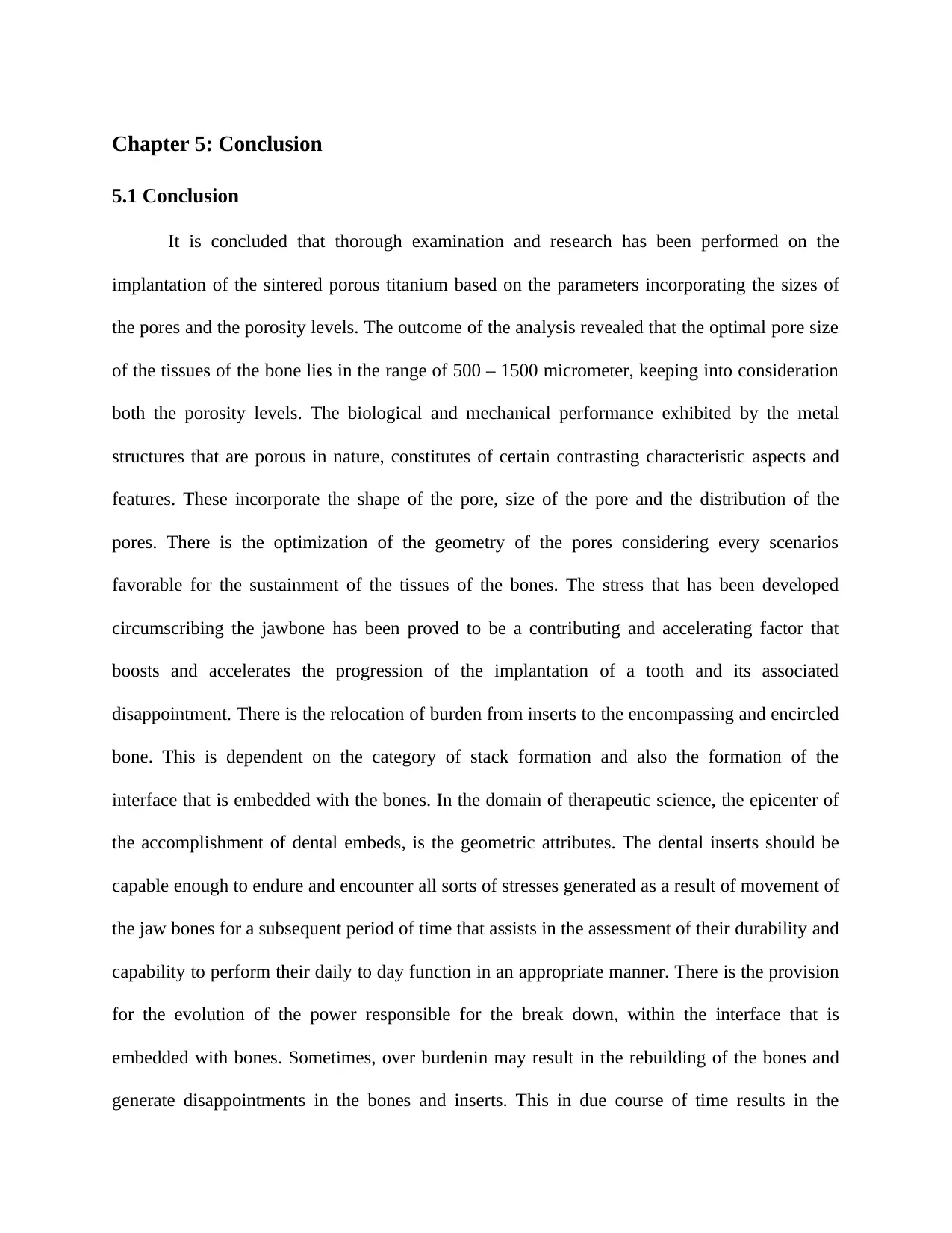
Chapter 5: Conclusion
5.1 Conclusion
It is concluded that thorough examination and research has been performed on the
implantation of the sintered porous titanium based on the parameters incorporating the sizes of
the pores and the porosity levels. The outcome of the analysis revealed that the optimal pore size
of the tissues of the bone lies in the range of 500 – 1500 micrometer, keeping into consideration
both the porosity levels. The biological and mechanical performance exhibited by the metal
structures that are porous in nature, constitutes of certain contrasting characteristic aspects and
features. These incorporate the shape of the pore, size of the pore and the distribution of the
pores. There is the optimization of the geometry of the pores considering every scenarios
favorable for the sustainment of the tissues of the bones. The stress that has been developed
circumscribing the jawbone has been proved to be a contributing and accelerating factor that
boosts and accelerates the progression of the implantation of a tooth and its associated
disappointment. There is the relocation of burden from inserts to the encompassing and encircled
bone. This is dependent on the category of stack formation and also the formation of the
interface that is embedded with the bones. In the domain of therapeutic science, the epicenter of
the accomplishment of dental embeds, is the geometric attributes. The dental inserts should be
capable enough to endure and encounter all sorts of stresses generated as a result of movement of
the jaw bones for a subsequent period of time that assists in the assessment of their durability and
capability to perform their daily to day function in an appropriate manner. There is the provision
for the evolution of the power responsible for the break down, within the interface that is
embedded with bones. Sometimes, over burdenin may result in the rebuilding of the bones and
generate disappointments in the bones and inserts. This in due course of time results in the
5.1 Conclusion
It is concluded that thorough examination and research has been performed on the
implantation of the sintered porous titanium based on the parameters incorporating the sizes of
the pores and the porosity levels. The outcome of the analysis revealed that the optimal pore size
of the tissues of the bone lies in the range of 500 – 1500 micrometer, keeping into consideration
both the porosity levels. The biological and mechanical performance exhibited by the metal
structures that are porous in nature, constitutes of certain contrasting characteristic aspects and
features. These incorporate the shape of the pore, size of the pore and the distribution of the
pores. There is the optimization of the geometry of the pores considering every scenarios
favorable for the sustainment of the tissues of the bones. The stress that has been developed
circumscribing the jawbone has been proved to be a contributing and accelerating factor that
boosts and accelerates the progression of the implantation of a tooth and its associated
disappointment. There is the relocation of burden from inserts to the encompassing and encircled
bone. This is dependent on the category of stack formation and also the formation of the
interface that is embedded with the bones. In the domain of therapeutic science, the epicenter of
the accomplishment of dental embeds, is the geometric attributes. The dental inserts should be
capable enough to endure and encounter all sorts of stresses generated as a result of movement of
the jaw bones for a subsequent period of time that assists in the assessment of their durability and
capability to perform their daily to day function in an appropriate manner. There is the provision
for the evolution of the power responsible for the break down, within the interface that is
embedded with bones. Sometimes, over burdenin may result in the rebuilding of the bones and
generate disappointments in the bones and inserts. This in due course of time results in the
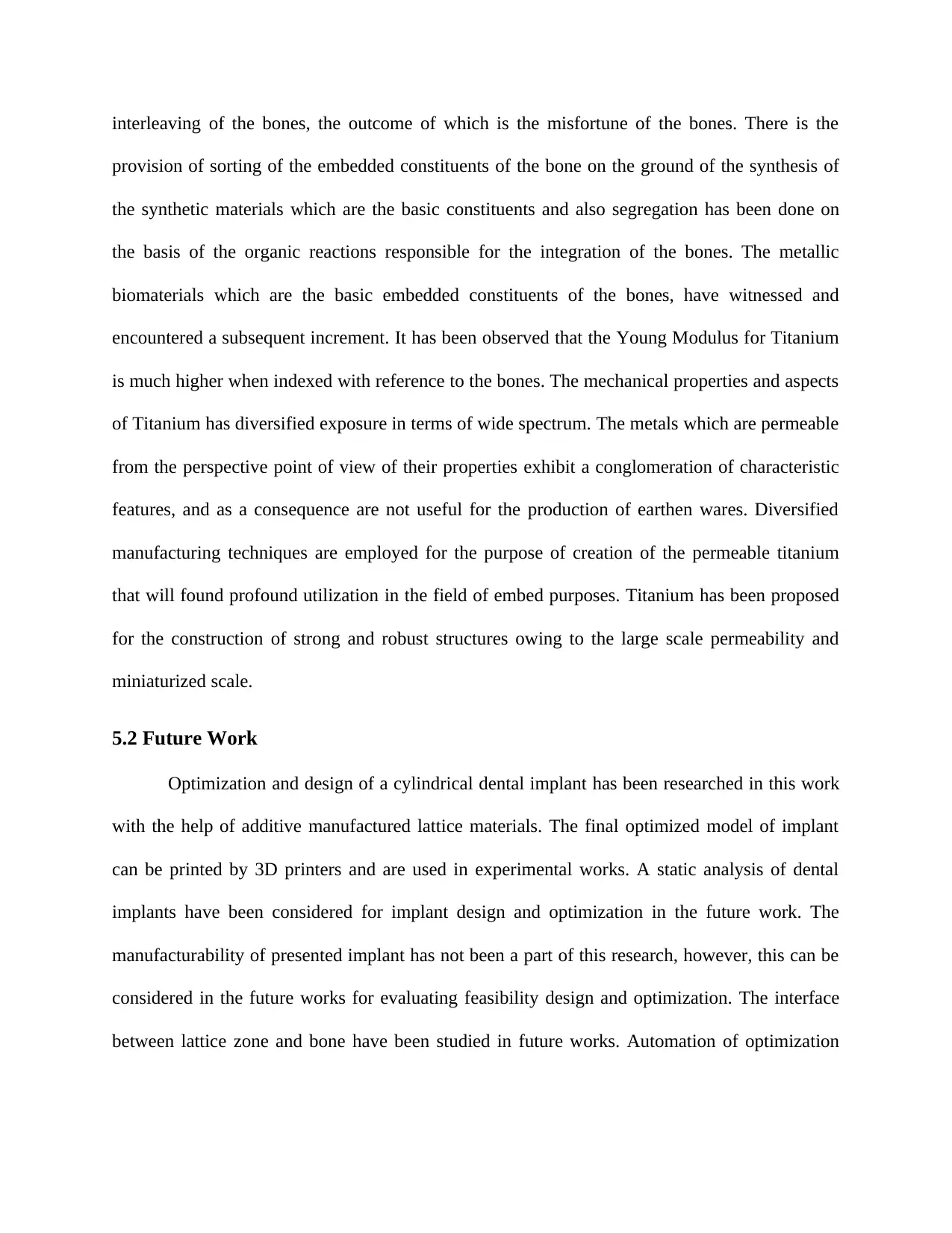
interleaving of the bones, the outcome of which is the misfortune of the bones. There is the
provision of sorting of the embedded constituents of the bone on the ground of the synthesis of
the synthetic materials which are the basic constituents and also segregation has been done on
the basis of the organic reactions responsible for the integration of the bones. The metallic
biomaterials which are the basic embedded constituents of the bones, have witnessed and
encountered a subsequent increment. It has been observed that the Young Modulus for Titanium
is much higher when indexed with reference to the bones. The mechanical properties and aspects
of Titanium has diversified exposure in terms of wide spectrum. The metals which are permeable
from the perspective point of view of their properties exhibit a conglomeration of characteristic
features, and as a consequence are not useful for the production of earthen wares. Diversified
manufacturing techniques are employed for the purpose of creation of the permeable titanium
that will found profound utilization in the field of embed purposes. Titanium has been proposed
for the construction of strong and robust structures owing to the large scale permeability and
miniaturized scale.
5.2 Future Work
Optimization and design of a cylindrical dental implant has been researched in this work
with the help of additive manufactured lattice materials. The final optimized model of implant
can be printed by 3D printers and are used in experimental works. A static analysis of dental
implants have been considered for implant design and optimization in the future work. The
manufacturability of presented implant has not been a part of this research, however, this can be
considered in the future works for evaluating feasibility design and optimization. The interface
between lattice zone and bone have been studied in future works. Automation of optimization
provision of sorting of the embedded constituents of the bone on the ground of the synthesis of
the synthetic materials which are the basic constituents and also segregation has been done on
the basis of the organic reactions responsible for the integration of the bones. The metallic
biomaterials which are the basic embedded constituents of the bones, have witnessed and
encountered a subsequent increment. It has been observed that the Young Modulus for Titanium
is much higher when indexed with reference to the bones. The mechanical properties and aspects
of Titanium has diversified exposure in terms of wide spectrum. The metals which are permeable
from the perspective point of view of their properties exhibit a conglomeration of characteristic
features, and as a consequence are not useful for the production of earthen wares. Diversified
manufacturing techniques are employed for the purpose of creation of the permeable titanium
that will found profound utilization in the field of embed purposes. Titanium has been proposed
for the construction of strong and robust structures owing to the large scale permeability and
miniaturized scale.
5.2 Future Work
Optimization and design of a cylindrical dental implant has been researched in this work
with the help of additive manufactured lattice materials. The final optimized model of implant
can be printed by 3D printers and are used in experimental works. A static analysis of dental
implants have been considered for implant design and optimization in the future work. The
manufacturability of presented implant has not been a part of this research, however, this can be
considered in the future works for evaluating feasibility design and optimization. The interface
between lattice zone and bone have been studied in future works. Automation of optimization
Paraphrase This Document
Need a fresh take? Get an instant paraphrase of this document with our AI Paraphraser

process have been using several software that can be implemented in the future works for
including more design variables in works.
including more design variables in works.
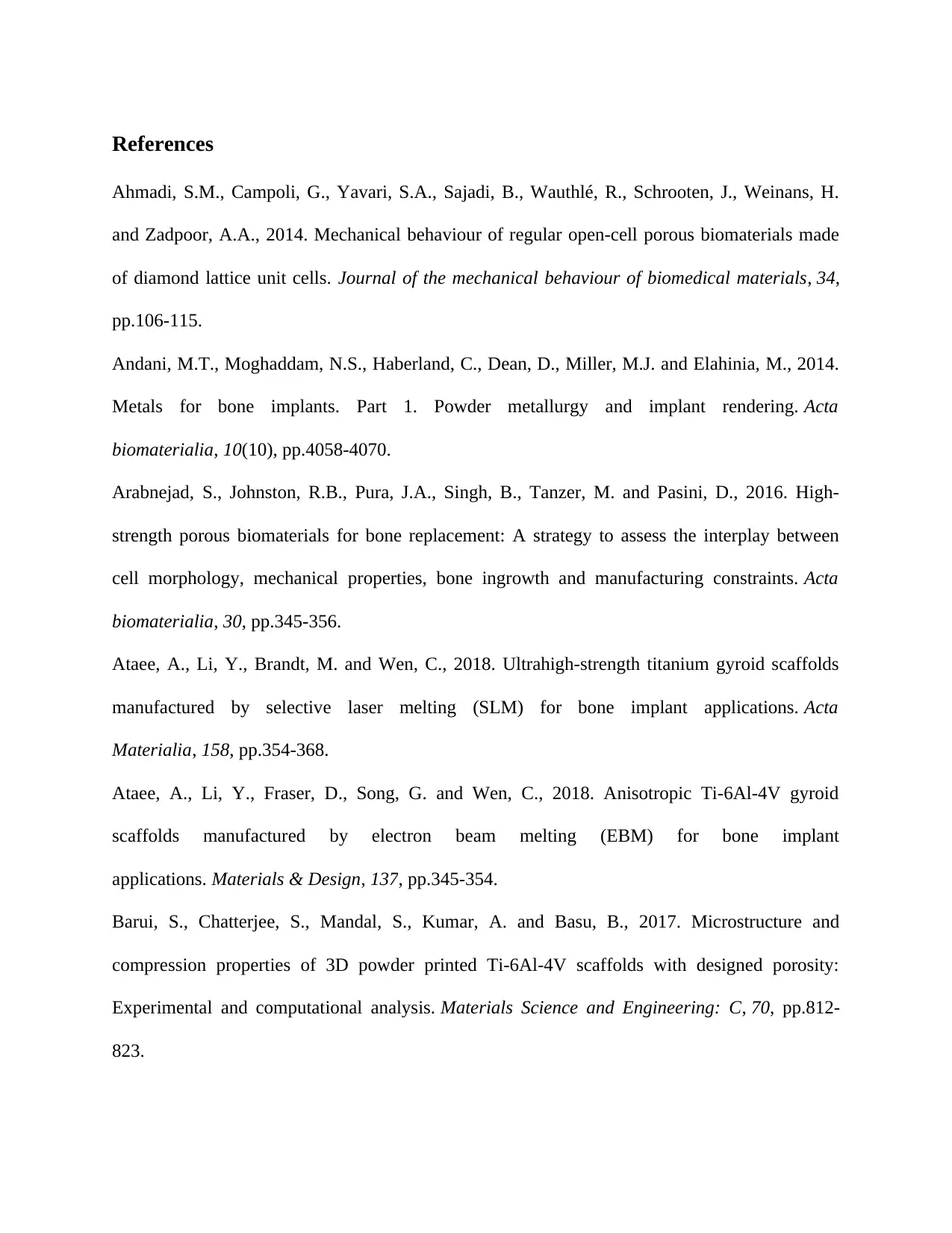
References
Ahmadi, S.M., Campoli, G., Yavari, S.A., Sajadi, B., Wauthlé, R., Schrooten, J., Weinans, H.
and Zadpoor, A.A., 2014. Mechanical behaviour of regular open-cell porous biomaterials made
of diamond lattice unit cells. Journal of the mechanical behaviour of biomedical materials, 34,
pp.106-115.
Andani, M.T., Moghaddam, N.S., Haberland, C., Dean, D., Miller, M.J. and Elahinia, M., 2014.
Metals for bone implants. Part 1. Powder metallurgy and implant rendering. Acta
biomaterialia, 10(10), pp.4058-4070.
Arabnejad, S., Johnston, R.B., Pura, J.A., Singh, B., Tanzer, M. and Pasini, D., 2016. High-
strength porous biomaterials for bone replacement: A strategy to assess the interplay between
cell morphology, mechanical properties, bone ingrowth and manufacturing constraints. Acta
biomaterialia, 30, pp.345-356.
Ataee, A., Li, Y., Brandt, M. and Wen, C., 2018. Ultrahigh-strength titanium gyroid scaffolds
manufactured by selective laser melting (SLM) for bone implant applications. Acta
Materialia, 158, pp.354-368.
Ataee, A., Li, Y., Fraser, D., Song, G. and Wen, C., 2018. Anisotropic Ti-6Al-4V gyroid
scaffolds manufactured by electron beam melting (EBM) for bone implant
applications. Materials & Design, 137, pp.345-354.
Barui, S., Chatterjee, S., Mandal, S., Kumar, A. and Basu, B., 2017. Microstructure and
compression properties of 3D powder printed Ti-6Al-4V scaffolds with designed porosity:
Experimental and computational analysis. Materials Science and Engineering: C, 70, pp.812-
823.
Ahmadi, S.M., Campoli, G., Yavari, S.A., Sajadi, B., Wauthlé, R., Schrooten, J., Weinans, H.
and Zadpoor, A.A., 2014. Mechanical behaviour of regular open-cell porous biomaterials made
of diamond lattice unit cells. Journal of the mechanical behaviour of biomedical materials, 34,
pp.106-115.
Andani, M.T., Moghaddam, N.S., Haberland, C., Dean, D., Miller, M.J. and Elahinia, M., 2014.
Metals for bone implants. Part 1. Powder metallurgy and implant rendering. Acta
biomaterialia, 10(10), pp.4058-4070.
Arabnejad, S., Johnston, R.B., Pura, J.A., Singh, B., Tanzer, M. and Pasini, D., 2016. High-
strength porous biomaterials for bone replacement: A strategy to assess the interplay between
cell morphology, mechanical properties, bone ingrowth and manufacturing constraints. Acta
biomaterialia, 30, pp.345-356.
Ataee, A., Li, Y., Brandt, M. and Wen, C., 2018. Ultrahigh-strength titanium gyroid scaffolds
manufactured by selective laser melting (SLM) for bone implant applications. Acta
Materialia, 158, pp.354-368.
Ataee, A., Li, Y., Fraser, D., Song, G. and Wen, C., 2018. Anisotropic Ti-6Al-4V gyroid
scaffolds manufactured by electron beam melting (EBM) for bone implant
applications. Materials & Design, 137, pp.345-354.
Barui, S., Chatterjee, S., Mandal, S., Kumar, A. and Basu, B., 2017. Microstructure and
compression properties of 3D powder printed Ti-6Al-4V scaffolds with designed porosity:
Experimental and computational analysis. Materials Science and Engineering: C, 70, pp.812-
823.
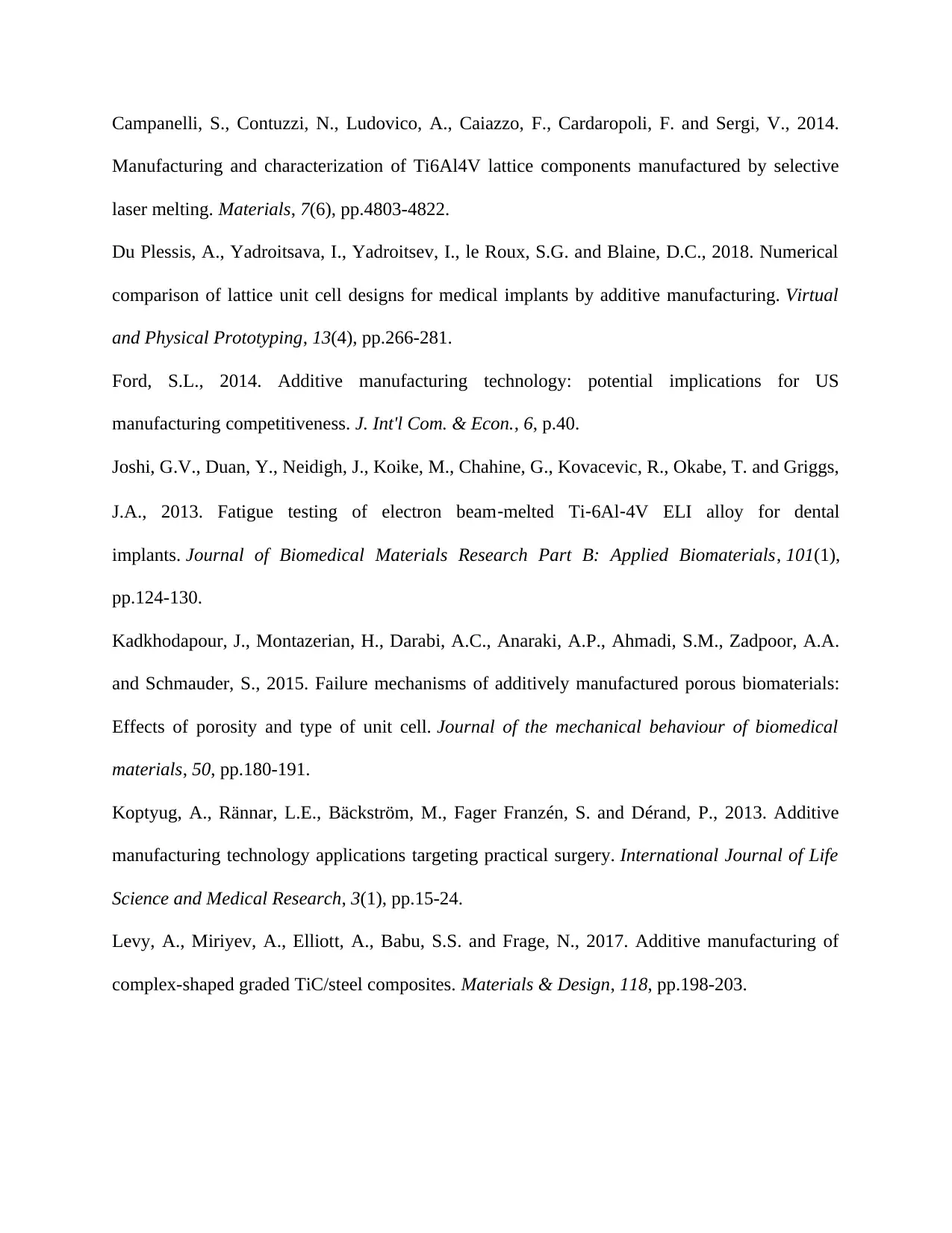
Campanelli, S., Contuzzi, N., Ludovico, A., Caiazzo, F., Cardaropoli, F. and Sergi, V., 2014.
Manufacturing and characterization of Ti6Al4V lattice components manufactured by selective
laser melting. Materials, 7(6), pp.4803-4822.
Du Plessis, A., Yadroitsava, I., Yadroitsev, I., le Roux, S.G. and Blaine, D.C., 2018. Numerical
comparison of lattice unit cell designs for medical implants by additive manufacturing. Virtual
and Physical Prototyping, 13(4), pp.266-281.
Ford, S.L., 2014. Additive manufacturing technology: potential implications for US
manufacturing competitiveness. J. Int'l Com. & Econ., 6, p.40.
Joshi, G.V., Duan, Y., Neidigh, J., Koike, M., Chahine, G., Kovacevic, R., Okabe, T. and Griggs,
J.A., 2013. Fatigue testing of electron beam‐melted Ti‐6Al‐4V ELI alloy for dental
implants. Journal of Biomedical Materials Research Part B: Applied Biomaterials, 101(1),
pp.124-130.
Kadkhodapour, J., Montazerian, H., Darabi, A.C., Anaraki, A.P., Ahmadi, S.M., Zadpoor, A.A.
and Schmauder, S., 2015. Failure mechanisms of additively manufactured porous biomaterials:
Effects of porosity and type of unit cell. Journal of the mechanical behaviour of biomedical
materials, 50, pp.180-191.
Koptyug, A., Rännar, L.E., Bäckström, M., Fager Franzén, S. and Dérand, P., 2013. Additive
manufacturing technology applications targeting practical surgery. International Journal of Life
Science and Medical Research, 3(1), pp.15-24.
Levy, A., Miriyev, A., Elliott, A., Babu, S.S. and Frage, N., 2017. Additive manufacturing of
complex-shaped graded TiC/steel composites. Materials & Design, 118, pp.198-203.
Manufacturing and characterization of Ti6Al4V lattice components manufactured by selective
laser melting. Materials, 7(6), pp.4803-4822.
Du Plessis, A., Yadroitsava, I., Yadroitsev, I., le Roux, S.G. and Blaine, D.C., 2018. Numerical
comparison of lattice unit cell designs for medical implants by additive manufacturing. Virtual
and Physical Prototyping, 13(4), pp.266-281.
Ford, S.L., 2014. Additive manufacturing technology: potential implications for US
manufacturing competitiveness. J. Int'l Com. & Econ., 6, p.40.
Joshi, G.V., Duan, Y., Neidigh, J., Koike, M., Chahine, G., Kovacevic, R., Okabe, T. and Griggs,
J.A., 2013. Fatigue testing of electron beam‐melted Ti‐6Al‐4V ELI alloy for dental
implants. Journal of Biomedical Materials Research Part B: Applied Biomaterials, 101(1),
pp.124-130.
Kadkhodapour, J., Montazerian, H., Darabi, A.C., Anaraki, A.P., Ahmadi, S.M., Zadpoor, A.A.
and Schmauder, S., 2015. Failure mechanisms of additively manufactured porous biomaterials:
Effects of porosity and type of unit cell. Journal of the mechanical behaviour of biomedical
materials, 50, pp.180-191.
Koptyug, A., Rännar, L.E., Bäckström, M., Fager Franzén, S. and Dérand, P., 2013. Additive
manufacturing technology applications targeting practical surgery. International Journal of Life
Science and Medical Research, 3(1), pp.15-24.
Levy, A., Miriyev, A., Elliott, A., Babu, S.S. and Frage, N., 2017. Additive manufacturing of
complex-shaped graded TiC/steel composites. Materials & Design, 118, pp.198-203.
Secure Best Marks with AI Grader
Need help grading? Try our AI Grader for instant feedback on your assignments.
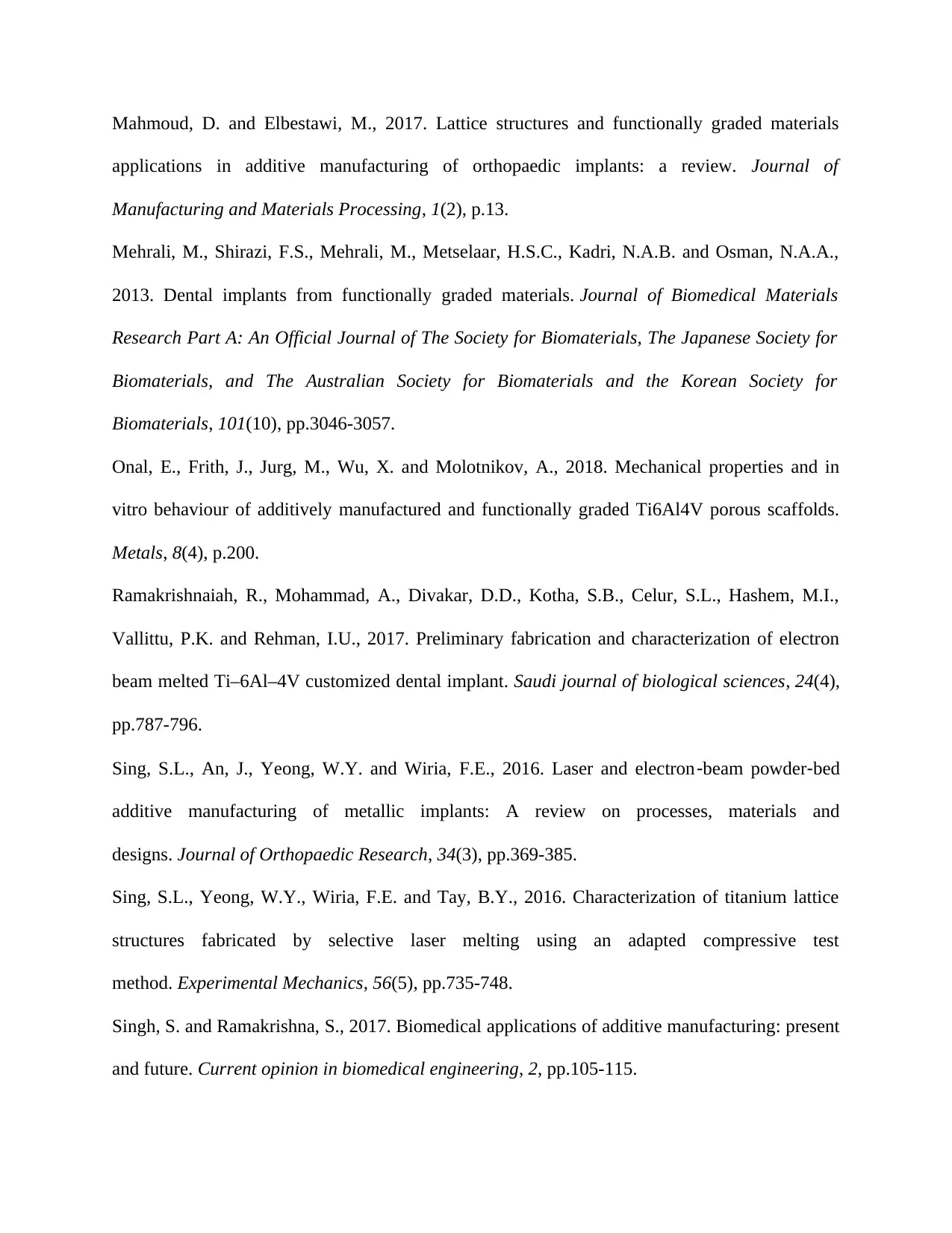
Mahmoud, D. and Elbestawi, M., 2017. Lattice structures and functionally graded materials
applications in additive manufacturing of orthopaedic implants: a review. Journal of
Manufacturing and Materials Processing, 1(2), p.13.
Mehrali, M., Shirazi, F.S., Mehrali, M., Metselaar, H.S.C., Kadri, N.A.B. and Osman, N.A.A.,
2013. Dental implants from functionally graded materials. Journal of Biomedical Materials
Research Part A: An Official Journal of The Society for Biomaterials, The Japanese Society for
Biomaterials, and The Australian Society for Biomaterials and the Korean Society for
Biomaterials, 101(10), pp.3046-3057.
Onal, E., Frith, J., Jurg, M., Wu, X. and Molotnikov, A., 2018. Mechanical properties and in
vitro behaviour of additively manufactured and functionally graded Ti6Al4V porous scaffolds.
Metals, 8(4), p.200.
Ramakrishnaiah, R., Mohammad, A., Divakar, D.D., Kotha, S.B., Celur, S.L., Hashem, M.I.,
Vallittu, P.K. and Rehman, I.U., 2017. Preliminary fabrication and characterization of electron
beam melted Ti–6Al–4V customized dental implant. Saudi journal of biological sciences, 24(4),
pp.787-796.
Sing, S.L., An, J., Yeong, W.Y. and Wiria, F.E., 2016. Laser and electron‐beam powder‐bed
additive manufacturing of metallic implants: A review on processes, materials and
designs. Journal of Orthopaedic Research, 34(3), pp.369-385.
Sing, S.L., Yeong, W.Y., Wiria, F.E. and Tay, B.Y., 2016. Characterization of titanium lattice
structures fabricated by selective laser melting using an adapted compressive test
method. Experimental Mechanics, 56(5), pp.735-748.
Singh, S. and Ramakrishna, S., 2017. Biomedical applications of additive manufacturing: present
and future. Current opinion in biomedical engineering, 2, pp.105-115.
applications in additive manufacturing of orthopaedic implants: a review. Journal of
Manufacturing and Materials Processing, 1(2), p.13.
Mehrali, M., Shirazi, F.S., Mehrali, M., Metselaar, H.S.C., Kadri, N.A.B. and Osman, N.A.A.,
2013. Dental implants from functionally graded materials. Journal of Biomedical Materials
Research Part A: An Official Journal of The Society for Biomaterials, The Japanese Society for
Biomaterials, and The Australian Society for Biomaterials and the Korean Society for
Biomaterials, 101(10), pp.3046-3057.
Onal, E., Frith, J., Jurg, M., Wu, X. and Molotnikov, A., 2018. Mechanical properties and in
vitro behaviour of additively manufactured and functionally graded Ti6Al4V porous scaffolds.
Metals, 8(4), p.200.
Ramakrishnaiah, R., Mohammad, A., Divakar, D.D., Kotha, S.B., Celur, S.L., Hashem, M.I.,
Vallittu, P.K. and Rehman, I.U., 2017. Preliminary fabrication and characterization of electron
beam melted Ti–6Al–4V customized dental implant. Saudi journal of biological sciences, 24(4),
pp.787-796.
Sing, S.L., An, J., Yeong, W.Y. and Wiria, F.E., 2016. Laser and electron‐beam powder‐bed
additive manufacturing of metallic implants: A review on processes, materials and
designs. Journal of Orthopaedic Research, 34(3), pp.369-385.
Sing, S.L., Yeong, W.Y., Wiria, F.E. and Tay, B.Y., 2016. Characterization of titanium lattice
structures fabricated by selective laser melting using an adapted compressive test
method. Experimental Mechanics, 56(5), pp.735-748.
Singh, S. and Ramakrishna, S., 2017. Biomedical applications of additive manufacturing: present
and future. Current opinion in biomedical engineering, 2, pp.105-115.
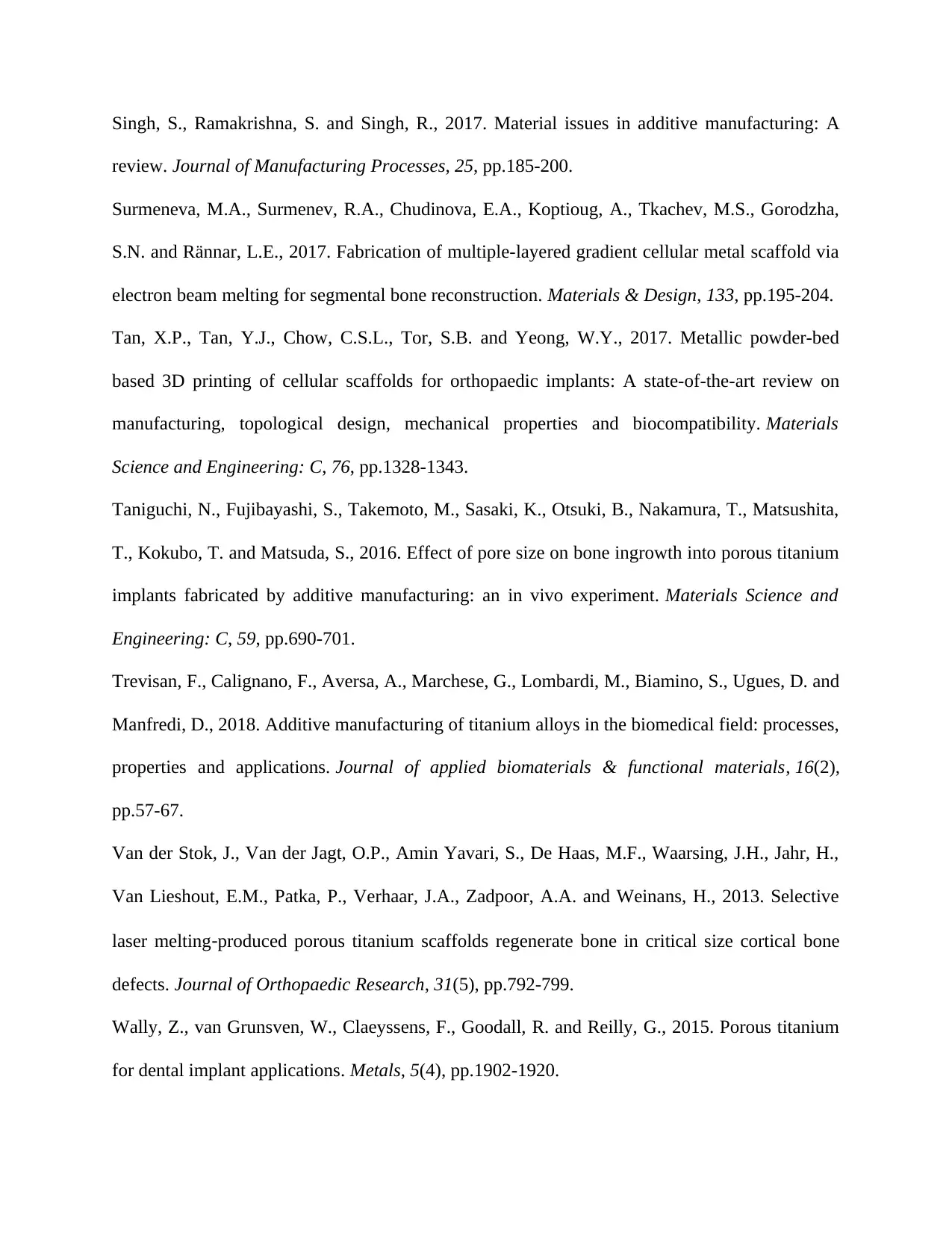
Singh, S., Ramakrishna, S. and Singh, R., 2017. Material issues in additive manufacturing: A
review. Journal of Manufacturing Processes, 25, pp.185-200.
Surmeneva, M.A., Surmenev, R.A., Chudinova, E.A., Koptioug, A., Tkachev, M.S., Gorodzha,
S.N. and Rännar, L.E., 2017. Fabrication of multiple-layered gradient cellular metal scaffold via
electron beam melting for segmental bone reconstruction. Materials & Design, 133, pp.195-204.
Tan, X.P., Tan, Y.J., Chow, C.S.L., Tor, S.B. and Yeong, W.Y., 2017. Metallic powder-bed
based 3D printing of cellular scaffolds for orthopaedic implants: A state-of-the-art review on
manufacturing, topological design, mechanical properties and biocompatibility. Materials
Science and Engineering: C, 76, pp.1328-1343.
Taniguchi, N., Fujibayashi, S., Takemoto, M., Sasaki, K., Otsuki, B., Nakamura, T., Matsushita,
T., Kokubo, T. and Matsuda, S., 2016. Effect of pore size on bone ingrowth into porous titanium
implants fabricated by additive manufacturing: an in vivo experiment. Materials Science and
Engineering: C, 59, pp.690-701.
Trevisan, F., Calignano, F., Aversa, A., Marchese, G., Lombardi, M., Biamino, S., Ugues, D. and
Manfredi, D., 2018. Additive manufacturing of titanium alloys in the biomedical field: processes,
properties and applications. Journal of applied biomaterials & functional materials, 16(2),
pp.57-67.
Van der Stok, J., Van der Jagt, O.P., Amin Yavari, S., De Haas, M.F., Waarsing, J.H., Jahr, H.,
Van Lieshout, E.M., Patka, P., Verhaar, J.A., Zadpoor, A.A. and Weinans, H., 2013. Selective
laser melting‐produced porous titanium scaffolds regenerate bone in critical size cortical bone
defects. Journal of Orthopaedic Research, 31(5), pp.792-799.
Wally, Z., van Grunsven, W., Claeyssens, F., Goodall, R. and Reilly, G., 2015. Porous titanium
for dental implant applications. Metals, 5(4), pp.1902-1920.
review. Journal of Manufacturing Processes, 25, pp.185-200.
Surmeneva, M.A., Surmenev, R.A., Chudinova, E.A., Koptioug, A., Tkachev, M.S., Gorodzha,
S.N. and Rännar, L.E., 2017. Fabrication of multiple-layered gradient cellular metal scaffold via
electron beam melting for segmental bone reconstruction. Materials & Design, 133, pp.195-204.
Tan, X.P., Tan, Y.J., Chow, C.S.L., Tor, S.B. and Yeong, W.Y., 2017. Metallic powder-bed
based 3D printing of cellular scaffolds for orthopaedic implants: A state-of-the-art review on
manufacturing, topological design, mechanical properties and biocompatibility. Materials
Science and Engineering: C, 76, pp.1328-1343.
Taniguchi, N., Fujibayashi, S., Takemoto, M., Sasaki, K., Otsuki, B., Nakamura, T., Matsushita,
T., Kokubo, T. and Matsuda, S., 2016. Effect of pore size on bone ingrowth into porous titanium
implants fabricated by additive manufacturing: an in vivo experiment. Materials Science and
Engineering: C, 59, pp.690-701.
Trevisan, F., Calignano, F., Aversa, A., Marchese, G., Lombardi, M., Biamino, S., Ugues, D. and
Manfredi, D., 2018. Additive manufacturing of titanium alloys in the biomedical field: processes,
properties and applications. Journal of applied biomaterials & functional materials, 16(2),
pp.57-67.
Van der Stok, J., Van der Jagt, O.P., Amin Yavari, S., De Haas, M.F., Waarsing, J.H., Jahr, H.,
Van Lieshout, E.M., Patka, P., Verhaar, J.A., Zadpoor, A.A. and Weinans, H., 2013. Selective
laser melting‐produced porous titanium scaffolds regenerate bone in critical size cortical bone
defects. Journal of Orthopaedic Research, 31(5), pp.792-799.
Wally, Z., van Grunsven, W., Claeyssens, F., Goodall, R. and Reilly, G., 2015. Porous titanium
for dental implant applications. Metals, 5(4), pp.1902-1920.
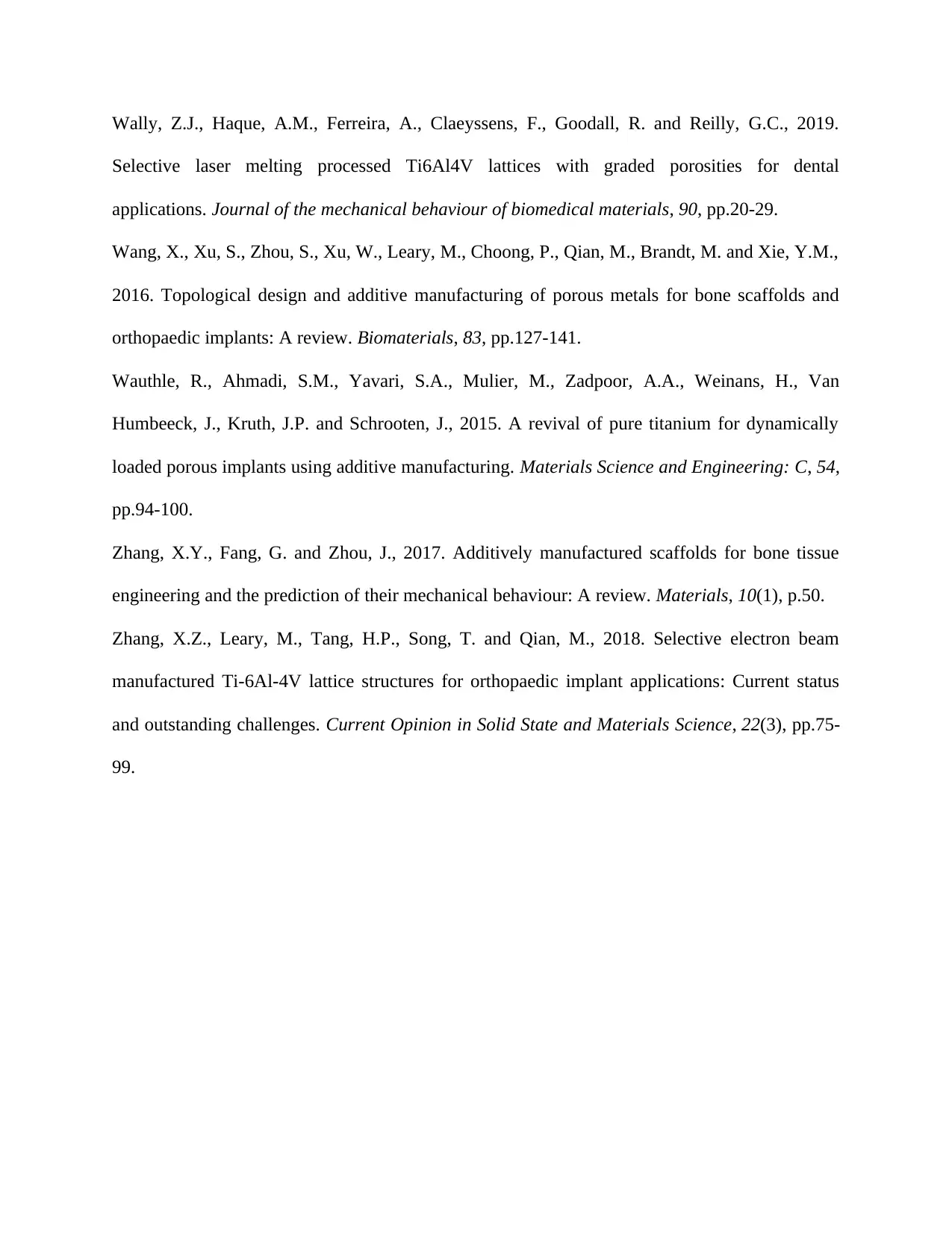
Wally, Z.J., Haque, A.M., Ferreira, A., Claeyssens, F., Goodall, R. and Reilly, G.C., 2019.
Selective laser melting processed Ti6Al4V lattices with graded porosities for dental
applications. Journal of the mechanical behaviour of biomedical materials, 90, pp.20-29.
Wang, X., Xu, S., Zhou, S., Xu, W., Leary, M., Choong, P., Qian, M., Brandt, M. and Xie, Y.M.,
2016. Topological design and additive manufacturing of porous metals for bone scaffolds and
orthopaedic implants: A review. Biomaterials, 83, pp.127-141.
Wauthle, R., Ahmadi, S.M., Yavari, S.A., Mulier, M., Zadpoor, A.A., Weinans, H., Van
Humbeeck, J., Kruth, J.P. and Schrooten, J., 2015. A revival of pure titanium for dynamically
loaded porous implants using additive manufacturing. Materials Science and Engineering: C, 54,
pp.94-100.
Zhang, X.Y., Fang, G. and Zhou, J., 2017. Additively manufactured scaffolds for bone tissue
engineering and the prediction of their mechanical behaviour: A review. Materials, 10(1), p.50.
Zhang, X.Z., Leary, M., Tang, H.P., Song, T. and Qian, M., 2018. Selective electron beam
manufactured Ti-6Al-4V lattice structures for orthopaedic implant applications: Current status
and outstanding challenges. Current Opinion in Solid State and Materials Science, 22(3), pp.75-
99.
Selective laser melting processed Ti6Al4V lattices with graded porosities for dental
applications. Journal of the mechanical behaviour of biomedical materials, 90, pp.20-29.
Wang, X., Xu, S., Zhou, S., Xu, W., Leary, M., Choong, P., Qian, M., Brandt, M. and Xie, Y.M.,
2016. Topological design and additive manufacturing of porous metals for bone scaffolds and
orthopaedic implants: A review. Biomaterials, 83, pp.127-141.
Wauthle, R., Ahmadi, S.M., Yavari, S.A., Mulier, M., Zadpoor, A.A., Weinans, H., Van
Humbeeck, J., Kruth, J.P. and Schrooten, J., 2015. A revival of pure titanium for dynamically
loaded porous implants using additive manufacturing. Materials Science and Engineering: C, 54,
pp.94-100.
Zhang, X.Y., Fang, G. and Zhou, J., 2017. Additively manufactured scaffolds for bone tissue
engineering and the prediction of their mechanical behaviour: A review. Materials, 10(1), p.50.
Zhang, X.Z., Leary, M., Tang, H.P., Song, T. and Qian, M., 2018. Selective electron beam
manufactured Ti-6Al-4V lattice structures for orthopaedic implant applications: Current status
and outstanding challenges. Current Opinion in Solid State and Materials Science, 22(3), pp.75-
99.
1 out of 37
Related Documents
Your All-in-One AI-Powered Toolkit for Academic Success.
+13062052269
info@desklib.com
Available 24*7 on WhatsApp / Email
![[object Object]](/_next/static/media/star-bottom.7253800d.svg)
Unlock your academic potential
© 2024 | Zucol Services PVT LTD | All rights reserved.



